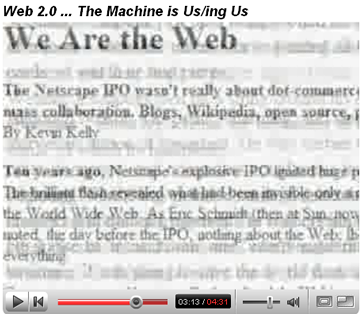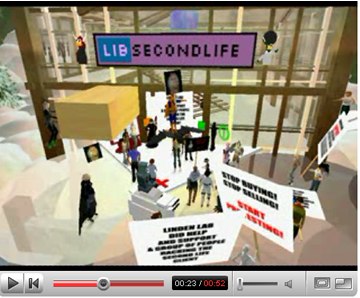July 09, 2007
CrowdSourcing Art
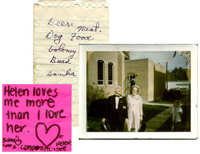
Relational Art
"Leah DeVun: You were an early advocate of crowdsourcing in the area of fine art. How did you first get involved in crowdsourcing?
Andrea Grover: Part of my interest in this is related to creating non-commodity-based artwork. I have a lot of personal affection for work from the mid-1960s and early 1970s, happenings and actions such as Gordon Matta-Clark’s Food in New York, which was in a sense a crowdsourced work -- an artist-run establishment where everything, from the cooking to the eating, was a part of the artwork. I also have a lot of fondness for early video collectives like Top Value Television, Videofreex, and Raindance. Video cameras and editing equipment were so cost-prohibitive that the only way to make a work was to do it collectively. So my interests in what’s happening now are to some extent born out of the socially-driven, collaborative works from that period. I first found the term “crowdsourcing” in Jeff Howe’s article in Wired in 2006. I think it gave people language to talk about something that they were seeing but didn’t really have a word for. I think one of the original terms people were using was “relational art” – in other words, crowdsourcing is a new term to describe something that already existed before the term was in common use, but the word gave people something to organize around, and it gave some shape to newer trends." Read the full interview here.
Posted by jo at 07:49 PM | Comments (0)
July 06, 2007
[iDC] City as Social Network: Eric Gordon
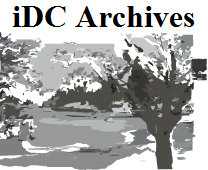
Participation Equals Surveillance
Hi everyone. My name is Eric Gordon – I’ve been watching this list for some time but I’ve made only a few contributions. Perhaps as a means of forcing my involvement, Trebor has asked me to moderate a discussion on the topic that has lately occupied most of my time – place-based social media and its implications for privacy, public space, and democratic engagement.
Following the recent conversation about Feedburner, I want to consider how that discussion might extend to physical communities (neighborhood, organization, city) that are enabled / bolstered / fortified by social web media. Many community groups and neighborhood organizations are using digital networking technologies to foster community interaction (http://www.ibrattleboro.com/). And of course, what is widely known as citizen journalism plays into this as well – placebloggers and Community Media organizations tend towards hyperlocal networked content (http://www.cctvcambridge.org/) with an aim towards reinforcing existing geographical connections.
The processes that bind non-geographical communities in networks are similar to those that are binding geographical communities – shared interests, practices, goals, etc. However, unlike traditional online communities that have a basis in anonymity, digitally annotated physical communities often rely on the full disclosure of identity for their functionality. For instance, when it comes to neighborhood issues – it is important to know one’s real name and location.
And as city governments are seeking ways to adopt “web 2.0” technologies into their existing “citizen management” projects, the lack of anonymity and the simple traceability of social actions open up new concerns. Social media tools have the capacity to significantly expand participation in local governance, but they also have the capacity to trace citizen behavior and map social trends. Cities are interested in this technology for the same reason that corporations are – it offers valuable user data. Politicians can survey the concerns of their constituency; agencies can identify problems in neighborhoods; and law enforcement…well, there are many scenarios possible. It can also be turned around: citizens can have greater access to their politicians, and government proceedings can at least have the impression of transparency.
While the conversations on this list have devoted considerable time to corporate surveillance, the question not often asked in this context is what should be made of local surveillance – from the people in one’s neighborhood to city governments? In the wake of connectivity, discourse and collaboration, there is always documentation, processing and interpretation. From neighborhood chatrooms to local annotated mapping projects to virtual town hall meetings, participation equals surveillance – for better or for worse.
When I consider a digital future in which I want to live – it includes networked access to my neighborhood services, communities, city government and public spaces. However, there is little possibility for that to take place outside of the proliferation of data that would make communities vulnerable to excessive internal and external management. And as citywide wifi and mobile web devices proliferate, the outlets for that recycled data expand. At the same time, American cities, like corporations, are glomming onto digital media because of its populist resonances. They are paying attention to online neighborhoods and seeking to aggregate that data into meaningful information. The ideology of digital media – as evidenced in the phrases “participatory media” and “user-generated content” – is accessibility. Digital media directly aligns the rhetoric of progress with the rhetoric of populism. Social web media makes explicit what has only been implied in the recent rhetoric of city governments – that anyone, regardless of social position, can participate in the ordering of city experience and politics.
From cities to towns to neighborhoods, the populist promise of social web media is transforming the nature of public space and civic participation. I am referring only to the American context, because that’s what I know, but it would be great to engage in comparative dialogue in order to better understand the scope of how these technologies are being implemented in official or unofficial capacities to change perceptions of cities and city life, not to mention public space and community engagement.
I suppose I’ll leave it at that for now. I look forward to the conversation.
Eric
iDC -- mailing list of the Institute for Distributed Creativity iDC[at]mailman.thing.net http://mailman.thing.net/cgi-bin/mailman/listinfo/idc
List Archive:
http://mailman.thing.net/pipermail/idc/
iDC Photo Stream:
http://www.flickr.com/photos/tags/idcnetwork/
Posted by jo at 11:13 AM | Comments (0)
July 05, 2007
White Glove Tracking

"...Michael Jackson-watching, with Entertaining Results"
"The White Glove Tracking project was created by Evan Roth and Ben Engebreth, with the backing of the art-and-technology groups Rhizome and Eyebeam. Web-surfing volunteers were invited to view frames of Michael Jackson's legendary performance of "Billie Jean" on a 1983 television special and pinpoint the location of Mr. Jackson's white glove.
The glove trackers tackled the job just for fun, finishing the job in 72 hours back in May thanks to a surge of traffic from Digg and other sites. The data they produced is now available online and has already been put to some highly creative uses. My favorite is this clip by Zach Lieberman, in which the "Billie Jean" video has been automatically cropped to focus obsessively on the glove. The result is something like watching "The Glove, Live on Stage, Wearing Michael Jackson." (Frames with no glove, like those at the beginning, are black.)" From Tracking Michael Jackson's Glove Online: A research project roped thousands of volunteers into some Michael Jackson-watching, with entertaining results, by David F. Gallagher, Bits (NY Times blog)
Posted by jo at 01:21 PM | Comments (0)
July 03, 2007
[iDC] From a Crisis of Value to a Crisis of Accumulation
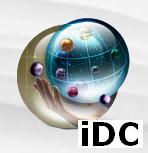
Questions of Value and Ethics
[...] Excerpt: The Impending Crisis of Value [by Adam Arvidsson] - It is becoming ever more obvious, as even the mainstream business press is acknowledging this, that the information economy is split in two; we have two economies rather than one (or three, if we include the growing criminal or informal economy which we will not treat in this paper). On the one hand, there is the traditional capitalist economy that works with monetary incentives. This economy still handles the main part of material production: the production of cars, shoes, computer chips, and the transportation and maintenance of these goods. But immaterial production- the production of the ideas, innovations, experiences and other intangibles that virtually everybody agrees to be the most important source of value and development- is increasingly performed by another economy that does not primarily move according to monetary incentives. Most people who participate in creating the enormous wealth of content that give MySpace or YouTube their market values are not in it for the money. Instead they want to build networks, make friends, show off, be cool or what have you. The same thing goes for the users who participate in the multitude of smaller, less famous sites that make up the new productive developments known as Web 2.0. ..." Read the essay here.
Michel Bauwens' response: http://www.p2pfoundation.net/Dornbirn_Manifesto
Also see Toward an Ethics of the Sociable Web. A Conversation Between Trebor Scholz and Mark Deuze.
iDC -- mailing list of the Institute for Distributed Creativity iDC[at]mailman.thing.net http://mailman.thing.net/cgi-bin/mailman/listinfo/idc
List Archive:
http://mailman.thing.net/pipermail/idc/
iDC Photo Stream:
http://www.flickr.com/photos/tags/idcnetwork/
Posted by jo at 10:53 AM | Comments (0)
June 29, 2007
A Virtually New Web
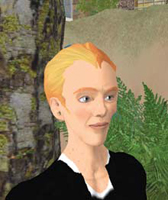
"Anarchic Openness" Reaps Massive Results
Jason Pontin, Technology Review's editor in chief, introduces and reflects on "Second Earth," the piece by contributing editor Wade Roush that is the July/August issue of the magazine's cover story in this video. Pontin argues that the extraordinary success of virtual worlds, such as Linden Lab's Second Life, and mirror worlds, such as Google Earth, can only partly be explained by new technologies including cheaper bandwidth, graphics cards, and free storage. Much more important was the decision of Linden Lab and Google to support an anarchic openness within their cyberworlds. Both companies have turned over control to users: any user can add almost anything to either environment. This decision has made Second Life and Google Earth into collaborative social communities with millions of registered users. [via]
Posted by jo at 03:24 PM | Comments (0)
Britannica vs Wikipedia

Michael Gorman + danah boyd
"Perhaps this view of an emerging collective human consciousness is ... if it is put forward seriously, it is antihuman and intellectually debasing. The structures of scholarship and learning are based on respect for individuality and the authentic expression of individual personalities. The person who creates knowledge or literature matters as much as the knowledge or the literature itself ... An encyclopedia (literally, the “circle of learning”) is the product of many minds. It is not the product of a collective mind. It is an assemblage of texts that have been written by people with credentials and expertise and that have been edited, verified, and supplied with a scholarly apparatus enabling the user to locate desired knowledge. It differs in almost all relevant particulars from one of the current manifestations of the flight from expertise—Wikipedia, which bills itself as “the free encyclopedia that anyone can edit” and to which everyone can contribute irrespective of whether they possess, or simply pretend to possess, credentials and expertise..." Web 2.0: The Sleep of Reason, Part II by Michael Gorman, Britannica Blog.
" ... The Internet - and Wikipedia - change the rules for distribution and production ... It means that individuals who know something can easily share it, even when they are not formally declared as experts. It means that those with editing skills can help the information become accessible, even if they only edit occasionally. It means that multi-lingual individuals can help get information to people who speak languages that publishers do not consider worth their time. It means that anyone with an Internet connection can get access to information traditionally locked behind the gates of institutions (and currently locked in digital vaults).
Don’t get me wrong - Wikipedia is not perfect. But why do purported experts spend so much time arguing against it rather than helping make it a better resource? ... While there are certainly errors there, imagine what would happen if all of those who view themselves as experts took the time to make certain that the greatest and most broad-reaching resource was as accurate as possible ... Why are we telling our students not to use Wikipedia rather than educating them about how Wikipedia works? Sitting in front of us is an ideal opportunity to talk about how knowledge is produced, how information is disseminated, how ideas are shared ...
The society that (Dr. Gorman) laments has lost faith in the public good ... Wikipedia is a public-good project. It is the belief that division of labor has value and that everyone has something to contribute, if only a spelling correction. It is the belief that all people have the inalienable right to knowledge, not just those who have academic chairs. It is the belief that the powerful have no right to hoard the knowledge. And it is the belief that people can and should collectively help others gain access to information and knowledge." Knowledge Access as a Public Good by danah boyd.
Posted by jo at 02:17 PM | Comments (0)
June 26, 2007
Movie Cards
Movie Cards is a unique workshop project by MIYABARA Mika and SUGIMOTO Tatsuo. They are interested in the generation of a creative community and the relationship between society and media. At the workshop, every participant is able to edit video easily. The system consists of the real cards made of paper. Each card is represented of a piece of video scene. Participants could get the way of thinking creative and critical through the process of making video with others. The finished moving images would be a new alternative independent media. It is a simple video editing tool and no need of any technical knowledges. It is useful for understanding and learning the expression of moving images. It can be use for media study class. Students will become conscious of the force and effect of editing. They could understand daily visual media are edited with someone's intention. Moving image media are daily thing. But we can access them as only viewing. It was one-sided relationship. Now, we can really make moving images and become a alternative filmmaker. [via mediateletipos]
Posted by jo at 11:42 AM | Comments (0)
June 23, 2007
OurSpace
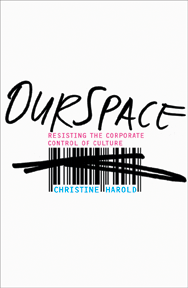
Resisting the Corporate Control of Culture
OurSpace: Resisting the Corporate Control of Culture by Christine Harold: When reporters asked about the Bush administration’s timing in making their case for the Iraq war, then Chief of Staff Andrew Card responded that “from an marketing point of view, you don’t introduce new products in August.” While surprising only in its candor, this statement signified the extent to which consumer culture has pervaded every aspect of life. For those troubled by the long reach of the marketplace, resistance can seem futile. However, a new generation of progressive activists has begun to combat the media supremacy of multinational corporations by using the very tools and techniques employed by their adversaries.
In OurSpace, Christine Harold examines the deployment and limitations of “culture jamming” by activists. These techniques defy repressive corporate culture through parodies, hoaxes, and pranks. Among the examples of sabotage she analyzes are the magazine Adbusters’ spoofs of familiar ads and the Yes Men’s impersonations of company spokespersons.
While these strategies are appealing, Harold argues that they are severely limited in their ability to challenge capitalism. Indeed, many of these tactics have already been appropriated by corporate marketers to create an aura of authenticity and to sell even more products. For Harold, it is a different type of opposition that offers a genuine alternative to corporate consumerism. Exploring the revolutionary Creative Commons movement, copyleft, and open source technology, she advocates a more inclusive approach to intellectual property that invites innovation and wider participation in the creative process.
From switching the digital voice boxes of Barbie dolls and G.I. Joe action figures to inserting the silhouetted image of Abu Ghraib’s iconic hooded and wired victim into Apple’s iPod ads, high-profile instances of anticorporate activism over the past decade have challenged, but not toppled, corporate media domination. OurSpace makes the case for a provocative new approach by co-opting the logic of capitalism itself.
Christine Harold is assistant professor of speech communication at the University of Georgia.
Please contribute your thoughts, links, ideas, oppositions, and provocations to the new OurSpace wiki.
Posted by jo at 11:28 AM | Comments (0)
June 22, 2007
Canal Street Station

Participatory Public Pay Phone Who-Dunnit
31 Down's interactive telephone mystery Canal Street Station runs through October 31, 2007. To play, call this toll-free number from a pay phone inside the station: 1-877-OR-WHAT-31 (1-877-679-4283). Note: This mystery takes place on the N, Q, R, W, 6, and J, M, Z platforms, not the A, C, E, station.
Canal Street Station is a free public media art installation set in the Canal Street Subway Station in New York City. Participants are invited to make a toll-free call from any public payphone in the Canal Street station (inside of the turnstyles). Participants will then be guided on a pay phone mystery. The game takes approximately 45 minutes to complete.
Tajna Tanovic stars in this public pay phone who-dunnit set in the maze of tiles that make up the Canal Street Subway Station. This is an interactive piece that challenges participants to test their skills at listening and following directions. Players are put in the shoes of Mike Sharpie, private investigator, as he searches the depths of Canal Street Station for a young French woman that may have committed a murder, or may be a figment of Mike's wandering imagination.
"Canal Street Station" is co-produced by 31 Down radio theater and free103point9 and presented by free103point9 as part of the transmission arts non-profit's Tenth Anniversary celebration. Created by: Ryan Holsopple, Shannon Sindelar, Mirit Tal, and Tanja Tanovic.
Posted by newradio at 10:44 AM | Comments (0)
June 01, 2007
UNIQLO MIXPLAY
Go here to mix your own dance and sound.
Posted by jo at 05:47 PM | Comments (0)
Anne Galloway
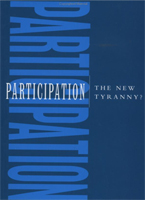
MediaShed +
A COUPLE OF PROJECTS MENTIONED IN ANNE'S POST: Participation: The New Tyranny?, edited by Bill Cooke and Uma Kothari, is about participatory development‘s potential for tyranny, showing how it can lead to the unjust and illegitimate exercise of power. It is the first book-length treatment to address the gulf between the almost universally fashionable rhetoric of participation, which promises empowerment and appropriate development on the one hand, and what actually happens when consultants and activists promote and practise participatory development, on the other.
The contributors, all social scientists and development specialists, come from various disciplines and a wide variety of hands on experience. Their aim is to provide a sharp contrast to the seductive claims of participation, and to warn its advocates of the pitfalls and limitations of participatory development. The book also challenges participatory practitioners and theorists to reassess their own role in promoting a set of practiCes which are at best naïve about questions of power, and at worst serve to systemically reinforce, rather than overthrow, existing inequalities.
For the recipients of participatory development this book provides critical insights into the history, the institutions, and the day to day activities through which participation is done to them. It provides them with a range of arguments which support the legitimate decision not to participate on others‘ terms, and also with grounds to oppose or negotiate the intervention of participatory development in their lives.
Some contributions in this book seek to learn the lessons of particular examples of failed participatory practiCe. Others present more conceptually oriented analyses, many of which go beyond those conventionally associated with development studies. Together they provide a more rigorous and provocative understanding of participatory development than has hitherto been available, which donors, academics and practitioners will find hard to ignore.
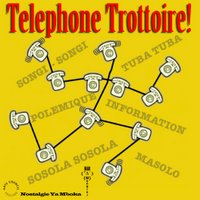
"The aim of the Telephone Trottoire project is to engage the London based Congolese community in issues that affect their day-to-day lives. 'Telephone Trottoire' is based on a new form of 'contagious' telephone application developed by Mongrel and named after the Congolese practice of 'pavement radio' or the passing around of news and gossip between individuals on street corners. In Central Africa people defy media censorship by sharing news and gossip using 'radio trottoire' or 'pavement radio'. Built in collaboration with the radio programmes 'Nostalgie Ya Mboka' and 'Londres Na Biso', 'Telephone Trottoire' encourages London's Congolese community to pass around news stories and discuss them using a unique system of sharing content over the phone. The project engages the Congolese community on their own terms by using systems that draw from their own culture, beliefs and folklore – some stories are intended to provoke, some to entertain and some to educate. All allow listeners to record their own comments and pass the call on to a friend or family member by entering their phone number. Some are true and some are false – after all isn’t this all about gossip – the 'Telephone Trottoire'?"
Posted by jo at 05:11 PM | Comments (0)
May 29, 2007
For any reason or no reason

on virtual (extra-)territoriality
"Second Life is an exciting development of the virtual world. A country that wishes to show that it at least has the ambition to be at the forefront of development of course has to be in it." [1] Swedish minister of foreign affairs, Carl Bildt
The 30th of May, Sweden will be the first country in the world to open an official Embassy within Second Life, the online 3D multi user environment owned by Linden Lab. The project is initiated by the Swedish Institute [2] (a culture and marketing department of the Swedish ministry of foreign affairs, and according to the official blog even Sweden's "road warrior for peace" the minister of foreign affairs as well as former head of state, Carl Bildt, himself will attend the opening [3]. But what happens when a specific mode of representation is transferred to a new context? In this case a building for bilateral governmental representation is transferred to a private corporation.
I'll use the Embassy in Second Life as a case study of mediation between global web-based corporations and the notion of participation in a time where privatized service platforms are becoming a standard that most people (in this case even states!) uncritically are subscribing to.
My starting point will be an examination of the embassy and its representation, from an architectural perspective in relation to the Swedish Government's Politics of Architecture on state representation as well as from the point of view of the conflict between conventions of diplomatic missions and the terms of use regulating the virtual world.
P o l i t i c s o n r e p r e s e n t a t i o n
According to the Vienna Conventions on Diplomatic Missions from 1961 embassies are established on mutual consent [4]. The function of an embassy is to represent one state in another state by negotiation between governments and protecting the interests of the sending state and its inhabitants within the receiving state [5]. This is achieved through reporting on the conditions and the development of the receiving State to the sending State and by creating friendly relations and developing the two States economic, cultural and scientific relations [6].
In 1998 the Swedish government adopted a new policy on architecture politics [7]. The Proposition was the first initiative to establish a politics of architecture with an integrated plan and law on architecture, crafts and design. The changes touched on a variety of levels from the establishment of infrastructure, to city planning and individual buildings.Basically this meant the addition of strings such as 'aesthetically shaped' and 'should be aimed' into the existing laws [8]. One chapter, though concerned the representation of the public sphere and the state, "Public Sphere as Exemplary - the State as Exemplary" [9], focusing on the importance of confirming the role of the State through its representation. This also concerned embassies, which are representations of the State in other States. The new architecture politics added a new aspect to the embassy. It was not enough to be an institution with the main function to represent the State, now the institution itself (including its own representation) had to be representative of the State - the representation of the representation became representative. In this way a Swedish Embassy would have to architecturally express what Sweden stands for [10]- or at least what Sweden would like itself to stand for.
A H o u s e o f S w e d e n
The virtual embassy in Second Life will be a copy [11] of a real world embassy: The House of Sweden, situated in central Washington DC next to a big park and a river. The embassy was developed as a consequence of the new politics on architecture. A competition was announced by the Swedish National Property Board (SVF) in 2002 and the winning proposal, designed by Gert Wingårdh and Thomas Hansen opened 2006 [12].
House of Sweden is a concept developed in collaboration between the Swedish National Property Board and the Swedish Ministry of Foreign Affairs [13]. The house is a conglomerate that besides the actual embassy consists of corporate apartments for the business industry and an event center with conference rooms and exhibition space.
The building stands as a postmodern paraphrase of Scandinavian modernism. It is a wooden glasshouse. Its facades consist of backlit opaque glass with printed patterns of pressed wood and the interior a romantic/nostalgic choice of materials associated with Swedish nature and traditional Swedish craft like wood, granite and water [14]. The reception desk is made of glass and a massive wooden door is opened whenever the embassy is open for visitors [15]. Also it is possible for 'anyone' [16] to rent the exhibition center and the conference rooms of the house for events. As House of Sweden describes themselves in a pamphlet with information about the building: "Some have said that this type of open embassy is what the Americans themselves should build, but cannot. [...] modern American embassies are instead usually large, closed-off buildings located a safe distance from everything else. Despite its openness, the House of Sweden has the same level of security as other Swedish embassies, neither lower nor higher." [17] - Open and relaxed, though under control. This is the House of Sweden, the building as well as the concept marks itself in opposition to the traditional embassy with openness, relaxation space and an interweaving of the arts and the business world. Although it is obvious the art is but a layer of the design branding the concept of Sweden and the business environment. As a matter of fact even the diplomatic mission itself seems to be there, in order to brand the corporate apartments which take up most of the space in the whole building [18], with apartments at the size of 70-250 m2 and a rent of 40-60 USD/m2. The renters include Volvo group, Saab and Lars Thunell, the vice president of World Bank [19]. A Swedish embassy's original function was to take care of governmental negotiations, official representation and the protection of Swedish people and their interests within the USA. House of Sweden mirrors a shift in the role of diplomatic missions, where the new embassy is rather an official high end 'tourist bureau'. It serves the function of an exclusive promotion platform - a show room for the darlings of the Swedish business industry.
A S e c o n d H o u s e o f S w e d e n
The original embassy is designed for the human scale in relation to the use of the building, the surroundings, the economical framework and the politics of cultural representation. The final layout of the floor plans and the materiality of the house reflect these conditions [20]: office spaces are situated along glass facades in order for people to enjoy the view of the park and the river, interior stairs are covered with sound absorbent maple [21], elevators are integrated for disabled people and things to move unhindered between the floors, and the exhibition space is especially designed so that big vehicles are able to enter when setting up a new exhibition [22]. In this way the entire building may be seen as a narrative product of human scale and experience interweaved with the above mentioned factors.
By shifting the medium or context from the real world to a 3d simulated environment presented on a computer screen the elements are changing. Even though the user is represented by a (if she wishes humanlike) figure - the avatar, any navigation within the environment is reduced to the four arrow-keys on the computer's keyboard and the world is experienced through the screen with the image of one's avatar's neck in the foreground [23]. One perceives the environment in layers of resolution according to the graphic card and the capacity of the processor of the computer that is being used. Patterns of movements are radically different. The avatar itself doesn't get exhausted, it is rather like a goal-less torpedo in constant pace as long as the arrow-key is pressed down, it is only when the user behind the screen gets tired that it stops and 'falls a sleep'. This makes the planning of experience within the virtual embassy rather different than from its real-world model. In the real House of Sweden, breaks and pauses are implemented in the house according to the function. An example is the sculpture of running water greeting you as you exit the conference space [24], placed there in order to somehow refresh your mind. In Second Life it is not the avatar who would be tired or need a break after a long seminar, but rather the user behind the screen and keyboard. An equivalent break could therefore be an interruption, letting the screen go black and thereby forcing the user to shift perspective from second to first life.
Compared to traditional closed off and mono functional embassies the "real" Swedish embassy in Washington DC surprises at a first glance by its openness allowing new activities to unfold within the house and by being a glass house [25]. The glass house has a strong tradition in modernism. It is an almost supposedly invisible trespass between the outside and the inside. On the one hand it is a monument of building technology's victory over nature's forces and modernism's reaction against Victorian style, but on the other hand it is also implementing an openness that paradoxically signifies control and surveillance. The glass house offers the insider visual access and to a certain degree the illusion of being part of the outside while at the same time being protected from it. It gives the outsider visual access to the inside, stating: "there is nothing to hide here". Using the representation of glass in a virtual world though, is merely pointless. In a virtual world there is no difference between interior and exterior. One needs no protection from any weather situation or nature forces and intrusion is not about closing the access by building a wall or a window, but rather to alter and implement the security into the code behind the representation. As a matter of fact this is very easy in Second Life: Different security options are incorporated into the 'land'. The land owner is able to decide which level of security is active on her property,for instance making it possible for the avatars to 'die', denying other users to build or move objects on the property, or denying any access to the property without permission. So if the owner i.e. wishes to give other users only visual access to at part of her property she doesn't need to build any transparent simulation of glass, but can implement this in the code. A glass building in a 3d world is rather clumsy and annoying: when trying to navigate through it and accessing visible things, you constantly bump into the transparent walls.
One aspect of the original House of Sweden which might have a chance to be more successful in a 3D online environment is concept of making the embassy a platform for different events and activities. This might be a case where the virtual world has an advantage since it overcomes the difference of time-space in information technology by allowing users who are spatially separated to experience the same environment together in real-time. In Second Life most places give an impression of being empty, but by establishing in-world events this is exactly what the Swedish institute wants to avoid [26]. It is worth noting though that the emptiness in Second Life is not only due to a lack of visitors, but rather is connected to the scale of the 3d environment and its relation to the capacity of the servers. Due to server restrictions it is only possible to be 40 people at a time on each island [27]. House of Sweden in Washington DC is 7500 m2 large. The rooftop terrace alone is built to host 200 people at a time - just for a cocktail party [28]. The diplomatic activities takes up 30% of the spatial area of the house which has 50 people are working there daily[29]. But considering the fact that only 40 people is capable of accessing the whole island at a time, all of the employees wouldn't even be able to meet in the virtual embassy. No wonder why SL feels like suburbia - it is suburbia. The low density is exactly the same problem that suburbs are struggling with. Considering the scale of the building, no matter how many events they make the embassy will always feel empty until a solution is found for increasing the capacity of the servers and thereby making it possible for more people to access it at the same time.
T h e D i p l o m a t i c B a g m a y n o t b e o p e n e d
"The premises of the mission" are, according to article 1 of the conventions of Diplomatic Missions" the buildings or parts of buildings and the land ancillary thereto, irrespective of ownership, used for the purposes of the mission including the residence of the head of the mission" [30]. The actual premises of the Swedish mission in Second Life will be a chunk of data stored on Linden Lab's servers. The servers are computers physically placed in the state of California, USA [31]. Visitors of the embassy will be able to access the premises of the Swedish mission, the data on the servers via a viewer (also called the client). This is a piece of software that the users download and install on their own computers enabling them to access data on Linden Lab's servers real time together with other users, and thereby accessing the virtual diplomatic mission and the rest of Second Life. But in order to access any aspect of Linden Lab's Second Life the user has to agree with the terms of service [32] - a virtual layer to the virtual world.
Second Life's Terms of Service consists of a 7000 words document presented to the users as a click and agree contract after having downloaded and installed the viewer and just before accessing the service for the first time. The contract is un-negotiable. If you disagree with parts of the terms you'll have to disagree with all by clicking disagree at the end of the document. This in return means that you are not allowed to enter the service at all. The code behind the world is generating the environment, setting the parameters for it and thus being the world. While the Terms of Service rather is a regulative framework defining what-could-be or what-shouldn't-be, thus governing the company in order not to be able to hold it responsible for anything that might occur within its framework and giving it absolute control of in-world decisions [33]. This is not necessarily to be understood as a police state which wants to keep the control by controlling anybody anytime. The control is rather latent 'in-case-of' control, where the company in case something unexpected happens can wash its hands saying "Oh, no! This is not our responsibility" or "This was not our intention." The Terms of Service text is dense, the document would take an average reader about 35 minutes to read [34], which makes most people skip reading and just agree in order to access the service immediately. General Director of the Swedish Institute, Olle Wästberg describes his idea of establishing the embassy in Second Life as the following: "I got myself a user account, this avatar as it is called and logged in and it seemed to be a good marked place for us. In collaboration with the ministry of foreign affairs we have now decided to open an embassy" [35]. In the process of logging in Olle Wästberg properly skipped reading the terms of service, because if he would have read them he would have been aware that agreeing with the terms of service is to violate the Vienna Conventions of Diplomatic Missions and thus making it impossible to establish any embassy whatsoever in Second Life.
There are three aspects of the Conventions for Diplomatic Missions which are violated by Second Life's Terms of Service: (i) the first regards the inviolability of the Diplomatic Mission itself, (ii) the second is the inviolability of the premises of the Mission including its property, furniture, archives and documents and (iii) the last concerns the inviolability of Diplomatic Agents.
(i) A Diplomatic Mission is inviolable [36]. It means that the receiving state is not allowed to enter the embassy without permission. The receiving state is even obliged to protect the embassy as best as it can. But in Second Life any kind of data stored on Linden Lab's servers (for instance the embassy itself, accumulated items like Linden dollars, content, scripts, objects, account history or account names) are subject to deletion or alteration at any time for any reason or even without a reason in the sole discretion of Linden Lab [37].
(ii) Premises of a Mission are "immune from search, requisition, attachment or execution" [38]. But in Second Life the user must authorize Linden Lab to disclose any kind of information the corporation finds "appropriate to investigate"[39] to "private entities, law enforcement agencies or government officials"[40] Furthermore Linden Lab has the right to follow, track and record any of the user's activities within the service [41] this includes activities taking place within the premises of the virtual embassy.
(iii) "The person of a diplomatic agent shall be inviolable. He shall not be liable to any form of arrest or detention. The receiving State shall treat him with due respect and shall take all appropriate steps to prevent any attack on his person, freedom or dignity[42]." In Second Life the user is represented by an account name. It is the name of the character that represents the user and whereas the character itself can be changed and remodeled immensely the account name is static. The account name is equivalent to the representation of a diplomatic agent, and "Linden Lab reserves the right to delete or change any Account Name for any reason or no reason." [43]
By being located within the Linden Lab Corporation the Swedish embassy in Second Life is subordinate to the terms of service conducted by Linden Lab and thus breaking with the conventions related to diplomatic missions. This is recursive since any future visitor of the embassy will be forced to do the same[44]. In this way the notion of participation in this kind of virtual world is uncritically accepted and without getting acquainted with the conditions that the users are agreeing with in order to be allowed to participate. There is no consular service provided at the embassy in Second Life, instead it will link to 'real' web-sites where you can get info about how to obtain visa etc. But why do the users need to access second life and subscribe to the terms of service in order to exit Second Life to get the information that the virtual embassy provides?!
F o r a n y r e a s o n o r n o r e a s o n ?
In order "to make sure it [edit: the virtual Swedish Embassy] exudes "Swedishness" [45] the Swedish Institute has hired the design bureau Söderberg A/S to manage the layout of the virtual copy of House of Sweden and its surroundings in Second Life. But is it really possible for a design bureau "to manage the overall look and feel of the sim (or "island")" [46] for it to signify Swedishness? According to the architecture politics the answer seems to be yes, and the initiators are obviously thinking of the look of the Swedish nature. But is Swedishness only a semiotic layer wrapping up the structures by making a realistic simulation of the Swedish landscape? Doesn't the representation go beyond the aesthetical layer and isn't it rather a matter of inscription into context? Let me give an example: In the official announcement the Swedish Institute is motivating the set-up of the virtual embassy by the following:"Reaching out internationally, to an increasingly selective crowd, calls for an inventive and progressive way of working with communication. It is of great importance that we find our target groups where they are most likely to be open to our information, in their own context." [47] But it is certainly difficult to imagine the Swedish government approving any kind of set-up of an embassy within a real world private corporation - a Disney-like amusement park, no matter how well any designers would have managed to give it an overall look and feel of "Swedishness", or no matter how good a market any Disney world whatsoever would be for targeting progressive individuals where they are most likely to be open for Sweden's promotion.
It is obvious that the Swedish Institute is not familiar with the structures they are inserting the virtual embassy into. At the official announcement at their web-page the description of Second Life says: "Second Life is a 3-D virtual world and is built and owned by its residents." [48] It is an exact copy of how Linden Lab describes themselves in "What is Second Life?" [49] on their webpage. But as we have already seen Second Life is not owned by its inhabitants. It is a private space owned by the corporation Linden Lab. The users are able to create content with reserved intellectual property rights within the environment, but any content stored on Linden Labs servers (which every part of the users environment are) are according to the terms of service owned by Linden Lab and subject to deletion. The empty phrase is adopted by the Swedish Institute without reflection. The establishing of a diplomatic mission in Second Life is a continuation of the pattern that the House of Sweden already is a part of - an embassy as a show case for the Swedish brand, the nation state in competition with global corporations. So far Second Life has been the arena of big global corporations as MTV, NIKE, Reuters, but now the state is trying to compete with the corporations as if it itself was a corporation - a brand. From August 2006 to January 2007 the media coverage related to Second Life had increased by "nearly 150%" [50] and when the Swedish Institute in the end of January announced their intentions of opening the virtual embassy they immediately got worldwide media coverage everywhere, from BBC News to India news [51]. But the Swedish Embassy in Second Life is a media stunt with very little critical reflection behind it. Eventually the Swedish Institute is surfing waves of a media attention, which finally most of all is branding Second Life itself.
A kind of excuse for this argument is be found on the blog of Second House of Sweden where Stefan Greens writes: "Ironically, once concern we had was that the decision to go ahead with the project amid the hype might make it look like we were taken in by the hype, when in fact we were going in despite the hype, because we felt we really wanted to figure out now how to use virtual worlds as a place to tell people about Sweden." [52] Virtual worlds have been around for more than 15 years. Already 7 years ago the environment Online Traveler had sound [53], an aspect which Linden Lab is just now trying to develop. If the Swedish Institute was interested in using virtual worlds and had decided to take a political stand point with an awareness of the user's position within these worlds, a non-profit open source version as for instance Croquet [54] would have been an obvious choice. Of course there would not be so many users or so much hype around it, but maybe Sweden could have started a discussion related to the public sphere of information technology. However there is no reason for establishing embassies in an open source network.
A b r i d g e d s o f a r
Second Life is a centralized structure. It is a closed network of servers all under the domain of Linden Lab, much like a state. Second Life and Sweden are separated entities. The usual way for a state to establish relations with another state is for the sending state to create a representation of itself within the otherness of the receiving state - the embassy. But in an open source structure where the servers are connected in a distributed network it would not be necessary for Sweden to enter this otherness and establish a representation there, rather it could create its own server, with its own set of rules interlinked with the other servers - much as a country, but not as an embassy.
Now is a time where standards are introduced, people are inhabiting the net. This should be done not by establishing embassies, but through critical discussion and reflection on and understanding of the public sphere which is possible within the information structures. A sphere which is being hi-jacked by private corporations without anybody noticing. The Sweden which eventually will be represented in Second Life is a state where all critical reflection is put aside on the behalf of elevating Sweden's profile - and no matter how well designed it might be, it is but a brand lacking any content - - since the representation is not representing any thing but the representation itself.
Linda Hilfling - MA Media Design Student Piet Zwart Institute , Rotterdam, May 2007
R e f e r e n c e s:
[1] From Carl Bildt's personal blog from the 30th of January 2007. The blog entry was Bildt's response after for the first time acquiring the news about the Swedish embassy in Second Life via a BBC-news article. The entry is called 'Heja Olle Wästberg" and is aimed at the director of the Swedish institute Olle Wästberg: http://carlbildt.wordpress.com/2007/01/30/heja-olle-wastberg/ [my translation from Swedish]
[2] Official announcement by the Swedish Institute, Jan 2007:
http://www.si.se/templates/CommonPage____3052.aspx
[3]
http://secondhouseofsweden.com/2007/05/20/may-30-is-launch-day-for-the-second-house-of-sweden/
[4] Article 2, Vienna Conventions on Diplomatic Missions, 1961: http://untreaty.un.org/ilc/texts/instruments/english/conventions/9_1_1961.pdf
[5] Article 3.1a; 3.1b; 3.1c - Vienna Conventions on Diplomatic Missions,
1961: http://untreaty.un.org/ilc/texts/instruments/english/conventions/9_1_1961.pdf
[6] Article 3.1d; 3.1e, Vienna Conventions on Diplomatic Missions, 1961: http://untreaty.un.org/ilc/texts/instruments/english/conventions/9_1_1961.pdf
[7] Handlingsprogram för arkitektur, formgivning och design: http://www.regeringen.se/content/1/c4/25/65/e36cce6d.pdf
[8] Suggestions to alterations of existing laws Framtidsformer - Handlingsprogram för arkitektur, formgivning och design, pp 5-9 http://www.regeringen.se/content/1/c4/25/65/e36cce6d.pdf
[9] "Offentligt som förebild - Staten som förebild" Framtidsformer - Handlingsprogram för arkitektur, formgivning och design, pp 25-3 - http://www.regeringen.se/content/1/c4/25/65/e36cce6d.pdf
[10] "New expectations for future embassies" - Background material - House of Sweden, page 2 http://www.sfv.se/cms/showdocument/documents/sfv/engelska/house_of_sweden/background_material_the_building_the_artwork_etc_.pdf
[11] Official announcement by the Swedish Institute: http://www.si.se/templates/CommonPage____3052.aspx
[12] "The architecture competition" - Background material - House of Sweden, p 3 http://www.sfv.se/cms/showdocument/documents/sfv/engelska/house_of_sweden/background_material_the_building_the_artwork_etc_.pdf
[13] "A new concept is born" - Background material - House of Sweden, p 2 http://www.sfv.se/cms/showdocument/documents/sfv/engelska/house_of_sweden/background_material_the_building_the_artwork_etc_.pdf
[14] See photo of facades: http://www.sfv.se/cms/showimage/images/aktuella_projekt/washington_dc/foton_30_maj_06/hos_fasad_mot_flaggstanger_och_grasmatta_.jpeg?mime-type=image/jpeg - more photos from interior to be found at:
http://www.wingardhs.se/php/flash.html | under projects - 2006
[15] "The various parts of the building - a tour" - Background material - House of Sweden, p 4 http://www.sfv.se/cms/showdocument/documents/sfv/engelska/house_of_sweden/background_material_the_building_the_artwork_etc_.pdf
[16]
[17] "The various parts of the building - a tour" - Background material - House of Sweden, p 6 http://www.sfv.se/cms/showdocument/documents/sfv/engelska/house_of_sweden/background_material_the_building_the_artwork_etc_.pdf
[18] All together the house consists of five floors of which 1½ floors belongs to the embassy, 1½ floor belong to the event center and 2 floors makes space for 19 corporate apartments. This means that 70% of the building is reserved for activities related to business and events, and only 30% of the space of the whole house is related to traditional diplomatic activities.
[19] "The various parts of the building - a tour" - Background material - House of Sweden, p 6 http://www.sfv.se/cms/showdocument/documents/sfv/engelska/house_of_sweden/background_material_the_building_the_artwork_etc_.pdf
[20] Floor plans: http://www.sfv.se/cms/showdocument/documents/sfv/aktuella_projekt/washington_dc/infor_overlamnandet_till_ud/hos_wdc_8_ritningar_maj_06.pdf
[21] "The various parts of the building - a tour" - Background material - House of Sweden, p 5 http://www.sfv.se/cms/showdocument/documents/sfv/engelska/house_of_sweden/background_material_the_building_the_artwork_etc_.pdf
[22] "The various parts of the building - a tour" - Background material - House of Sweden, p 4 http://www.sfv.se/cms/showdocument/documents/sfv/engelska/house_of_sweden/background_material_the_building_the_artwork_etc_.pdf
[23] If not 'mouse look' is enabled, which is an alternative navigation mode where the mouse is used for all navigation and the user have first perspective view, but this mode is rather difficult to control with a mouse and is probably better suited for a joystick.
[24] "The various parts of the building - a tour" - Background material - House of Sweden, p 5 http://www.sfv.se/cms/showdocument/documents/sfv/engelska/house_of_sweden/background_material_the_building_the_artwork_etc_.pdf
[25] Compare for instance with the photos of different American embassies published at Wikipedia: http://en.wikipedia.org/wiki/American_diplomatic_missions
[26] Stefan Geens at:
http://secondhouseofsweden.com/2007/04/04/division-of-labor/
[27] Alvar C.H Freude: "Warum Second Life kein Web 3.0 ist" p.24 - a power point presentation
http://alvar.a-blast.org/vortraege/webmontag/second-life/second-life-vortrag.pdf
[28] "The various parts of the building - a tour" - Background material - House of Sweden, p 7 http://www.sfv.se/cms/showdocument/documents/sfv/engelska/house_of_sweden/background_material_the_building_the_artwork_etc_.pdf
[29] "The various parts of the building - a tour" - Background material - House of Sweden, p 5 http://www.sfv.se/cms/showdocument/documents/sfv/engelska/house_of_sweden/background_material_the_building_the_artwork_etc_.pdf
[30]Article 1, Vienna Conventions on Diplomatic Missions, 1961: http://untreaty.un.org/ilc/texts/instruments/english/conventions/9_1_1961.pdf
[31] General Provisions - Terms of Service: http://secondlife.com/corporate/tos.php
[32] First paragraph - Terms of Service: http://secondlife.com/corporate/tos.php
[33] The string "no liability" appears 3 times, "any reason or no reason" appears six times and "sole discretion" appearing 17 times in the Terms of Service.
[34] According to http://mindbluff.com/askread.htm#5
[35] Olle Wästberg as quoted by in Alexandra Hernadi in Svenska dagbladet - http://www.svd.se/dynamiskt/inrikes/did_14523659.asp [my translation from Swedish]
[36] Article 22.1 and 22.2 - Vienna Conventions on Diplomatic Missions, 1961: http://untreaty.un.org/ilc/texts/instruments/english/conventions/9_1_1961.pdf
[37] 5.3 Terms of Service. See also similar statements in 1.4; 1.6; 2.6 and
3.2b: http://secondlife.com/corporate/tos.php
[38] Article 22.3 and 24 - Vienna Conventions on Diplomatic Missions, 1961: http://untreaty.un.org/ilc/texts/instruments/english/conventions/9_1_1961.pdf
[39] 6.1 Terms of Service: http://secondlife.com/corporate/tos.php
[40] 6.1 Terms of Service: http://secondlife.com/corporate/tos.php
[41] 6.2 Terms of Service: http://secondlife.com/corporate/tos.php
[42] Article 29 (see also 30.2) - Vienna Conventions on Diplomatic Missions, 1961: http://untreaty.un.org/ilc/texts/instruments/english/conventions/9_1_1961.pdf
[43] 2.3 Terms of Service: http://secondlife.com/corporate/tos.php
[44] Second Life's Terms of Use, first paragraph: http://secondlife.com/corporate/tos.php as of 29th of April 2007 [45] Stefan Geens at http://secondhouseofsweden.com/faqs/
[46] Stefan Geens at http://secondhouseofsweden.com/faqs/
[47] Olle Wästberg quoted at the webpage of the Swedish Institute - http://www.si.se/templates/CommonPage____3052.aspx
[48] http://www.si.se/templates/CommonPage____3052.aspx
[49] http://secondlife.com/whatis/
[50] Factiva: Percentage increase comparisons of media coverage about Second Life between months of August 2006 and January 2007 as quoted by Joel Cere: http://blogs.hillandknowlton.com/blogs/ampersand/articles/7359.aspx#footnote1
[51] BBC: http://news.bbc.co.uk/2/hi/europe/6310915.stm ; India News: http://www.indiaenews.com/europe/20070130/37547.htm
[52] Stefan Geens at: http://secondhouseofsweden.com/2007/03/20/more-faqs-were-in-it-for-the-long-haul/
[53] We used Online Traveler in 2000 as a platform for online access to the electrohype2000 conference in Malmö, Sweden: http://www.electrohype.org/electrohype2000/rapport/rapport.pdf
[54] In croquet both server and client are open source in opposition to Second Life which only has opened the source code to the client - the viewer, but not to the servers: http://www.opencroquet.org/index.php/Main_Page
p d f - f o r m a t:
- ------------------------- http://pzwart2.wdka.hro.nl/~lhilfling/documentation/for_any_reason_or_no_reason_hilfling.pdf
Posted by jo at 12:47 PM | Comments (0)
[iDC] reflections on Personal Democracy Forum 2007
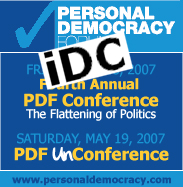
by Joshua Levy
Although it took place a little over a week ago, my impressions of the 2007 Personal Democracy Forum conference, which I attended on May 18th and helped to organize, are fresh in my mind.
First, a disclaimer: I'm Associate Editor for the PdF website and for a group blog called TechPresident, which both cover the way technology is changing politics. The former is an online companion to the conference and a blog in its own right; the latter is a more-focused group blog covering how the web is being used in the 2008 U.S. president campaign, both by supporters and the candidates themselves. Though it's an offshoot of the PdF site, it's become arguably more popular and influential, landing publisher Andrew Rasiej and editor Micah Sifry, and to a much lesser extent me, in the media spotlight.
The conference and the sites are devoted to covering the way that online technology -- blogs, video, social networking sites like Facebook and MySpace, Twitter, mashups of all sorts, and so on -- are helping citizens get more involved in the political process and self-organize outside of traditional campaign structures. For example, we're interested in the how MySpace, despite the problems of proprietary ownership and immaterial labor that Trebor and others of discussed here, also provides a platform for citizens to organize around issues like the genocide in Darfur and to get the word out to potentially hundreds of thousands of supporters, or how politicians are using YouTube to connect to supporters and, ideally, inject a new kind of transparency and authenticity into the electoral process.
I try not to be a utopian but I'm constantly impressed at how much potential there is for activism in today's mainstream online culture -- witness Facebook's new Platform that let's developers hook into their API and create apps that could take advantage of the viral nature of Facebook and could get a message out to thousands of friends in a single instant. Consider the fact that 80% of college students use Facebook; make it easy for them to get political or social messages out to their friends and you could seed a thousand campaigns.
This year's conference was the biggest in numbers since it began in 2004. Almost 700 people showed up to hear Larry Lessig, Yochai Benkler, Tom Friedman, Google CEO Eric Schmidt, danah boyd, and others (those are just a few of the folks from the morning sessions) talk about the influence of technology on politics. The afternoon held more traditional panels, a series of demos, and a roundtable with techies working on current presidential campaigns.
While Lessig, Benkler, boyd, and others wowed the crowd (as Benkler spoke you could almost hear the sound of a hundred people clasping their hands to their heads in overloaded delight), less enthusiasm greeted a conversation between Friedman and Schmidt; they contentedly spoke about how this new Internet thing was really, really great and how it was bringing so much more information to so many more people.
The words "China" or "Tiananmen Square" were conspicuously and disappointingly absent (maybe they were censored by the Google higher-ups).
Then Friedman spoke for an hour, reading from an update to his book The World Is Flat and giving his take on the wonders of the web. It was a conference attended by experienced politicos and technologists from both sides of the aisle, and some attendees were upset that so much time was given over to the CEO of one of the largest corporations in the world that is open about wanting to own all information, everywhere, and a columnist for the New York Times who is notorious for his support for the Iraq war. They wanted participation, provocation, etc -- the kind of openness you'd find at a BarCamp -- and we gave it to them at an "unconference" the next day, where the attendees were also presenters. Those that came to the unconference were generally happier with the structure, since if they had a session in mind they simply had to propose it and it would happen. You can read everyone's reactions here.
So what did we actually talk about? Session titles ranged from "Embracing Voter-Generated Content" to "Web 2.0: Cult of the Amateur?" (moderated by me and featuring Andrew Keen, Clay Shirky, Craig Newmark, and Robert Scoble -- that was fun) "Political Money Online: Getting It and Spending It More Effectively" and "E-Lessons from Overseas: Europe, Latin America and Australia."
The discussion on this list tends toward the theoretical, but although we never engaged in, say, a discussion of Habermas and the public sphere, we did look at how notions of distributed creativity or Benkler's wealth of networks actually affect politics on the ground. Meeting Farouk Olu Aregbe, the man who created the "One Million Strong for Barack" campaign on Facebook, or meeting campaign staffers finding interesting ways to use Twitter, was helped me see how people are using this idea of participatory online culture for political purposes. Although I tend to be uncomfortable supporting mainstream political campaigns and ideas, there is a ton to learn by watching how any groups are using social media and technology. And it's fun to be around politicos who, at heart, are geeks like me.
Was the conference a success? From my vantage point it's hard to tell. Although there were complaints about Schmidt and Friedman, they also helped to draw in the sponsorship that helped pay for the conference in the first place, and to get more media attention. It could also be argued that bringing them into the fold spurred a necessary critique of their corporate-utopianism and wide-eyed wonder of the web.
More than anything else, my experience co-organizing the unconference reminded me of how fun and important the BarCamp-style conferences can be. Their very structure is an exercise in applying our love of the wiki to something offline, and it largely works.
I know some of you on this list were at the conference and even spoke there; I hope to see some of you next year too, and to hear your opinions about taking this discussion to what some would consider the belly of the beast.
-Josh Levy
www.personaldemocracy.com
www.techpresident.com
www.levjoy.com
iDC -- mailing list of the Institute for Distributed Creativity iDC[at]mailman.thing.net http://mailman.thing.net/cgi-bin/mailman/listinfo/idc
List Archive:
http://mailman.thing.net/pipermail/idc/
iDC Photo Stream:
http://www.flickr.com/photos/tags/idcnetwork/
Posted by jo at 12:15 PM | Comments (0)
Logging On:
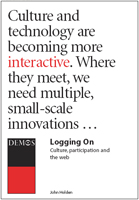
Culture, participation and the web
Logging On: Culture, participation and the web - John Holden: In the brief history of the internet, the cultural sector has followed two related paths: on the one hand, the digitisation of content and provision of information and, on the other, interactivity and opportunities for expression. Some have seen these as in binary opposition. The truth is that they are inexorably merging. But the big question is where do we go next? How can policy intervention best meet with technology to achieve the aim of bringing about a more democratic culture? What will be the role, opportunities and limitations of online culture in a rapidly changing world?
A moment of reflection is provided by the coming to an end, in March 2007, of the Culture Online initiative funded by the Department for Culture,Media and Sport. Culture Online provides both an interesting case study, bringing together lessons learnt about how to organise online engagement, and a point of departure for asking questions about future directions. [via iDC]
Posted by jo at 09:19 AM | Comments (0)
May 19, 2007
m-cult news 05/07
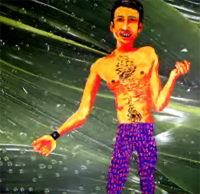
Urban TV, Participatory Politics +
M2HZ tests underway: M2HZ, the Helsinki-based urban television project is performing tests in May 14-20, 2007. The test broadcast aims to demonstrate a new type of open television in Finland, where local and public access tv is close to nonexistent. The M2HZ model is based on distributed production for a multi-channel transmission platform.
M2HZ is a collaboration between dozens of media, arts and civil organisations, who wish to affect the media landscape and find new audiences. Over 300 people have contributed their voices, insights and work to the development which kicked off in late 2005.
The test week's days are themed around debates on television and media criticism, local and global issues, live and media art, and the public domain. Throughout the week we follow the Sound & Fury of young bands, the events in the Kallio Kukkii neighbourhood festival, exercises by the Hunger theatre, and short films by media artists and students.
The programme is mostly in Finnish but also includes the first international exchanges: the new film Faceless by Manu Luksch and a retrospective of work by the Swedish Rafilm collective.
The test uses the digital tv and streaming platform of DINA tv, a cable channel of media schools. First tests for digital antenna (DVB-T) and mobile (DVB-H) distribution are performed with the VTT Technical Research Centre and the FinPilot2 project. Other key partners are the Youth Centre of Helsinki, Stadia polytechnic, and Otaniemi Underground Broadcasting System OUBS, the live-in television station of engineering students. M2HZ is coordinated by m-cult and supported by the Uusimaa Regional Council.
Participatory politics: m-cult and the Democracy Unit of the Ministry of Justice realize a workshop on participatory politics and foresight on June 8, 2007. The workshop gathers researchers, decision-makers and NGO representatives to discuss experiences of participatory forums and web tools to support deliberative democracy. Visiting experts are Lars Klüver (Danish Board of Technology) and Richard Rogers (University of Amsterdam / govcom.org).
The aim of the workshop is to find new methods, processes and tools for democracy. A special challenge is to bring citizen's views to affect the early phases of government and technology programmes.
m-cult at Pocketfilms: The Forum des Images has invited m-cult to present work on mobile and urban media at the Pocketfilms festival, Paris June 8-10, 2007. At the Pompidou centre, m-cult presentation includes Heidi Tikka's project Situations, the Mobicast project by Adam Hyde and the mobile production experiments realized within M2HZ.
Posted by jo at 01:11 PM | Comments (0)
May 18, 2007
Social Tapestries
Conversations and Connections Report
A report (by Kevin Harris and Giles Lane) on the Conversations and Connections project in the Havelock Estate in Southall, is now available to download. It explores the challenges we encountered and the solutions we developed in researching what public authoring could offer for community cohesion and democratic engagement in a low income social housing scheme with serious problems of institutional neglect and low opportunity. In evaluating the project's impact and achievements it offers some key lessons and policy messages for trying to stimulate participation and engagement through technological innovation. The project was funded by an Innovation Grant from the Electoral Policy Division of the Ministry of Justice (formerly the Department for Constitutional Affairs).
http://socialtapestries.net/havelock/ST_Conversations_MoJReport.pdf
A bound version is also available to buy from the Proboscis Store for £5.00 plus postage and packing.
Posted by jo at 12:14 PM | Comments (0)
May 10, 2007
Wafaa Bilal: Domestic Tension
Iraqi born artist Wafaa Bilal has become known for provocative interactive video installations. Many of Bilal's projects over the past few years have addressed the dichotomy of the virtual vs. the real.
He attempts to keep in mind the relationship of the viewer to the artwork, with one of his main objectives transforming the normally passive experience of viewing art into an active participation. In Domestic Tension, viewers can log onto the internet to contact, or shoot, Bilal with paintball guns.
Bilal’s objective is to raise awareness of virtual war and privacy, or lack thereof, in the digital age. During the course of the exhibition, Bilal will confine himself to the gallery space. During the installation, people will have 24-hour virtual access to the space via the Internet. They will have the ability to watch Bilal and interact with him through a live web-cam and chat room. Should they choose to do so, viewers will also have the option to shoot Bilal with a paintball gun, transforming the virtual experience into a very physical one.
Bilal’s self imposed confinement is designed to raise awareness about the life of the Iraqi people and the home confinement they face due to the both the violent and the virtual war they face on a daily basis. This sensational approach to the war is meant to engage people who may not be willing to engage in political dialogue through conventional means. Domestic Tension will depict the suffering of war not through human displays of dramatic emotion, but through engaging people in the sort of playful interactive-video game with which they are familiar.
For the duration of May, 2007, Iraqi born artist Wafaa Bilal will live in the FlatFile Galleries in Chicago. The public can watch him 24 hours a day over a live webcam; and if they choose, visitors to his website can shoot him with a remote controlled paintball gun.
Bilal’s self imposed confinement is designed to raise awareness about the life of the Iraqi people and the home confinement they face due to the both the violent and the virtual war they face on a daily basis.
You can participate - eg shoot at him with a paintball gun - by clicking here.
See this site for some videos and more about the Wafaa's work. [via selectparks]
Posted by jo at 03:29 PM | Comments (0)
April 25, 2007
[iDC] THE ANTI WEB 2.0 MANIFESTO (Andrew Keen)
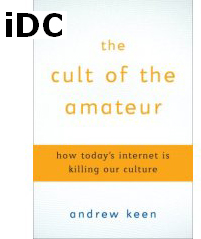
CULT OF THE AMATEUR: How the Internet is killing our culture
Hi everyone -- My name is Andrew Keen and I'm the author of the forthcoming (June 5) CULT OF THE AMATEUR: How the Internet is killing our culture. For more about my ideas, see my Internet writing at: CultOfTheAmateur, ZDNet, and Britannica. A blogging critique of blogging, eh. What is the world coming to? Anyway, I've been invited by kind Trebor to join your newsgroup and discuss / defend / critique my ideas. Trebor will post my anti Web 2.0 manifesto (aka: Adorno-for-idiots). So that should provide some lite afternoon reading for y'all. All the very best from sunny south-central Berkeley, Andrew.
Trebor wrote:
Welcome to Andrew Keen. His "deliciously subversive new book," "The Cult of the Amateur" "exposes the grave consequences of today’s new participatory Web 2.0 and reveals how it threatens our values..." There is a parallel to Jaron Lanier's "Digital Maoism: The Hazards of the New Online Collectivism." (Thanks to Bernardo Parrella for the link.)
THE ANTI WEB 2.0 MANIFESTO (Adorno-for-idiots) by Andrew Keen
1. The cult of the amateur is digital utopianism’s most seductive delusion. This cult promises that the latest media technology -- in the form of blogs, wikis and podcasts -- will enable everyone to become widely read writers, journalists, movie directors and music artists. It suggests, mistakenly, that everyone has something interesting to say.
2. The digital utopian much heralded “democratization” of media will have a destructive impact upon culture, particularly upon criticism. “Good taste” is, as Adorno never tired of telling us, undemocratic. Taste must reside with an elite (“truth makers”) of historically progressive cultural critics able to determine, on behalf of the public, the value of a work-of-art. The digital utopia seeks to flatten this elite into an ochlocracy. The danger, therefore, is that the future will be tasteless.
3. To imagine the dystopian future, we need to reread Adorno, as well as Kafka and Borges (the Web 2.0 dystopia can be mapped to that triangular space between Frankfurt, Prague and Buenos Aires). Unchecked technology threatens to undermine reality and turn media into a rival version of life, a 21st century version of “The Castle” or “The Library of Babel”. This might make a fantastic movie or short piece of fiction. But real life, like art, shouldn’t be fantasy; it shouldn’t be fiction.
4. A particularly unfashionable thought: big media is not bad media. The big media engine of the Hollywood studios, the major record labels and publishing houses has discovered and branded great 20th century popular artists of such as Alfred Hitchcock, Bono and W.G. Sebald (the “Vertigo” three). It is most unlikely that citizen media will have the marketing skills to discover and brand creative artists of equivalent prodigy.
5. Let’s think differently about George Orwell. Apple’s iconic 1984 Super Bowl commercial is true: 1984 will not be like Nineteen Eighty-Four the message went. Yes, the “truth” about the digital future will be the absence of the Orwellian Big Brother and the Ministry of Truth. Orwell’s dystopia is the dictatorship of the State; the Web 2.0 dystopia is the dictatorship of the author. In the digital future, everyone will think they are Orwell (the movie might be called: Being George Orwell).
6. Digital utopian economists Chris Anderson have invented a theoretically flattened market that they have christened the “Long Tail”. It is a Hayekian cottage market of small media producers industriously trading with one another. But Anderson’s “Long Tail” is really a long tale. The real economic future is something akin to Google -- a vertiginous media world in which content and advertising become so indistinguishable that they become one and the same (more grist to that Frankfurt-Prague-BuenosAires triangle).
7. As always, today’s pornography reveals tomorrow’s media. The future of general media content, the place culture is going, is Voyeurweb.com: the convergence of self-authored shamelessness, narcissism and vulgarity -- a self-argument in favor of censorship. As Adorno liked to remind us, we have a responsibility to protect people from their worst impulses. If people aren’t able to censor their worst instincts, then they need to be censored by others wiser and more disciplined than themselves.
8. There is something of the philosophical assumptions of early Marx and Rousseau in the digital utopian movement, particularly in its holy trinity of online community, individual creativity and common intellectual property ownership. Most of all, it’s in the marriage of abstract theory and absolute faith in the virtue of human nature that lends the digital utopians their intellectual debt to intellectual Casanovas like young Marx and Rousseau.
9. How to resist digital utopianism? Orwell’s focus on language is the most effective antidote. The digital utopians needs to be fought word-for-word, phrase-by-phrase, delusion-by-delusion. As an opening gambit, let’s focus on the meaning of four key words in the digital utopian lexicon: a) author b) audience c) community d) elitism.
10. The cultural consequence of uncontrolled digital development will be social vertigo. Culture will be spinning and whirling and in continual flux. Everything will be in motion; everything will be opinion. This social vertigo of ubiquitous opinion was recognized by Plato. That’s why he was of the opinion that opinionated artists should be banned from his Republic.
Michel Bauwens wrote:
Here is some of my own commentary:
1. The cult of the amateur is digital utopianism's most seductive delusion. This cult promises that the latest media technology -- in the form of blogs, wikis and podcasts -- will enable everyone to become widely read writers, journalists, movie directors and music artists. It suggests, mistakenly, that everyone has something interesting to say.
I would go further than Guido and this, and indeed affirm that
Peer to peer processes are based on the principle of equipotentiality, see the entry here for a full treatment: http://www.p2pfoundation.net/Equipotentiality
Jorge Ferrer expresses beautifully what it is about:
Everybody can be considered ...
"equals in the sense of their being both superior and inferior to themselves in varying skills and areas of endeavor (intellectually, emotionally, artistically, mechanically, interpersonally, and so forth), but with none of those skills being absolutely higher or better than others. It is important to experience human equality from this perspective to avoid trivializing our encounter with others as being merely equal." (http://www.estel.es/EmbodiedParticipationInTheMystery,%201espace.doc)
Good participatory systems allow this to happen through self-selection first, then through communal validation.
A problem can arise with the second process of distributed quality control. Massification of judgment can lead to a bottoming effect, but not necessarily. It can be configured in such a way that either affinity groups or experts can play a privileged role in the validation process. The only difference is that the control is a posteriori instead of a priori. The advantage of a broader participation is that there is a greater quantity to select quality from. Finally, it is based on the idea that "together we know everything", and that even experts have limited and biased viewpoints.
The key point is that the "danger" that Keen points to is a matter of good design principles and processes, not of the participatory process itself.
There are many p2p projects where experts, and pro-ams successfully work together.
My comments here also reply to point 2, where Keen simply repeats the arguments that have always been brought against democratization, but each time, democratization has brought more cultural creativity and diversity.
>>3. To imagine the dystopian future, we need to reread Adorno, as well as Kafka and Borges (the Web 2.0 dystopia can be mapped to that triangular space between Frankfurt, Prague and Buenos Aires). Unchecked technology threatens to undermine reality and turn media into a rival version of life, a 21st century version of "The Castle" or "The Library of Babel". This might make a fantastic movie or short piece of fiction. But real life, like art, shouldn't be fantasy; it shouldn't be fiction.
Isn't this the same old tired argument assuming that the real and the virtual are 'separate' realms, where in fact there is just one embodied life, using various tools. This is not to say that there can be various 'abuses' and 'exagerrations' (people reading all the time, phoning all the time, surfing all the time), but they are not different from physical addictions (gambling, alcohol).
>>4. A particularly unfashionable thought: big media is not bad media. The big media engine of the Hollywood studios, the major record labels and publishing houses has discovered and branded great 20th century popular artists of such as Alfred Hitchcock, Bono and W.G. Sebald (the "Vertigo" three). It is most unlikely that citizen media will have the marketing skills to discover and brand creative artists of equivalent prodigy.
Of course, but lets turn his argument around. Not all small media are bad media. Distributed media can aggregate so to achieve scale, and can produce qualitative works as well. I'm thinking of the music in Bali, where every musician has to follow a collective score, and can only change the score through coordination with all other participants. This is just one polarity, the other being the jazzband model of free individual creativity in communal mode. Different production modalities will produce different types of creative possibilities, which have to be judged on their own merit. Big media has clear dumbing down effects, micro media, through wrong design, can have as well.
>>6. Digital utopian economists Chris Anderson have invented a theoretically flattened market that they have christened the "Long Tail". It is a Hayekian cottage market of small media producers industriously trading with one another. But Anderson's "Long Tail" is really a long tale. The real economic future is something akin to Google -- a vertiginous media world in which content and advertising become so indistinguishable that they become one and the same (more grist to that Frankfurt-Prague-BuenosAires triangle).
The centralisation of sharing can , and will, have some of such effects, but this is not the only future for micro production. True distribution can avoid some of these centralisation effects. The key is to defend the continued capacity to change hubs, since hubs will always exist through voluntary choices (power law). But it is possible to design for autonomy and diversity, to offset the protocollary power of invisible architectures.
Conclusion: againt Andrew Keen we must insist that participation (the peer to peer process) and elitism (the selection for quality process), can and will inevitable co-exist. The difference is that elites will be more diversified and flexible. The role of the elite is to sustain a more and greater creativity, not to put themselves as gatekeepers.
To quote John Heron, about leadership:
"The sole role of hierarchy is in its spontaneous emergence in the initiation and continuous flowering of autonomy-in-co-operation in all spheres of human endeavor."
Michel Bauwens
Simon Biggs wrote:
This is part of a bigger question, as Adorno suggests.
Where does good taste reside and how does a particular taste become prevalent?
Fashion might be an interesting example here. To quite an extent it is true that high fashion taste is set by an elite - mainly the fashion houses of Paris, Milan, London, NYC and Tokyo. However, they take their ideas from all over the place. It is accepted as standard practice in the fashion industry, as well as other design professions, to regard other people's creative work as fair game. Having taught (many years ago) on a reputable UK fashion program I was surprised (at the time) to see lecturers setting students projects where they were told to take the work of an artist (any artist they like, or perhaps a specific artist, or a style) and to use it as the basis for designing a collection.
Coming out of a contemporary arts background I was amazed at this. One would never suggest this to a fine art student as a means to initiate work, as the value of novelty and self expression are the touchstones of both fine art practice and pedagogy. The initiative has to come from the artist (or at least that is the premise).
The point of this story is to suggest that taste can have murky orgins. Those so called "trend setters" or "opinion formers" get their trends and opinions from somewhere...
Taking the example of fashion a little further, whilst it is the case that high fashion is primarily determined by a few fashion houses it is also the case that street fashion is quite different. Having lived in London for some decades I have observed how trends emerge and are picked up. Sometimes they come out of the media (via pop groups, TV, etc) but more often than not they start with small groups of individuals somewhere just trying something out, for the heck of it, finding it cool as a means of badging themselves, and then others joining in.
This would suggest that Adorno didn't quite get it. He may have been right speaking of Germany in the 1930's but the London of the late 20th Century, and many other such places, would seem to suggest a different model of how taste is created and picked up.
In this respect there is nothing new in the digitopian calls for a democratic web. Street culture already is like this. Of course you could say that such culture is tasteless...and you could very well be right.
However, it is a matter of taste.
Regards
Simon
iDC -- mailing list of the Institute for Distributed Creativity iDC[at]mailman.thing.net http://mailman.thing.net/cgi-bin/mailman/listinfo/idc
List Archive:
http://mailman.thing.net/pipermail/idc/
iDC Photo Stream:
http://www.flickr.com/photos/tags/idcnetwork/
Posted by jo at 01:31 PM | Comments (0)
April 21, 2007
Turbulence Commission:
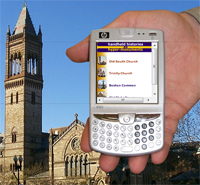
Handheld Histories as Hyper-Monuments
Turbulence Commission: Handheld Histories as Hyper-Monuments by Carmin Karasic, Rolf van Gelder and Rob Coshow, with special thanks to the HP mscapers team, Brett Stalbaum, and Jo Rhodes :: Part of the Boston Cyberarts Festival, pick up a smartphone at the Judi Rotenberg Gallery, 130 Newbury Street, Boston :: April 21-28, 2007, Tues-Sat 10am-6pm. Gallery talk today: 2:00 pm.
Designed for HP iPAQ 6900 series smartphones, Handheld Histories as Hyper-Monuments uses GPS and mobile technologies to address historic bias in Boston's public monuments. The artwork gathers non-official stories to socially construct hyper-monuments that exist as digital doubles, augmenting specific historic monuments. For example, imagine you are near the Old South Church in Boston, MA, USA. The smartphone sounds church bells to get your attention. It then displays an easily identifiable image of the Old South Church circa 2007, followed by images of the church that take you back in time. Finally you see the location as it was in its natural, wild state. You can send text, image and audio content to the website from the monument location via any internet enabled device. Or use any internet browser to view and add histories to the hyper-monuments.
HHHM requires HP mediascapes locative media software to create content rich hotspots on GPS aware maps. Once the HHHM mediascape is installed on a handheld device, a GPS fix is required to automatically display the hyper-monument. WiFi internet connectivity is best for viewing and contributing to the hyper-monument via the handheld's browser.
“Handheld Histories as Hyper-Monuments” is a 2007 commission of New Radio and Performing Arts, Inc., (aka Ether-Ore) for its Turbulence web site. It was made possible with funding from the LEF Foundation.
BIOGRAPHIES
One November morning in 1994, CARMIN KARASIC was listening to digital artists on NPR when she realized she was a digital artist trapped in a Fidelity Technical Project Manager's body. This simple realization changed her life. A multimedia artist focused on Internet Art, she is also an Assistant Director of Boston Cyberarts, and on the faculty of Lesley University. Her work can be seen online in several e-zines, websites, and galleries, such as CAGE. She has exhibited in the Boston area at the DeCordova Museum, MIT List Center, the Attleboro Museum, Computer Museum, New England School of Art and Design, The Art Institute of Boston, and The Brodigan Gallery; in NY at the Studio Museum, Harlem; Brooks Gallery at Cooper Union, and the New York Hall of Science; and Austria, Canada, Japan, and Germany. Carmin has been awarded a Mudge Fellowship from the Groton School and a duPont Fellowship from the Art Institute of Boston.
ROLF VAN GELDER is an artist and web developer. Self-taught, he has been creating visual art since the early 80s. He has been collaborating with Carmin Karasic since the 1990s. They created "d{s}eduction dialogue" for the 2001 Boston Cyberarts Festival and "Virtual Quilt" (2002) for the DeCordova Museum and Sculpture Park, Lincoln, MA, USA (with Clara Wainwright). In 1995 Rolf founded one of the first on-line art galleries, CAGE - Cyber Art Gallery Eindhoven (http://www.cage.nl). His work has been exhibited in over 50 exhibitions in the U.S.A., Canada, Austria, Portugal, Italy, Sweden, Germany, UK, Spain and the Netherlands.
ROB COSHOW is an artist/photographer who recently graduated Magna Cum Laude from the Art Institute of Boston. Trained in classic wet-lab photography as well as digital and new media, Rob has honed his experimental approach to create works that bridge multiple disciplines. In 2006, he exhibited his “Crab Cake” robots at Axiom Gallery, and collaborated with Jeff Warmouth, Roland Smart and other Boston artists to create “Art Show Down” at Art Interactive. He has received various honors for his photography and illustrious reviews for his new media work.
Posted by jo at 10:10 AM | Comments (0)
Web 2.0

Study finds weak participation
"Web 2.0, a catchphrase for the latest generation of Web sites where users contribute their own text, pictures and video content, is far less participatory than commonly assumed, a study showed on Tuesday. A tiny 0.16 percent of visits to Google's top video-sharing site, YouTube, are by users seeking to upload video for others to watch, according to a study of online surfing data by Bill Tancer, an analyst with Web audience measurement firm Hitwise.
Similarly, only two-tenths of one percent of visits to Flickr, a popular photo-editing site owned by Yahoo, are to upload new photos, the Hitwise study found. The vast majority of visitors are the Internet equivalent of the television generation's couch potatoes--voyeurs who like to watch rather than create, Tancer's statistics show. Wikipedia, the anyone-can-edit online encyclopedia, is the one exception cited in the Hitwise study: 4.6 percent of all visits to Wikipedia pages are to edit entries on the site..." More Study finds weak participation on Web 2.0 sites by Reuters :: April 17, 2007.
Posted by jo at 08:01 AM | Comments (0)
April 20, 2007
Prototypes of Moving Pictures
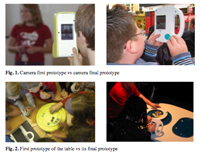
A Spontaneous + Collaborative Approach to Video Creation
The full paper written for Interact 2007 with http://web.media.mit.edu/~ishii/ is accepted! It shows how Textable Movie designed for facilitating video production has informed Moving Pictures. It presents a mechanism to seamlessly interface the various parts in video production and present our observations. The conference topic is socially-responsible interaction. So see you in Rio de Janeiro in September!
Abstract: The paper presents a novel approach to collecting, editing and performing visual and sound clips in real time. The cumbersome process of capturing and editing becomes fluid in the improvisation of a story, and accessible as a way to create a final movie. It is shown how a graphical interface created for video production informs the design of a tangible environment that provides a spontaneous and collaborative approach to video creation, selection and sequencing. Iterative design process, participatory design sessions and workshop observations with 10-12 year old users from Sweden and Ireland are discussed. The limitations of interfacing video capture, editing and publication in a self-contained platform are addressed. Download the 14 pages paper. [blogged by Cati Vaucelle on Architectradure]
Posted by jo at 05:19 PM | Comments (0)
April 19, 2007
[iDC] A critique of sociable web media

Trebor Scholz
Our discussion about affective labor and the sociable web came up again at a recent panel at The New School. Afterwards there were quite a few fascinating responses to the arguments across the blogosphere to which I responded (here).
I summed up my ideas in a willfully provocative essay for a new issue of the journal Re-Public. (The issue also features essays by Geert Lovink, McKenzie Wark and Michel Bauwens.)
What is a fair exchange in the context of the highest traffic sites of the sociable web? Yes, we get much out of many sites to which we contribute. We can "egocast," build friendships, develop thousands of weak ties, learn, date, and simply enjoy hanging out with friends on this disembodied platform.
It is hard, however, not think of utilization when NewsCorp spent $583m on MySpace, which is now estimated to head toward a market value of $15billion (over the next 3 years). A definite value is created and that surplus value is not shared in a fair way.
The community, which indeed undoubtedly benefits, is monetized. People cannot simply leave if they don't like being used because their friends are all on that site. You can't post a video to a small video-sharing site if online fame is what you are after. Perhaps the days of "Friendster-mobility" are over. Here, the networked publics left in large numbers. The choice that participants have is limited; they are in a social lock-down of sorts. This lack of true alternatives may have well been the reason that 700.000 users of the Facebook recently protested when the unpopular RSS feature was introduced.
On the before mentioned panel, both, danah boyd and Ethan Zuckerman brought up the tremendous costs for NewsCorp that are associated with technically supporting all that sociality on MySpace. Ethan also pointed out that it may take big business to facilitate large scale networked social life.
In the end, what really matters is not only that people become aware of the fact that they are being used on these giant sites. It is important to be clear about the ownership of content and it is also crucial to know the privacy rules of the platforms that we are using.
What is most important, however, is the ability to be independent, which means that I have a way of leaving-- taking with me what I invested (the content-- the blog entries, the photos, the videos...). For me, much of the ethics of the sociable web is related to the ability to call it quits.
-Trebor
PS:
Some of these topics were also picked up in Sweden: http://www.whomakesandownsyourwork.org/mw/index.php?title=Main_Page
New subscribers-- you can read our list archive of this debate at: http://mailman.thing.net/pipermail/idc/2007-April/thread.html
iDC -- mailing list of the Institute for Distributed Creativity iDC[at]mailman.thing.net http://mailman.thing.net/cgi-bin/mailman/listinfo/idc
List Archive:
http://mailman.thing.net/pipermail/idc/
iDC Photo Stream:
http://www.flickr.com/photos/tags/idcnetwork/
Posted by jo at 09:28 AM | Comments (0)
April 13, 2007
spring_alpha
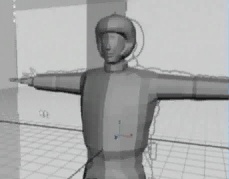
Rewritable on both the Narrative and Code Level
spring_alpha is a networked game system set in an industrialised council estate whose inhabitants are attempting to create their own autonomous society in contrast to that of the regime in which they live. The game serves as a "sketch pad" for testing out alternative forms of social practice at both the "narrative" level, in terms of the game story, and at a "code" level, as players are able to re-write the code that runs the simulated world ... 'spring_alpha' is a game in permanent alpha state, always open to revision and re-versioning. Re-writing spring_alpha is not only an option available to coders however. Much of the focus of the project lies in using game development itself as a vehicle for social enquiry and speculation; the issues involved in re-designing the game draw parallels with those involved in re-thinking social structures. [via]
Posted by jo at 07:15 PM | Comments (0)
April 02, 2007
[iDC] A critique of sociable web media
![]()
Community as Product
Perhaps this exchange could lead us to deepen our earlier debate about possibilities for a radical critique of sociable web media.
If you agree with Paolo Virno's and Maurizio Lazzaroto's theory that argues that "virtuosic performance" and "the act of being a speaker" is the new immaterial labor [of the North], then yes, the sociable web is the new "factory without walls." I, for one, don't sign off on the fucked up naturalization of the exploitation labor that is so dear to capitalism. Where are the people who care if big profits are made of their distributed creativity? Most participants are not conscious of their embrace of market-based behavior. The most central sites of the World Wide Web create massive surplus value and small startups are frequently bought out by the Walmarts of the Internet (NewsCorp, Yahoo, Google) the very moment that they attract sufficient numbers of page views. People spend most time on the sites of these giants and not in the "mom and pop stores." Almost 12 percent of all time spent by Americans online is spend on MySpace.
Nicholas Carr pointed out that forty percent of all web traffic is concentrated on ten websites (www.sina.com.cn, www.baidu.com, www.yahoo.com, www.msn.com, www.google.com, www.youtube.com, www.myspace.com, www.live.com, www.orkut.com, and www.qq.com).
Most of these sites owe their popularity to the wealth of content generated by the visiting net publics that spend significant amounts of time on these very, very few sites thus creating wealth for a handful of corporate owners. What pulls people in?
In a recent interview with Forbes Video Network, Jay Adelson (CEO of Digg.com) was asked "What's going to keep people to come back?" Adelson responded:
"Community is what really keeps people coming back. These people are passionate about what Digg has done for them. The user experience they get from being part of that community is only getting better each day."
Attention translates into concrete monetary value and community is the product. Crude offline capitalism is replicated online, much against the hopes of early cybernetics and the linked back-to-the-land, countercultural aspirations of the late 60s and early 70s that Fred Turner talks about.
The dynamic of-- being used-- may hold much less true for peripheral websites in the concentric hierarchy of the participatory web. The online "mom and pop store" has a much more benevolent ratio of participant benefits versus the company's running costs. And then there are also the two or three non-profits like Archive.org and Craig Newmark's initiatives holding up 'Fort Hope.' They are, to be sure, not dominating the read/write web.
The immaterial, "affective labor" of net publics produces data. Contributors comment, tag, rank, forward, read, subscribe, re-post, link, moderate, remix, share, collaborate, favorite, write; flirt, work, play, chat, gossip, discuss, and learn. They fill in profiles: 120 million people shared detailed personal information with NewsCorp, for example. 18 million students shared personal details in their Facebook profiles with Yahoo. They share information about their favorite music and clubs. They are not shy to list the books they are reading and the movies they are watching. They detail their sexual orientation and postal address complete with hometown, phone number, and email address. They share pictures, educational history and employment. Profiles, even if only visible to their buddies (and well, Yahoo), they list their daily schedules, general interests, and friends.
It seems obvious that all this channeled networked sociality represents monetary value. Post-dot.bomb, the Google zars would not buy a very young video website like YouTube for the price of the New York Times Company if there would not be a clear monetary value.
The dicey ethics related to property issues and exploitation of labor of *the core of the sociable web* becomes apparent if we look at Yahoo's privacy policies for Facebook.
"Facebook may also collect information about you from other sources, such as newspapers, blogs, instant messaging services, and other users of the Facebook service through the operation of the service (e.g., photo tags) in order to provide you with more useful information and a more personalized experience."
That is a dream come true for any market researcher. But it does not stop at bizarre privacy policies, Yahoo also claims rights over the content on Facebook:
"By posting User Content to any part of the Site, you automatically grant, and you represent and warrant that you have the right to grant, to the Company an irrevocable, perpetual, non-exclusive, transferable, fully paid, worldwide license (with the right to sublicense) to use, copy, publicly perform, publicly display, reformat, translate, excerpt (in whole or in part) and distribute such User Content..."
The picture of net publics--being used--is, however, complicated by the fact that participants undeniably get a lot out of their participation. There is the pleasure of creation and mere social enjoyment. Participants gain friendships and a sense of group belonging. They share their life experiences and archive their memories. They are getting jobs, find dates and arguably contribute to the greater good.
The scale and degree of exploitation of immaterial labor is most disturbing when looking at the highest traffic sites. The sociable web makes people easier to use and this dynamic will only be amplified by the increasing connection of mobile devices to the big social networking sites.
Trebor Scholz
PS: I'll add the necessary references to this text and post it on my blog. http://collectivate.net/journalisms/
Pat Kane wrote:
Great piece, Trebor, but just a few semi-naive questions I want to throw in:
* What about the civil liberties dimension of omnivorous data capture? I just finished reviewing Lessig's Code 2.0 (the updated version) http://theplayethic.typepad.com/play_journal/2007/03/the_fair_cop_in.html, and I've been chilled to the bone by his prescription of an 'digital identity passport', as a solution to spam, and a means of managing information privacy vis-a-vis the state and corporations (though he sets out some really surprising threat-to-state preconditions for legal disclosure of digital identity). Google's revelation that it's only going to keep 18 months of your websearching only makes you realise how much they *were* keeping - and when Google told the Feds to butt out, when they wanted to look at their user archives to research porn use, it makes you realise that we should be replacing 'in God we trust' with 'in Google we trust' on the dollar bill. That seems far too much civil responsibility for one shareholder-driven corporation to bear. But Lessig's 'ID card' vision of the net - all derived from his vision of the net as a constitutional phenomenon, an 'architecture of value' - feels far too grown-up for me. But I think I'm going to have to grapple with it. Adam Greenfield's musings on 'a jurisprudence for everyware' are also interesting here (use yer cached, http://tinyurl.com/3bw7la).
* But isn't there also something about advertising on the social web that, at the very least, puts it in its proper place - ie, as secondary to the social experience? We can bemoan and drum our fingers at the interstitials that stand in the way of us getting to that Salon article - but let's be honest, how many of us fulfill the advertiser's aspiration and click through to a website for yet another stylish people carrier, or post-colonial alcoholic spirit? In terms of an old-fashioned (and yeah, ok, social-democratic) Habermasian framework, this feels to me like the "system" (or various systems) very much being rebalanced in terms of the values of the "lifeworld" (or community). But maybe I'm being too politically boring here...
* ... Because I'm also an avid reader of the autonomists, and there's a recent interview with Virno that really focuses the political question of how immaterial labour might or might not become a class for itself, as much as in itself: http://info.interactivist.net/article.pl?id=06/01/17/2225239&mode=nested&tid=9
"The global movement ever since Seattle resembles a half-functioning voltaic battery: it accumulates energy without rest but does not know how and where to discharge it. We face a marvelous hoarding to which no adequate investments correspond at this time. Or do we face a new technological apparatus, powerful and refined, for which we, however, ignore the instructions? The symbolic-media dimension has been at once a propitious occasion and a limit. On the one hand, it has guaranteed the accumulation of energy; on the other, it has hindered or deferred to infinity its application.
"Every activist is aware of this: the global movement does not yet manage to have an effect—I mean, to have an effect with the grace of corrosive acid—on the current capitalist accumulation. From where is the difficulty born? Because neither the profit margin nor the functioning of constitutive powers have been disturbed more than a tiny bit by the new global movement? To what is this paradoxical “double bind” due on which basis the symbolic-communicative sphere is both an authentic springboard and the source of paralysis?
"The impasse that seizes the global movement comes from its inherent implication in the modes of production. Not from its estrangement or marginality, as some people think. The movement is the conflictual interface of the post-Fordist working process. It is precisely because, rather than in spite, of this fact that it presents itself on the public scene as an ethical movement.
"Let me explain. Contemporary capitalist production mobilizes to its advantage all the attitudes characterizing our species, putting to work life as such. Now, if it is true that post-Fordist production appropriates “life”—that is to say, the totality of specifically human faculties—it is fairly obvious that insubordination against it is going to rest on the same basic datum of fact.
"To life involved in flexible production is opposed the instance of a “good life.” And the search for a good life is indeed the theme of ethics. Here is at once the difficulty and the extraordinarily interesting challenge. The primacy of ethics is the direct result of the material relations of production. But at first glance this primacy seems to get away from what, all the same, has provoked it. An ethical movement finds it hard to interfere with the way in which surplus value is formed today. The workforce that is at the heart of globalized post-Fordism—precarious, flexible border-workers between employment and unemployment—defends some very general principles related to the “human condition”: freedom of language, sharing of that common good that is knowledge, peace, the safeguarding of the natural environment, justice and solidarity, aspiration to a public sphere in which might be valorized the uniqueness and unrepeatability of every single existence.
"The ethical instance, while taking root in the social working day, flies over it at a great height without altering the relations of force that operate at its interior. Whoever mistrusts the movement’s ethical attack, rebuking it for disregarding the class struggle against exploitation is wrong. But for symmetrical reasons, they are also wrong who, pleased by this ethical attack, believe that the latter might put aside categories such as “exploitation” and “the class struggle.” In both cases, one lets slip the decisive point: the polemical link between the instance of the “good life” (embodied by Genoa and Porto Alegre) and life put to work (the fulcrum of the post-Fordist enterprise)."
--- I think it's so productive to muse on this Virno passage, both for where it might be right and wrong. To what extent are we 'ignoring the instructions' of these new technological apparatuses - or testing them to their limits (ie, if YouTube gets too censorious, where do we go next to 'become the media')?
His point about the "symbolic-communicative sphere" being both "an authentic springboard and the source of paralysis" is also acute - anyone observed how the New Tories in the UK are radically embracing the social web (http://commentisfree.guardian.co.uk/george_osborne/2007/03/the_internet_is_changing_the.html, http://www.webcameron.com)? And how they're also combining that with a explicit politics of the 'Good life' - General Wellbeing (GWB) instead of GDP as the index of progress for societies, etc? (See http://theplayethic.typepad.com/play_journal/2006/05/well_beings_or_.html). Now, if anything looks like an "ethical instance" flying over the conditions of the 'social factory' without 'altering the relations of force that operate at its interior', it's going to be the British Tory Party 2.0.
Thoughts?
Pat Kane
Nocolas Ruis III wrote:
The problem with this analysis is that it completely ignores the fact that we are all capitalists. Yes, the scales of exchange are unevenly balanced, but where in the world is such not the case?
Rather, we must seek to cultivate democratic spaces of exchange that are more equitable, and structures of governance that do not add insult to injury...an
egalitarian modulation process of equity, where the highest, is not so high (no trillion dollar salaries for film actors and basketball players,CEOs, etc.) and the lowest is not so low (no starvation, abusive exploitation, etc. on the plains of poverty).
Herein lies the importance of the political. It is not that we will not be capitalists--this has already been decided by virtue of our birth as living capitalizing beings, driven by the currency of the Code; that genetic protocol of environmental utility and capitalization. Every breath we take is a capitalization on the environment we exist within...
NRIII
Burak Arikan wrote:
Thanks for this post Trebor.
So what can we do against networked exploitation?
I think an obvious strategy is to exploit those exploiters. Google Will Eat Itself (GWEI)[1] and Amazon Noir[2] are good examples for finding the holes in sociable web media systems and using the holes for reverse exploitation.
I think another strategy is to stay in context for collective action while all those sociable web media giants are fighting with each other for your attention (aka attention economy). There are many ways to stay in context such as email lists, forums etc. and all that social software actions as Trebor mentioned: commenting, tagging, ranking, forwarding, linking, moderating, remixing etc. Tools and environments for such actions are mainly provided by giant corporations, and under US laws, one who aggregates information owns it. But we can make our own web services for staying in the context, just like the way we can setup and maintain an old email list technology.
So this brings in the discussion of "open service provider". As open source software development communities demonstrate, we can collectively create value independent from the capitalist exploitation. If we are in the software-as-service era [3], support and use open service providers as much as you support open source software. It is very important to intensify and redirect our collective techno-cultural production to a territory that is formed more by individual’s free-will than capital's interests. But of course making one open alternative for each commercial-social web tool/environment is not all that relevant, it sounds just like making the free version of MS Office. So an open service provider can use existing techniques but I think they should invent new types of interaction and aggregation for the good of the community.
I use software-as-service strategy in my artwork. They are not commercial services nor utilitarian. I believe that building an open service is closer to making a cultural product than making a commercial one. As Steve Kurtz of Critical Art Ensemble puts it the relation of the creative expression to social processes is as important as the materials, processes, and products. [4]
Burak Arikan
* A version of this email is also posted in my journal burak-arikan.com/blog
[1] GWEI. gwei.org
[2] Amazon Noir amazon-noir.com
[3] Open Source Paradigm Shift, Tim O'Reilly. http://tim.oreilly.com/articles/paradigmshift_0504.html
iDC -- mailing list of the Institute for Distributed Creativity iDC[at]mailman.thing.net http://mailman.thing.net/cgi-bin/mailman/listinfo/idc
List Archive:
http://mailman.thing.net/pipermail/idc/
iDC Photo Stream:
http://www.flickr.com/photos/tags/idcnetwork/
Posted by jo at 08:17 AM | Comments (0)
March 25, 2007
NOEMA

Ideas + Survey
Generic Infrastructures [2] by Rob van Kranenburg: Today we are in the worst situation imaginable. Our global and undisputed computing paradigm posits that computing processes are successful only in as much as they disappear from view. Our design focus is ever more following Philips untenable but seductive ‘sense and simplicity’ resulting in the-bug-as-a-feature-design of the Ipod Shuffle. Our educational system is following this systemic hide-complexity strategy that favors the large industrial labs, IT conglomerates and above all their clinging to notions of IP and the patent that are firmy tied to their notions of doing business and making money. And our users, us? We are YOU, the most influential person of the year 2006, according to TIME Magazine. You fill the Wikipedia entries in your spare time, you blog your daily activities, you co-bookmark on de.l.i.c.i.o.u.s, upload your photos to flickr, you buy mating gear in Second Life, and mark your position on Plazer or Google Earth. You fill out the forms. Isn’t it time you start questioning the principles behind the formats? And, to make matters even worse, your naïve ideas of sharing are corrupting notions of privacy, transparency and informational architecture symmetry.

Ludium II - Synthetic Worlds and Public Policy by Edward Castronova: Synthetic worlds – million-player online environments with genuine markets, societies, and cultures – are exploding in size and significance. Real world governments around the globe are beginning to grapple with their implications in the areas of taxation, intellectual property laws, consumer rights, addiction, violence, and more. Should synthetic worlds be controlled by developers, or by governments, or both? What about the rights of users? What general norms should legislatures and courts follow? More NOEMA >>
Posted by jo at 01:33 PM | Comments (0)
March 23, 2007
pay attention to the dance

Storytelling on the Web
Sean Stewart and Elan Lee, creators of two of the most successful alternate reality games to date, gave the keynote speech at this year's Arg-Fest-O-Con, a conference of the alternate reality gaming community. The whole video is over an hour, but well worth a look; the theme of the speech is 'trust'.
When I wrote a little while ago about ARGs as an emergent genre of storytelling entirely native to the Web, I identified some ways in which an ARG differs from the conventions of fiction in print form. In particular, part of the pleasure of an ARG is that it blurs the line between fact and fiction. There is a strange thrill to not knowing whether the latest link in the trail is fact (out of game) or fiction (in-game). It is also participatory and collaborative: the story does not unfold unless readers (players) collaborate to follow the trail of puzzles, hidden clues and hints. And though the story itself is 'authored' – the sites are prepared ahead of play, the story is worked out, and the whole operation is meticulously planned – it is always in a sense improvisatory. If the players pick up on a mistake, the 'puppetmasters' (game creators and operators) will work as fast as they can to incorporate it into the story if possible, so as not to destroy the fabric of the game.
Stewart and Lee describe the process of unfolding an ARG as a dance between players and puppetmasters, in which players are invited to suspend their disbelief for the duration of the story. Within the invitation, they explain, is a promise that you won't be made to feel stupid for playing along. And behind all this is trust on both sides.
This is important, he says, because no-one really knows how this genre works. Printed books bring with them a whole host of familiar protocols around how you read. People are familiar with the physical conventions of a book and the formal conventions of particular genres of book, and hence the experience is codified in a way that allows for a degree of detachment between producer and consumer. In contrast, ARGs as a genre are (in their current form, at least) less than ten years old and have very few established generic or formal codes. So in lieu of a tradition, the genre needs trust between participants.
It's also important because in an ARG suspension of disbelief works very differently. Whereas I know my novel stops being 'real' when I put my book down, an ARG inserts itself into my life in a much less clear-cut way. The game might phone you up, email you, post things to your house; all these events would be part of the story. Unlike a novel, it does not have edges. This lack of edges is typical of the Web. A blog is never finished, there is always a new link, and so on. But for fiction, this poses problems: if I'm suspending disbelief so I can enjoy the story, I want to know that I'm not going to be made to feel stupid for going along with it. I also need to know at what point to snap out of it and start taking things literally again. So it is no surprise that two prominent exponents of a kind of storytelling with no formal boundary-markers (no proscenium arch, if you will) emphasise the importance of trust between creators and participants in such a story.

The late Susan Sontag's recent piece in the Guardian is a passionate plea for the cultural and moral importance of novels. Narratives, she says, are of vital importance in helping humans make sense of their reality. I am one hundred per cent with her on this. However, she confines this faith in the improving power of stories specifically to the novel, while managing to sidestep both the cultural specificity of novels as a form, and role of oral storytellers, court poets, bards, folk tales and the countless other narrative traditions throughout history.
In the course of her rallying-cry for the novel (also, incidentally, a phillippic against those claiming the book to be dead), she inveighs against television (which rant I rather liked), and also proposes 'the hypernovel' as her main example of why fiction on the Net will never work. This 'hypernovel' as she describes it, is characteristically multiple-choice, notionally endless, possibly multi-authored and directionless narrative with none of the salutary benefits of stories that have a beginning, a middle and an end. And this, she implies, will simply not do. Readers like stories.
Given the ahistoricity of her approach to stories in general, it seems likely to me that Sontag takes for granted the established model of print authorship. This by necessity assumes a writer radically severed from its readership - which, as it is a paper book, cannot join the conversation - by a complex and time-consuming book-production process. The way she discusses debates around 'the hypernovel' clearly assume an equivalent level of detachment between the this notional hypernovel's creator and its consumers. But the model of separation between author and readers simply does not work on the Web, a medium characterised by minimal publication lead time and a conversational dynamic. However, this does not mean that, on the Web, storytelling is impossible. Nor does it mean that that nothing is ever authored. It just means it works differently.
The Web is a young medium. And ARGs are - by its enthusiasts' own admission - a very new genre. I would be very surprised if it did not evolve much further. But I'd be interested to know what Sontag might have made of a genre of storytelling that used not print but the Web; and yet, was not directionless or multiple-choice but collaboratively played out; that was authored, but with room for improvisation; and that took as its founding principle a delicate consensual suspension of disbelief rooted not in clear boundaries between 'fact' (the world outside the book) and 'fiction' (the world inside it) but in trust between all participants in the story. [posted by Mary Sebastian on if:book]
Posted by jo at 05:20 PM | Comments (0)
March 20, 2007
[iDC] In The Presence of Networks
![]()
A Meditation on the Architectures of Participation
In The Presence of Networks: A Meditation on the Architectures of Participation by John Hopkins (for the Pixelache 2007 festival publication), Helsinki, 17 March 2007
Architectures of Participation is a compelling phrase that attempts literally to frame a deeper fundamental of human existence. This text is a preliminary meditation on that existence and its profound presence.
On the immediate surface, the phrase suggests the grandiose, the monumental, and the static and rigid hegemony of brick-and-mortar -- a suggestion that appears to contravene the deeply dynamic nature of the broader continuum of human relation. This continuum, generated in part through participatory actions, is a far more fundamental space that circumscribes much of our passing presence in this world. We will have to dig deep to find the foundations.
Participation is one reductive descriptor that applies to the infinite range of personal energies expressed and shared during our lived be-ing. Participation is a condition that does not leave our lives until we leave our lives. Participation starts when life starts with the participatory synergy of reproduction. This prototypical participatory act is phenomenal in that the energies of two human beings combine to create the presence of a third human being. Participation is the root of life. Participation follows life in the synergies of parent with child, friend with friend, partner with partner, colleague with colleague, stranger with stranger. We participate in life, in living, every moment.
In the search for another way to understand participation, and to understand the dynamic of social collaboration, it is critical to leave materialism behind. Or at least leave the limited understanding of material expression as a defining Cartesian and mechanistic concept and move instead into a universe defined by and indeed comprising a dynamic configuration of energized flows. This is the basic assumption underlying the following thoughts.
Without this shared human presence, life would be a desert of phenomenal natural events each more alienating in its unpredictability than the previous. It is through the challenging dialectic of human relation that we find understanding, and, ultimately, some meaning in our brief presence in this world.
Social systems frame or perhaps even comprise this fundamental participatory nature of life. These systems are characterized by dynamic constellations of Selves desiring relevant interaction with Others -- most apparently to enhance physical survival. When the system functions properly, the body wins the battle for a time; but what happens to the spirit?
Individual isolation within or as an affect of social systems applies at least a patina of madness to one's presence in the world. It is primarily the a-social or the mad who retreat voluntarily from all human contact -- along with those who are in pursuit of the greater-than-social spirit. The yogi, the hermit, the vision-quester all retreat to isolation in the desert or on the mountain -- to those special places where the brute energy flows of physical nature actively drain the ordering life energy from the body system. This at the same time the chaotic natural flux allows the human spirit to expand almost without limit, but at the definite expense of bodily degeneration. The spirit wins the battle for a time; the body loses.
So, while some humans withdraw to the empty places to watch stars and clouds, let the spirit expand, and listen to the creaking groans of the earth, the rest of us are left elbowing each Other in order to get to the head of the queues for mating, food, and shelter. We fall back to the body fighting for dominance over the inevitable change of dissolution and final death.
Along with the jostling and elbowing for position, small groups gather to share their energy-draining experience and calculate the relative benefits of coordinated survival. Safety seems to inhabit numbers, and numbers add up to enhanced reproductive odds. Numbers also frame the abstracted domain of technology and machines. Machinic devices seem to help guarantee the dominance of one small group over another by supplying some slight edge on reproductive viability. These social constellations create or mandate structures of human relation which pool labor -- the cumulative expended energy of individual lives -- while endeavoring to create survival-technologies that will prolong the life of the collective.
A life-time is a limited period of organized organismic existence that each of us is endowed with by means of some indeterminate process. A primary characteristic of life-time is its absolute and unconditional limit: it runs out. We apparently do have some degrees of freedom to choose how we spend that life-time, so it becomes a question of which pursuits, interests, necessities, and diversions should populate our days. We often forget the absolute limit to it all, and proceed as though there is an unlimited amount of time. There is not. Each moment is a unique passing-through of experience, expenditure of time, and, more importantly, expenditure of energy. Each moment represents a small incremental dissolution in the organized structure of our embodied presence, entropy gnawing at our bones, energy flowing outwards. Each moment's survival is an expression of energy flowing from our bodies. Yes, we spend more or less time ensuring that we take energy into our systems to help maintain the necessary order, but it is never enough: the battery slowly runs down. With this in mind, how then do we choose how to expend our life-times, our dwindling energy stores? Do we value every moment as we should?
Time moving (there is no Other time!) is energy (which is motion) is change (all is) creativity (the foundational expression of energy) is life (the Self is limited but desires immortality and, indeed, is immortally transcendent).
One major choice we face is how much energy to expend in the course of interacting with the Others who populate our lives. How much face-time/energy do we spend on each human we come across. How much time do we spend on those remote Others we cannot see, or cannot hear, or cannot touch? How much time on those many Others who populate the social system we live in. The ones we cross paths with in random and determinate movement? The ones who forcefully find our paths and deflect them from their natural trajectory? The ones who, by their gravity or Light, attract or repel us?
It is this process of giving and receiving energy that is the very fabric of life-time, it accumulates to be the essence of our presence and our life.
Starting from the unitary encounter of the Self with the Other, there is, in the dynamic of the encounter, a sensation of flow (and of a lack of flow). Many terms and instances in language and social structure frame this sensation. It is clear that when there is an open and bi-directional flow between any two individuals that out of the encounter comes an excess of energy -- a condition of in-spiration following the encounter. In the opposite case, in a situation of blockages between the Self and the Other, the encounter is often a loss of creative inertia -- where there is a direct relationship between the sustained intensity of the engaged flow and the creative possibilities coming from it.
If one looks at an accumulation of these binary human systems, each with a potential energy surplus, there begins to appear two structures. The first is a simple network, where individuals in a limited system are connecting, engaging, and being energized by those encounters -- each encounter generating a surplus of energy. The network becomes the source of a powerful collective energy.
The second structure is an evolving social structure, which, by nature, seeks to harness those energies, the energies generated from these individual encounters, for the collective 'good.' The imposition of defined social pathways controls and harnesses the movement of energy between individuals. The fabric of a social system is the accumulation of these proscribed pathways or mediations. Some of the energy invested in the process is tapped off into the social system when the Self and the Other engage with each other through these mediated pathways. Each encounter mediated by the imposed pathways is drained to a greater or lesser degree of its vitality, at the same time that the social system is strengthened by the accumulated energies.
What is this web of interacting flows that together are the accumulated and energized field of a social system? What is the relationship between the individual, the engaged pair of humans, and the collective in this space of flows? Moreover, again, why do we as individuals participate in this system, giving up major fragments of our life-times to it?
By spending one's life-time in the labor of common good, the duration of life time is apparently increased, statistically. By giving life-time to the social system, the social system reciprocates by making available collective, though temporary, solutions to the problem of death. The process of many individuals surrendering their own life-times to the collective creates a pool of energy that can then be expended based on the desires of those who control the social collective. This energy bank, as it were, allows the collective to engage in energy-intensive activities to secure its common survival (though clearly the survival of any particular individual with in the system is secondary!). The larger and more complex that the social system is, the greater the demands on the life-times of those who chose to participate in it. The pathways through which the social system draws these energies from the individual become ever more pervasive, and, at the same time, they recede into near-invisibility compared to the over-riding issue of the survival of the social system.
Does this process actually increase the quantity of life overall? If energy can be neither created nor destroyed, then the energy bank represents a concentration of energy while a relative scarcity of energy remains the condition of the individual. Concentration and rarefaction.
There are more things to meditate upon regarding the relationship between the Self, the Other, and the social, but to close this short text, and to return to the original phrase Architectures of Participation, a few more questions should be posed among the many possible.
What does it mean to participate? Does it mean agreement in action? Does it assume surficial homogeneity of intent? Is there a reciprocal exchange implicit in a participatory system? What characteristics do the prototypical participatory events in life exhibit? What mechanisms exist to guarantee the auspiciousness of participation? Is intuition a key filter in the process of energized participation. Can the individual life-energy contributed to the social system by recalled? Is there a collective means whereby the social energy can be tapped to insure the good of each individual (versus the corporate collective)?
Participation is a set of actions, tasks that might occur back-to-back, face-to-face, or side-by-side. The physical placement of the bodies in relation to each Other gives fundamental characteristics to the participation. Whatever material form it takes, participation precipitates a deeply seated change in point-of-view, in internal energy states -- shifted by the energy of the Other. Participation affects an internal transformation that in turn changes the world.
http://neoscenes.net/travelog/weblog.php; new sonic work: http://neoscenes.net/aud-vid/audio/drift.html.
iDC -- mailing list of the Institute for Distributed Creativity iDC[at]mailman.thing.net http://mailman.thing.net/cgi-bin/mailman/listinfo/idc
List Archive:
http://mailman.thing.net/pipermail/idc/
iDC Photo Stream:
http://www.flickr.com/photos/tags/idcnetwork/
Posted by jo at 02:49 PM | Comments (0)
March 13, 2007
Erasing the delta:

Games that alter reality!
Here are my notes for my first Game Developers Conference talk, as part of a serious games summit panel on “Erasing the Delta - Games that Accomplish a Specific Task” The theme of the panel is about moving away from games that just prepare you to do something (learning/training games), or help you think about something (simulation games, persuasive games) and games that actually enable and indeed require you to do that thing, or to produce that thing, simply by playing them (games that work).
(Fellow ARG travelers Brian Clark and Brooke Thompson were there -- yay! we are so totally going to alter reality through play...)
(UPDATE: There's nothing that makes me post-talk happier than when multiple different communities take away ideas they're excited by. So I'm happy to see, for instance, some great responses to the talk at MTV, ARGN, and Destructoid!)
My spiel follows:
Erasing the Delta Gap is really about two different practices:
Making a new kind of serious game: Games that are designed as functions with an end result that is a measurable difference in the present state of reality. Serious games now are viewed as “resources” (for education, training, instruction, simulation) or “platforms” (for messages, persuasion). We must start to create serious games as “generative processes” or “solutions to problems”
Redefining what we define as a “serious impact”: We must move away from “preparation” and “knowledge” and “skills” and “rhetorical effect” as our only serious impacts. We can also consider for example “improved quality of life” and “better health” and “improved social organization” and “future resources produced”. In these terms, many games are already closing the delta gap, particularly in the area of health -- if we think of something like “reducing human suffering” as a serious impact (games for pre-surgery sedation) or intervening into the obesity epidemic (physical activity games) or, in the future, things like serving as a live suicide prevention resource (instead of calling 1 800 suicide) or facilitating global security through youth cooperation and co-immersion. So: What is the role of Alternate Reality Games in erasing the delta?
The new opportunities for ARGs to do work is best understood as a movement through different definitions of “realism” in gameplay
Realism in ARGs
1st wave ARGs: they’re so real! Real Life (embedded in real, working life): operational, everyday technologies, intimate
2nd wave ARGs: they’re so real! Real World (moving into real-world spaces): social, physical, face to face, everyday spaces, public
3rd wave ARGs: they’re so real! Real Impact (starting to solve real-world problems, for example: global relations/world peace, massively multiplayer science, quality of life, learning): intentional, effective. Games that alter reality!
Two factors that make this third wave possible:
Our culture is becoming more ARGlike (CI culture, participatory Web culture / 2.0, creative commons, science commons)
Our culture WANTS to be more ARGlike (the spirit of massive collaboration saving the world)
Examples of ARGs that start to erase the delta:
Past - Tombstone Hold ‘Em – putting live bodies back in cemeteries, creating a public culture for a dying public space
Present - World Without Oil – generating a massively collaborative map of potential, citizen responses to oil shock; constructing a database of lower-consumption practices that might prevent that shock from happening
Future - Massively Multiplayer Science – games with real scientific data embedded in them, and gameplay to collect, analyze and process the data in massive parallel.
[blogged by Jane McGonigal on Avant Game]
Posted by jo at 01:47 PM | Comments (0)
March 08, 2007
Second Life web 2.0 tools

Twitter and Sloog
The Beautiful Simplicity of Twitter (and BlogHUD): Second Life resident Koz Farina, creator of the very popular BlogHUD tool for blogging from within SL, is developing a system to allow you to cross-post your BlogHUD posts to your account on Twitter, the hot new social site that lets you miniblog along with your friends. Koz is already feeding all BlogHUD posts to a Twitter BlogHUD page. This is just the latest entry into a growing pool of Twitter-to-SL mashups from people like Ordinal Malaprop and Kisa Naumova, among others. And in fact, there’s been a huge flowering of ancillary Twitter apps since the service launched last fall. Why? Because Twitter is incredibly compelling, for a number of reasons. One of the most important, in my opinion, is the almost complete lack of button-based features that Twitter offers to its users. (Although I’d love for someone to build the wish app described at the end of this post.) More » [posted by Mark Wallace on 3pointD]
![]()
Sloog Gets its Tags Up in Second Life: I’m going to go ahead and call Sloog the best Web 2.0-style site for the virtual world of Second Life that I’ve seen yet. Sloog lets you tag locations in Second Life, storing them in the Sloog system so you can access them later on the Web. It’s a bit like del.icio.us tagging or Digg-ing virtual places, and it’s not a new function for SL users, but this is the best implementation of it I’ve seen yet. More » [posted by Mark Wallace on 3pointD]
Posted by jo at 12:15 PM | Comments (0)
March 06, 2007
Ulises Mejias' Floating Points 4 presentation
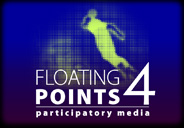
Here are the slides and notes for my Floating Points 4 presentation, Networked Participation.
I wanted to experiment with a web-friendly non-powerpoint program, so I ended up using Opera Show. This means that you can click on the link and see the slides and notes from any browser, but if you want to run the slideshow, you will need to open the page in the Opera browser (free download) and then press F11 (Windows) or go to View, Full Screen (Mac).
Floating Points 4: Participatory Media is a speaker series that addresses "the recent emergence of inexpensive, worldwide, and many-to-many publishing and communication media" and how these media "have transformed the relationship between cultural producers and consumers." Floating Points is co-presented by Emerson College and New Radio and Performing Arts, Inc. (NRPA), a not-for-profit media organization with offices in Boston and New York.
This event featured Trebor Scholz and myself. Future ones will include McKenzie Wark & David Weinberger, and a panel on Second Life with Wagner James Au (aka Hamlet Linden), John Lester (aka Pathfinder Linden) and John (Craig) Freeman (aka JC Freemont), moderated by Eric Gordon. Check out the program for more information. [blogged by Ulises Mejias on IDEANT]
Posted by jo at 05:22 PM | Comments (0)
More on Curating With Others (CWO)

Ruth Catlow on DIWO
Ruth Catlow wrote: A couple of days ago, Sarah Cook from the Crumb New-Media-Curating email list wrote...
In the meantime, perhaps someone from http can tell us how the opening of Do It With Others (Open Curation) went last night? I am curious about this model of exhibition making - where subscribers have a say (a bit like fans being asked to program the next All Tomorrow's Parties festival?) - does collaborative filtering create interesting results?
[...] I guess the thing to note in this context is that Furtherfield initiated the (DIWO) E-Mail-Art project so that "subscribers" to the NetBehaviour email list and the technologies they deploy are ALL artistic contributors to the project. Not sure I've identified ANY "fans" as yet; ))) The idea deliberately draws on the tradition of earlier Mail Art exhibitions in that the project started with an open-call and every post to the list, between 1st February and 1st April, is considered a work - or part of a larger, collaboratively created artwork. I can even imagine arguing that lurkers are also contributors. It's certainly true that the contributor:lurker ratio on the list has gone up from approx 1:25 (through January) to 1:4 (through February).
Historically Mail Art has a difficult relation to the old question about whether it belongs in a gallery (obvious eg Ray Johnson's "Dear Whitney Museum I hate you" mail art). What we try to explore and give room to in this approach to curating is a more dynamic and maleable context for the work. At HTTP we are in the fortunate position to be able to give space to this approach because of our relative informality, autonomy and independence, a decent-enough technical resource and our small but enthusiastic and broadly-skilled team of artist/producers and (for the time-being) curious and engaged visitors. Of course lots of people are not interested in all these different parts of the process. Many contributors prefer to leave the issues surrounding the display and dissemination of their artwork to others. But one of the reasons we chose to focus on the Mail Art theme was because of its reflexive nature. It considers all aspects of the artwork's passage through existing communication channels (through time and space) to the recipient(s) as contributing to the raison d'etre of the work. This is interesting to us as artists.
One danger that I can see of this approach of focusing on the curation and protocols of selection (especially with the current hoopla surrounding the so called democratisation of culture laid at the feet of networked tech) is that other aspects of the work can begin to be overshadowed. I'm not sure that many of the visitors to our (un)private view on Thursday evening were so interested in these issues or even in the particular technologies used. What seemed to grab people was the dynamic transformation and repositioning of materials and ideas as they flowed between approx 90 contributors.
The exhibition consists of "Threads" (series that directly involved mixing and dialogue, action and response) and "Streams" (of images, texts, movies instructions etc by single contributors) in print, sound, html, movie and text . Also a couple of installation works devised especially for the space. This was all argued and bashed out during our Sunday afternoon open-curating event. All submissions were sorted and categorised and displayed within a mailbox that was available for visitors to explore and redistribute (by clicking 'Forward Mail' ; )
From my perspective as a subscriber to NetBehaviour email list I find the process fascinating, informative, amusing and constantly surprising.
Then I gave links to some pics (lots more to the website soon).
Installation shot from early in the evening- Showing some printed "Threads" and "Streams"
Sim Gishel's 'Will Work For Food' - Vehicle drawing over an image of Marx's Grave in London
Projection of 'The Wreckers' a drawing produced within Dave Miller's online collaborative drawing software- being viewed by a visitor via the DIWO mailbox
Ruth [via netbehaviour]
Posted by jo at 09:25 AM | Comments (0)
March 02, 2007
Tobecontinued
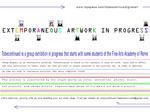
Myspace as an interactive platform
Tobecontinued is a group exhibition in progress that starts with some students of the Fine Arts Academy of Rome. Using Myspace as an interactive platform, Tobecontinued is based on the concepts of open art-work, cause and/vs effect, and free association of ideas; where the last art-work is always inspired to the previous one, in order to generate an open art-work in continuous evolution that never completes itself...
The process is constituted by the single works as video, animations, photos, music, net projects, and shows details, nuances and ideas of the whole art-work's project. Let's continue, joining with us and sending your art-work (max. 3 mb per email) at tobecontinued.tobecontinued[at]gmail.com" Random
Posted by jo at 11:22 AM | Comments (0)
February 27, 2007
Charles Leadbeater + The Carr-Benkler Wager
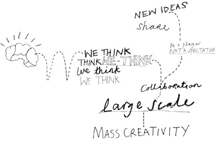
We-think
"Google is paying close on £900m for Youtube, a profitless business little more than a year old. Wikipedia continues to draw more traffic than much more established media brands, employing hundreds more people. Open source programmes such as Linux insistently chip away at corporate providers of proprietary software. Immersive multi user computer games, such as Second Life, which depend on high levels of user participation and creativity are booming. Craigslist a self help approach to searching for jobs and other useful stuff is eating into the ad revenues of newspapers. Youth magazines such as Smash Hits have been overwhelmed by the rise of social networking sites such as MySpace and Bebo. What is going on?
We-Think: the power of mass creativity is about what the rise of the likes of Wikipedia and Youtube, Linux and Craigslist means for the way we organise ourselves, not just in digital businesses but in schools and hospitals, cities and mainstream corporations. My argument is that these new forms of mass, creative collaboration announce the arrival of a society in which participation will be the key organising idea rather than consumption and work. People want to be players not just spectators, part of the action, not on the sidelines." Continue reading We-think.
What is the Carr-Benkler wager? by Charles Arthur, Thursday August 3, 2006, The Guardian:
Though sounding like something out of higher maths it's much simpler: a bet between two high-profile bloggers about whether in two years (or perhaps five) people will get paid for submitting content to sites like Digg and Flickr.
On the two sides: Nicholas Carr, a former executive editor of the Harvard Business Review; and Yochai Benkler, a professor of law at Yale University whose book, The Wealth of Networks: How Social Production Transforms Markets and Freedom, suggests that new types of collaboration let people be more productive than profit-seeking ventures.
Posted by jo at 09:36 AM | Comments (0)
February 24, 2007
Do It With Others (DIWO): E-Mail-Art at NetBehaviour

A Collaborative Exhibition at HTTP Gallery, London
Hi DIWOists,
The Furtherfield crew has been discussing ways to get the most out of the co-curating session on Sunday when we will discuss and experiment with ways of exhibiting the contributions at HTTP gallery (don't forget the opening is next Thursday).
Other known contributors to this process in the gallery on Sunday are Frederik Lesage and james[at]jwm-art.net, others are welcome. Please check back with the list at 1.30 on Sunday for details of thewebcast and public chat room where you can join the discussion online. Until then you can view a gallery floor plan and tech spec here.
So here is a summary of our considerations, proposals and a number controversies for your feedback!
CONSIDERATIONS:
1) How to Survey the Contributed Materials for the Curation Process: There have been over 600 posts to NetBehaviour since the start of this project and we have 2-5pm on Sunday to review and discuss how to present contributions. The main ways that we have for looking at work is:
- through our mailboxes
- through an index of attachments that can be view browser here
Your Suggestions Please: We would like your suggestions for any other (reasonably straight forward) way to order materials for review.
2) Categories - How to Order and Discuss Materials.
It would be useful to have some broad themes or categories to discuss. Here are a couple of possible categories with examples (and these really are just examples) of what we mean.
- Threads - discussions, exchanges, actions and responses eg Sachiko Hayashi's 'The Other Half',
- Collaborations and remixes eg RandomLab's reblogging and remixing, Michael Szpakowski's remix of Thomson and Craighead's 'Additions' image
- Digital becomes Material eg Sim Gishel has sent a 'Will Work For Food' vehicle, brian[at]netartguy's currency could be laser-printed as actual currency, Other works proposed for print, Other works actually sent to HTTP etc
- Proposals/ Instructions- eg Ant Scott's installation proposal, Glorious Ninth's Love Potions
- Generative/machine Art- eg. Sim Gishel's data-mining, ARN's generative pngs
- Stand alone streams - movies, soundfiles and images eg images by Clive McCarthy, lem urtastic - movies by Lizzie Hughes, Alan Sondheim - mp3s by james[at]jwm-art.net
- Texts eg Janedepain's recent 'Poetic Terrorism and Guerrilla Art in the 21st Century' and technical discussions.
PROPOSALS:
1) We propose that the main projection consists of a Mailbox containing a DIWO archive for searching by gallery visitors. This would be organised into themed directories that would coincide with the categories listed above. PLEASE SUGGEST: more or other categories.
2) We propose that we highlight and exhibit some 5-8 works (made by individuals or collaboratively) in the form of objects, printouts, projections and sound. These would be up for discussion and debate from this point - to be decided on Sunday.
CONTROVERSIES:
1) The question of selection - how do we create an exhibition in a physical space that communicates the DIWO spirit?
- how do we highlight a selection of works?
- how do we stay true to the open principle of including all submissions?
2) Contextualisation
- do some works need contextualising in order to be accessible to gallery visitors eg should some works be displayed with titles, artist, date, materials, description of process etc?
- if so how, and who does it?
3) Is everything that has been posted to NetBehaviour since February 1st considered a submission to DIWO?
- including announcements and reblogging?
4) A number of people have proposed works in private emails to Marc or myself- should these be included under the rules of submission?
Whoever wants to contribute to the curation of this show- share your views here on the list or come along on Sunday ttp://www.http.uk.net/DIWOcurating.shtml
Let's DIWO!
: ))
Ruth [via netbehaviour]
Posted by jo at 12:01 PM | Comments (0)
February 23, 2007
Experimental Gameplay: Toward a Massively Popular Scientific Practice
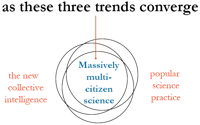
Massively multi-citizen science is almost here
Can a game developer be nominated for a Nobel Prize in one of the sciences by the year 2032? That's my plan, which I presented this past weekend at the annual meeting of the American Association for the Advancement of Science. You can download the slides from my talk, or read the related research paper (hot off the press!), or peruse some related links, on my AAAS webpage here. (Or see what Newsday took away from it here.)
My goal over the next decade is to support the development of a massively multi-citizen science through massively collaborative games (think: alternate reality games with real-world data embedded inside.) So in the near future, when the most creative, collective-intelligence gamers are grinding away 10, 20, 30, or more hours a week, they're grinding on real scientific research problems wrapped inside a yummy fictive or fantasy shell.
Yes, I am calling for a truly popular scientific research practice that engages the global public in hands-on, brains-on collaboration, via sites Citizen Science and Amazon's Mechanical Turk and through immersive, story-driven play. Amateur participation + a creative commons for science literature + the stickiness of a well-designed game and well-told story = radically interdisciplinary mash-ups accessible to lay people and productive of real scientific insight.
Sound crazy? No way. This is seriously possible, and plausible. Here's three reasons why:
1) Science practice itself is increasingly leaning toward a kind of collective intelligence, amateur participation. You can read about it in the incredible Institute for the Future report: Delta Scan: The Future of Science and Technology, 2005-2055.
2) Meanwhile, there is no doubt -- as I argue in my new 50-page case study for the MacArthur foundation -- that alternate reality gamers are doing real CI investigations that would fully prepare them for real-world collaborative research. Their gameplay is already fundamentally a CI scientific effort to undertand fake (fictive) data. I'm just proposing that we shove some real scientific data in there, while they're at it.
3) And perhaps most importantly, as Sean Stewart - the original and most esteemed alternate reality storyteller around - has famously said: "I do NOT assert that [alternate reality gaming] is the first, or greatest, example of massively multi-player collaborative investigation and problem solving. Science, as a social activity promoted by the Royal Society of Newton's day and persisting to this moment, has a long head start and a damn fine track record.... We just accidentally re-invented Science as pop culture entertainment."
So, yes, If this sounds interesting, get the slides. And here are a couple of other sites to get you thinking: "Fostering Scientific Habits of Mind in the Context of Online Play" and MacArthur Spotlight on Digital Media & Learning.
If you want to propose a data set, scientific problem, or research focus for a massively multi-citizen science game, or if you want to be notified when there's such a game to be played, email me at jane @ thenameofthisblog dot com. [bblogged by Jane on Avant Game]
Posted by jo at 06:00 PM | Comments (0)
February 22, 2007
Turbulence Spotlight
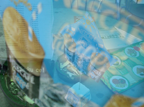
"Zeno Boundary" by Kevin Hamilton
Turbulence Spotlight: Zeno Boundary by Kevin Hamilton :: "Zeno Boundary" collects portraits of places regarded as public, created according to a prescribed photographic system. Images uploaded by contributors are dynamically animated into a looped sequence of pans and zooms through the space. The project originated in Spring 2006 as part of the Mobile Studios project, in cooperation with curators of the 13 Kubikov collective in Bratislava, Slovakia. After touring with Mobile Studios through Eastern Europe, the project continues as part of the 2007 Depauw Biennial Exhibition, in Greencastle, Indiana.
Kevin Hamilton currently teaches at the University of Illinois, Urbana-Champaign, where he is appointed to the Painting/Sculpture and New Media programs. Recent work has included co-organization of a symposium series about Walking, and the creation of interactive artworks for gallery and public settings. His scholarship includes research on manifestations of absence in contemporary and historical telecommunication technologies, and development of new methodologies for interdisciplinary collaboration. Kevin has exhibited or lectured at festivals and art institutions in Spain, Holland, Slovakia, Hungary, Canada, and the United States.
Posted by jo at 06:10 PM | Comments (0)
February 21, 2007
Networked Proximity - Section 5
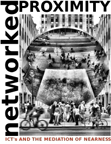
Networks and Social Change
The third of Mills’ criteria specified the necessity to transform opinions into action even against, if necessary, the prevailing system of authority. Although a thorough examination of the relationship between technology, agency, power and social change is beyond the scope of this study, I would like to make some general observations regarding the potential for using networks to promote social change. This attempt is relevant because if, as Mills (1956) suggests, a mass cannot really claim the agency to contest the prevailing authority, then to the extent that networked ICT’s are said to transform publics into masses, they can be said to stand in the way of authentic social change.
At the center of this issue are the ways in which networks in capitalist societies commodify social participation. Borgmann (2004), for instance, rightly points out that commodification is the distinguishing feature of the online social interactions that networks make possible. "To commodify something economically is to pull something that is outside of the market into the market" (p. 64), or in other words, to transform things with no monetary value into things with monetary value —or commodities— through their subordination to the logic of capitalism. Borgmann suggests that the commodification of the social happens when a social practice is taken out of its localized context and offered in a re-packaged format online. Thus, chatting becomes online chatting, dating become online dating, etc. Borgmann attempts to establish that networked sociality robs communities of their original meaning and commodify the cultural production of social space:
The Internet is culturally commodifying by its nature. It frees us from the limitations of space and time... What happens in fact is that commodification reduces ourselves and those we encounter on the Internet to glamorous and attractive personae. Commodification becomes self-commodification, but shorn of context, engagement and obligation, of our achievements and failures, of our friends and enemies, of all the features that time has engraved on our faces and bodies—without all that we lack gravity and density. (p. 64)
Continue reading "Networked Proximity - Section 5" » [blogged by ulises on ideant]
Posted by jo at 04:02 PM | Comments (0)
February 20, 2007
Now Art Grant

Call for Applications
Artists creating work that engages dialogue about current social issues will receive grant funds (minimum $500), three months mentorship by damali ayo, a second mentor who has specific experience in the project field, and the exposure to ayo's mailing list of over 3000 people.
Now Art holds that the primary role and responsibility of art is to mirror the dilemmas of society to its citizens, offering a catalyst for change and development; evolves as society evolves; values the artist's use of a wide range of media; integrates contemporary and emerging technologies; prizes the power of individuals to effect change, discarding divisions between personal and political; honors and engages the work of its predecessors, recognizing that art builds upon art.
Now Art Grants combine the small donations of many individuals and make these available to artists whose work creates art that catalyzes social change. These artists often work with no pay and slim budgets because the activist nature of their work is often dismissed as "not fine art" or because art remains devalued as a viable career choice by society. Members of the damali ayo and now art mailing lists donate any amount they choose to the grant pool. This money is combined and granted to artists who show their commitment to social change through their work.
The art created by Now Art Grants will have a component that is delivered directly to those who have donated the grant funds as a direct return of the funders' investment.
To be chosen to receive a Now Art Grant, the artist/art must:
* Take place outside of a gallery or limited-access space.
* Engage a wide audience in a dialogue about a current social issue.
* Have a component that delivers an aspect of the art directly to those who have funded it.
* Show ability to fully accomplish the proposed project over six months.
* The artist will be rigorously researched by the Now Art selection committee so that artists will not be required to spend critical art time writing extensive applications or budgets.
Projects can be created specifically for this grant money or can already be in process, as long as they are completed within the six month time frame. Money can be used for any aspect of the project including artist fees. Mentoring helps to assure the success of the project. Artists should send their project ideas and a short bio to nowart[at]damaliayo.com.
Grants will be made on a rolling basis. All artists who sign up on ayo's "now artists" mailing list at damaliayo.com or myspace.com/nowartists artists will receive regular information about various grants and support for artists engaged in social change.
Make a donation, ask a question, join the mailing list and apply by contacting nowart[at]damaliayo.com
Now Art is a mentality that art must be current, accessible and an agent of dialogue and social change. Many members of my audiences expressed frustration that they could not see my work, as it was housed in a gallery in one city often out of reach. I agreed. I dropped my art gallery and have devoted myself to creating art that provides accessibility, impact, and ways for individuals to participate and experience the work.
Now Art is immediate, accessible, participatory, low-cost, and deals with current issues that we face as a community/society. When you participate you create a dynamic moment- something that happens in the "now" and hopefully generates a cascade of thought and change for the future. I will send you concepts, instructions and sometimes even a full kit to enact each work. Your collaboration is what makes it work. Let's make art together. We're really going to have some fun. Sign up >>
Posted by jo at 02:08 PM | Comments (0)
February 15, 2007
Mute Vol 2 #4

Web 2.0 – Man's best friendster?
Mute Vol 2 #4 - Web 2.0 – Man's best friendster? :: Web 2.0’s democratisation of media produces a wealth of new perspectives. Some of those formerly excluded from the public sphere have the chance to make their voices heard. But this wave of participation is as important for business as it is for the newly included. Mute's Web 2.0 special uncovers the work in social networking and, behind the 'dotcommunist' spin, a centralisation of the means of sharing. Texts by Giorgio Agostoni, Olga Goriunova, Dmytri Kleiner & Brian Wyrick and Angela Mitropoulos. Additional articles by Brian Ashton, John Barker, Paul Helliwell and Merijn Oudenampsen
Swarm Forms: On Platforms and Creativity by Olga Guriunova :: Will the ‘hive mind’ of social networking replace classical forms of knowledge production? Comparing Web 2.0 and small-scale, self-run cultural platforms, Olga Goriunova maintains the possibility for originality in both contexts, while identifying how the same old commercial and institutional pressures still operate.
The Long Tale by Giorgio Agostoni :: Web 2.0 relies heavily on identikit forms of self-representation and sociability. Parallel to the ‘authentic’, self-promoting personae of MySpace, multi-user virtual worlds such as Second Life (SL) appear to offer a more malleable, playful version of life online. But as the imperatives of commercial exchange penetrate deeper into the networked imagination, is the gap between RL and VR what it used to be? Giorgio Agostoni reverse engineers material from across the net to construct a fictional readymade suspended between self-reinvention and self-management.
Posted by jo at 03:18 PM | Comments (0)
Many, many maps:
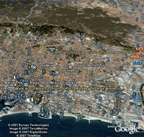
Empowerment and online participatory mapping
"The convergence of public participatory mapping and cybertography is having far-reaching impacts through a variety of creative applications. This paper presents three different types of Internet mapping applications — Google Earth and Google Map API, Common Census, and a design exercise in Second Life — with a public participatory geographic information system (PPGIS) and cybercartography perspective. Each of these examples empowers users in a different way. The spatial applications and the supporting information that is being made available through Internet map applications represent a unique set of examples of the democratization possible through Internet applications." Continue reading Many, many maps: Empowerment and online participatory mapping by David L. Tulloch, Frist Monday, Issue 12
Posted by jo at 02:54 PM | Comments (0)
February 05, 2007
Web 2.0 in just under 5 minutes
[via]
Posted by jo at 06:07 PM | Comments (0)
February 02, 2007
Allan Kaprow:

Kunst als leven – Art as Life
Allan Kaprow: Kunst als leven – Art as Life :: February 10 – April 22, 2007 :: VAN ABBEMUSEUM, BILDERDIJKLAAN 10, EINDHOVEN - THE NETHERLANDS :: 31 [0]40 238 1000 :: info[at]vanabbemuseum.nl.
Allan Kaprow, father of ‘happenings’ and ‘the most famous unknown artist’ died in April 2006. In association with the Haus der Kunst, Munich, the Van Abbemuseum organises the largest European solo presentation of the work of this American artist, displaying a development of almost 50 years of artistic work. The concept for this exhibition was developed together with the artist shortly before his death. Much of Kaprow’s art is special because it is interactive, intended to be carried out by people. The exhibition consists of a range of objects from Kaprow’s artistic legacy on view as well as a number of ‘happenings’ in which visitors can participate. The Van Abbemuseum’s artistic policy is to exhibit major overview exhibitions of artists from the sixties and seventies, who are the ‘classics’ of today.
The theme of the Allan Kaprow 'Kunst als leven – Art as Life' exhibition is the paradoxical question of how museums can display art in an appropriate manner in this day and age, while approaching real life with art as closely as possible. A range of objects from Kaprow’s artistic legacy will be displayed: early paintings, environments, video documents and photographs, as well as a fast array of original scores for his ‘happenings’ and ‘activities’.
This special presentation is not intended as an attempt to rewrite or document history, but to encourage visitors to see the ‘museum as mediation’. Kaprow was never interested in passively consumptive viewers but in active participation. The Van Abbemuseum is both a place of mediation and an agency of action. The exhibition will entail a re-enactment of a selection of happenings – on condition, however, that the visitors understand their new role and participate.
ALLAN KAPROW
Towards the end of the 1950s, American artist Allan Kaprow (1927-2006) coined the term ‘happenings’ for a new art form. A decade earlier, Kaprow had studied philosophy and subsequently art history with Meyer Shapiro in New York. At the same time he studied art with Hans Hofmann. It was while following composition classes with John Cage at the New School for Social Research in 1956/57 that he discovered he could use coincidence as well as everyday materials in his art. His work metamorphosed from expressionist scenes of figures through raw assemblies of materials to room-filling ‘environments’. With audiences participating, events took place in these ‘configured’ spaces from the late 50s onwards. Kaprow succeeded in doing what many painters and sculptors had endeavoured to achieve before him: the dissolution of the boundaries between art and reality. He accomplished the move into reality in such a radical fashion that his ‘happenings’ – which he later relabelled ‘activities’ – became indistinguishable from real life. During this process the artist drew back more and more from the institutions. To him, museums were burial chambers of art that no longer had anything to do with life.
HAPPENINGS
During the exhibition various happenings will take place in and outside the Van Abbemuseum. Participation is a must. For more information, dates and reservations, visit http://www.kaprow.org.
CURATOR
Exhibition concept: Eva Meyer-Hermann & Stephanie Rosenthal Van Abbemuseum exhibition curator: Eva Meyer-Hermann
The exhibition Allan Kaprow 'Kunst als leven – Art as Life' is a cooperation with Haus der Kunst, Munich, and co-sponsored by the Andy Warhol Foundation for the Visual Arts. The project has been carried out within the framework of TRANSFORM and with the support of the Culture 2000 programme of the European Union.
Posted by jo at 11:17 AM | Comments (0)
January 30, 2007
Art and Society:

The Work of Fred Forest
"Art and Society: The Work of Fred Forest" featuring Fred Forest :: Slought Foundation Exhibition :: Curated by Osvaldo Romberg :: February 03 - March 23, 2007 :: Reception: Saturday, February 03, 2007 ; 6:30-8:30pm :: Free admission (Reservation not required) :: A special seminar by Forest concerning his practice will take place immediately before the opening from 5:30-6:30pm, and will be moderated by Jean-Michel Rabate.
Fred Forest, "For an aesthetics of communication" (Plus Minus Zero, 1985): "I have always considered that the natural field of artistic production is the terrain of social activity. A field which may be enlarged and explored thanks to the new Communication technologies. This option upsets the holders of a fixed concept of aesthetics, who are incapable of grasping the obvious articulation between this type of practice, the concept of art, and a society in transformation. We are called upon to ask the question "Where are the frontiers of art situated?" It's a brave man who will stick his neck out! There is no frontier. Art is an attitude--
a way of relating to something, rather than a thing in itself. There is an aesthetics of behavior, an aesthetics of gesture, just as there is an aesthetics of object. We have now to take a new category into account: the aesthetics of Communication. The media of this aesthetics are often immaterial: its substance comes from the impalpable stuff of information technology. In the sky above our heads, the electrical signals of this information trace invisible, blazing and magical configurations."
Visit: http://www.webnetmuseum.org
Visit: http://www.fredforest.org
Fred Forest is a communication artist and theorist (born in Algeria in 1933) who has worked at the forefront of interactive art and new media, sociology, and institutional critique for over forty years. His work, frequently immaterial and relational, raises questions about the nature and function of art in a market-driven age of information. Forest has exhibited and presented at institutions including the Museum of Modern Art, New York; the Centre Georges Pompidou, Espace Pierre Cardin, and the Museum of Modern Art of the City of Paris; the Venice Biennial; Documenta 6 and 8 in Kassel, Germany; the Foundation Miro, Barcelona; and the C.A.Y.C./Center for Art and Communication, Argentina. Fred Forest recently created the "Digital Street Corner" at the invitation of Art Basel Miami Beach 2005, in conjunction with the Cartier Foundation for Contemporary Art, Paris, and the Bass Museum of Art, Miami. This interactive network, artistic environment and "virtual happening" was co-created in real time by people on the internet, which Forest in turn choreographed and projected on an outdoor screen on the exterior wall of the Bass Museum (http://www.fredforest.com/). Also in 2005, Forest was commissioned by the National Audiovisual Institute (INA) of France to create "Memory Pictures," a website and installation, for the Great Hall in the French Ministry of Culture. In this work, the artist, digital avatars, and anonymous participants create collaborate collage works of art. In 2006, Forest launched "The Biennale of the Year 3000," a participatory new media intervention staged against the "official" Sao Paulo Biennale that took the form of an exhibition without curatorial selection.
As early as 1967, Forest organized a series of participatory and community-based art activities which laid the foundations for the "Sociological Art" movement to follow. By 1969, Forest was known as the first French "plastic" artist to make extensive use of video art and carry out one of the first installations of this type at the Sainte-Croix Gallery in Tours, France. In 1972, continuing his research into this medium, he purchased media space in the French national newspaper "Le Monde," and launched a series of "press experiments" which extended from journalism to television and radio both in France and abroad. In 1973 his work in mass-communications won him the Communications prize at the XIIth Biennale in Sao-Paulo, Brazil, and in 1974 he co-founded the "Sociological Art Collective" whose activities were eventually featured in the 1976 Venice Biennale. Forest also participated in Documenta 6 in 1977, and exhibited a field frequency of 14,000 hertz in the Fredericanum in Kassel, Germany in Documenta 8 in 1987. Following the dissolution of his sociological collective, Forest staged various art actions and exhibitions, frequently involving the late Pierre Restany, such as The Artistic Square Metre, The Stock-Exchange of the Imaginary, at the George Pompidou Centre, and The Communicative Space at the Museum of Modern Art of the City of Paris. In 1982 Forest formulated the term "Communication Aesthetics," and in 1983 Fred Forest co-founded the International Group for Research into Communication Aesthetics, to explore new directions for art centered on problems of communication, new models of anthropological behavior, and our evolving relationship with a world conditioned by technological developments.
This exhibition has been curated by Osvaldo Romberg with the generous support of l'Institut National de l'Audiovisuel, the Cultural Services of the French Embassy in the United States, and the School of Arts and Sciences and the Department of English at the University of Pennsylvania. Please note that an interview with the artist is available online on the Slought Foundation website.
Posted by jo at 04:50 PM | Comments (0)
January 23, 2007
Prospero – A “Visual Commons” Framework
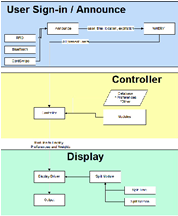
for Community-Aware Public Displays
Information about the community as a commons and about commons in the community can be useful for promoting a sense of shared fate and shared identity. In addition, as mobility increases, information about how a community moves into, out of, and through its spaces (such as public commons) can be a useful source of community feedback. A new project at the University of Michigan investigates using public displays to understand and represent community dynamics and preferences:
Prospero is an infrastructure to enable public displays to reflect evolving public participation. The objectives of the Prospero project arise from two primary motivations: one descriptive, the other normative. First, technologies that foster cooperation enhance our relationship to our surroundings. Many of these technologies incorporate user feedback in real-time.
Second, our team members believe that a society in which collective decision-making is based on participatory democracy and public resources should be allocated not by top-down or centrally-controlled mechanisms, but on the basis of the expressed desires and needs of participants. As cooperation increases, we have seen a resurgence of "the commons," i.e. that public sphere in which community values are expressed.
In our project, we shall explore this theme through its instantiation in the specific domain area of public displays. In much of modern life, public spaces, public media and public art are designed to send us messages that we passively receive, process and absorb. However, we believe that in a democracy, citizens must actively shape the public sphere. This necessitates "talking back" to the elements that constitute the public sphere. Public displays, that is, displays located in public spaces and accessible to a public, constitute an increasingly important element of the public sphere. We will develop an infrastructure for community-aware public displays that are controlled by users' expressed needs and preferences; we see our endeavor as part of an ongoing, democratic reclaiming, by citizens, of control over an increasing number of aspects of the public sphere in general.
Thus, by making a public display that is attentive to its community of users, a Visual Commons, it becomes possible for the community to escape the present hegemony of one-way communication, or "broadcast," of generic information (such as the time, or stock prices) or the barrage of mass-media advertising (such as occurs in New York City's Times Square). In effect, dynamic processing of community feedback regarding the contents of the display enables it to become more than just a billboard. [blogged by Paul Hartzog on Smart Mobs]
Posted by jo at 06:04 PM | Comments (0)
The Electric Sheep Screen-Saver

A Collective "Android Dream"
Electric Sheep is a free, open source screen saver run by thousands of people all over the world. It can be installed on any ordinary PC or Mac. When these computers "sleep", the screen saver comes on and the computers communicate with each other by the internet to share the work of creating morphing abstract animations known as "sheep". The result is a collective "android dream", an homage to Philip K. Dick's novel Do Androids Dream of Electric Sheep. Anyone watching one of these computers may vote for their favorite animations using the keyboard. The more popular sheep live longer and reproduce according to a genetic algorithm with mutation and cross-over. Hence the flock evolves to please its global audience. You can also design your own sheep and submit them to the gene pool. [via]
Posted by jo at 05:57 PM | Comments (0)
m-DAT presents:

The Hack-Able Curator
m-DAT presents: The Hack-Able Curator project :: 19 Jan - 18th March 2007 :: Plymouth Arts Centre, as part of the SLOW exhibition.
The 'Hack-Able Curator' is a playful interpretation of the curating system that includes a robotic arm making curatorial decisions. By using an algorithm it chooses images from the popular photo-sharing website Flickr. It is 'hack-able' because everyone can add images to the main resource by uploading them to Flickr or by voting for any images displayed on the website by sending a SMS message to the system. In both ways, the general public can influence the decision the robot curator makes. The intention is to facilitate discussion about new challenges and new possibilities for curators. The project asks whether the availability and popularity of social technologies suggests that the curator is redundant or indeed whether everyone is now a curator of their own images?
The Project has been produced by Anita Barwacz, Lindsey Bedford, Andy Bennett, Anaisa Franco, Martha Patricia Nino, Richard Wilkes (m-DAT 2006-7).
m-DAT (Digital Art and Technology) is a hybrid masters programme that integrates theory and practice of digital cultural production, and offers MA, MSc and MRes awards (University of Plymouth).
Posted by jo at 09:40 AM | Comments (0)
January 22, 2007
Dear Internet v1.
![]()
Networked Technologies and the Paradoxes of Social Relations
In preparation for an upcoming exhibition at Maryland Art Place (MAP) Dear Internet --a project by Mark Cooley and Edgar Endress--will be accepting letters via Dear Internet. Dear Internet v1. investigates how networked technologies become platforms for the paradoxes of social relations in digital culture. Connection, fear, communication, alienation, interactivity, dislocation, intimacy, disembodiment, are all possible and often simultaneously present in our attempts to interact with others online and off.
The installation: A live screening of Dear Internet develops, with the help of participant input, over the course of the exhibition and serves as a partial expression of networked consciousness. Content for Dear Internet v1. is collected from 2 primary sources:
- A participatory blog that forms a collective memory of "users" experience in networked living. Dear Internet (the blog) is an unmoderated site for the publishing and archiving of letters written by Internet users concerning their relationships with the Internet. Through http://dearinternetuser.blogspot.com, users may address the internet directly and indulge in their deepest thoughts, feelings and fantasies with the abandonment, comfort and protection that only online anonymity can provide. Texts gathered from http://dearinternetuser.blogspot.com are remixed and projected in the gallery while they are read with text to speech software.
- Live IP surveillance cameras are accessed using a variety of well-known advanced google search techniques and projected in the gallery space. While these surveillance cameras are accessible to any internet user, they remain largely unknown to casual internet users. However, the cameras have attained significant attention from hackers, technophiles, security professionals, bored surfers and others. The interest no doubt comes from the common presumption that these surveillance cameras are left unsecure unintentionally by camera owners who have neglected to set-up camera security features. Internet users are often able to access full control of an accessed camera's, zoom, pan, snapshot and other features. Camera controls are removed from the interface for the Dear Internet installation and the cameras are set to refresh every 30 seconds.
Posted by jo at 02:24 PM | Comments (0)
January 18, 2007
New Media Literacies

Training Kids With Skills For Participatory Culture
HISTORICAL EVOLUTION :: Ancestor: Oral Culture :: Residual: Print Culture :: Dominant: Mass Media :: Emergent: Participatory Culture
The above refer to media systems. Media systems consists of communications technologies and the social, cultural, legal, political, and economic institutions, practices, and protocols which grow up around them. In each case, the emergence of a new media system does not simply displace what came before. Instead, the new media system becomes an additional layer in an ever more stratified media ecology.
Missing here is the concept of visual culture -- which can trace its history as far back as oral culture but has historically existed in the orbit of the other media systems. So, cave paintings are believed to have existed in relation to oral culture; stained glass windows and tapestries bridged between oral and print culture; comics exist inside print culture but emerge alongside other mass media, etc.
THE CURRENT MEDIA LANDSCAPE
Innovative -- a period of prolonged and profound technological change; new media are created, dispersed, adopted, adapted, and absorbed at dramatic rates.
Transformative -- a phase of social and aesthetic experimentations as the society absorbs and often anticipates new media technologies.
Convergent -- communication gets organized across multiple channels on both the corporate and grassroots level.
Multimodal -- the same story may be encountered in multiple representations.
Global -- media enables interactions between people around the world which has both positive and negative impacts on local cultures.
Networked -- Media technologies are interconnected so that messages flow easily from one place to another.
Mobile -- people can carry their communications technologies around with them
Appropriative -- new technologies make it easy for people to archive, annotate, appropriate, and recirculate media content.
Participatory -- A blurring of the lines between consumer and producer, a growing emphasis on social affiliations and active engagement around media content.
Collaborative -- the emergence of new structures of knowledge and creativity which depend on shared problem-solving and deliberation.
Diverse -- the walls between cultural communities break down as media flows across various sites of production and consumption within the context of a multicultural society.
Domesticated -- Media technologies are fully integrated into our everyday social interactions.
Generational -- Sharp differences between generations in terms of access to knowledge, cultural tastes and interests, and forms of participation and learning.
Unequal -- Access to technologies, skills, and opportunities for participation are unevenly distributed across the population. More >> [via empyre's current discussion what needs to be done (Skills For Participatory Culture)]
Posted by jo at 03:54 PM | Comments (0)
empyre: what needs to be done (Skills For Participatory Culture)

the paradox of critiquing the system one is working within
"...However, if Peter Buergel is referencing the formation of new art markets that reflect, as well as translate, globalism we must ask where individual artists see themselves within this frame. I sense a reticence for artists themselves to step forward – individually - as if only the curator / dealer / collector / critic / marketplace can ensure their identity and success. This is becoming more and more evident in the online realm as the proliferation of portals take on the role of cultural gatekeepers amidst our information overload. It is these external market bearers who then provide the only languages necessary to be translated. More often than naught, they reflect the branding of the material world. Relatively speaking and afraid of re-inscribing a cliché, most artists that I know are not particularly sophisticated or savvy when it comes to developing effective agency, external relationships, social engagement, or the implementation of the strategies associated with politics and business, etc. In fact, I often witness the self-protective cocoon of the great shrinking artist when it comes to this realm. But, increasingly we cannot remain nestled into the warmth of our complacency within the 21st c.
BUT a number of self-identified and non self-identified (ie. the folk artists of "you tube") artists I know do possess the intrinsic and incalculable abilities of incisive perception, cogent and distinct analysis, representational strategies, and a discerning capability to impart significance. The convenient cliché is that our creativity and inspiration needs to guarded from the pedestrian forces that govern us. However, we are often babes wondering through the dark woods of the socio-economic sphere – and we seem to like it that way. Our deliverance is that as babes, we do not yet know fear and subsequently, are not afraid to act. And … act we must. But we must do so all the time recognizing the agreement to which we have already signed.
As an artist – as a cultural producer – for some time now my question has always been, how am I complicit i all of this? How can I make sense of what is it that do and where I do it ? How am I unwittingly and wittingly reliant on late capitalism and institutionalization for my identity? Back in the early/mid 80’s (when I was actually a baby myself) I collaborated on some video art pieces including, "Perfect Leader," which was then coined “television art” as it self-reflexivity was a crucial conceptual underpinning. The uncomfortable position (which to this day makes me squirm) is the paradox of critiquing the system one is working within, the same one which enables one’s production ... and, of course, one is then still being sheltered and fed by that overarching structure. Can that still be considered a critique or is it merely a shape-shift into mimicry or worse yet, a feckless form of adolescent rebellion?
As a friend keeps reminding me …. this can only happen in the art world. If this is true ( just for the moment lets consider this position ) how then does one take that knowledge, that cultural transfer and remain viable outside the context of the art world? Is it indeed preferable and/or necessary? It strikes me that various art systems have remained in a state of arrested development or arrested maturation - due to a blatant dependency upon a system of patronage, market dynamics and fluctuations, as well as a hermetically sealed, popularly-rendered mystique of difference and alienation.... and in the midst of all of this, I continue to ask myself what is to be done ... what can be done ... what should be done?
But then I also ask myself… is this simply binary – is everything only seen as 0 and 1 s, black or white? I find myself going back to graduate school cultural studies and revisiting Foucault whose strength laid in his ability to concurrently occupy the inside and outside. He just seemed to do it as if it were the most natural thing to do in the world. It is a position which I have struggled to make my own and it provides a priceless instrument with which to inhabit a world increasingly based on the regulatory, binary thinking of categorization engendered by the advance of technologies and the information implosion.
[from Christiane Robbins, empyre's current discussion what needs to be done]
Posted by jo at 03:05 PM | Comments (0)
January 15, 2007
NUWeb A project for Web 3.0:

for the user, by the user, of the user!
NUWeb: A project for Web 3.0: for the user, by the user, of the user!
Taiwan's National ChungCheng University announced, in a press conference held in Taipei on December 27, a Web 3.0 project with a goal to build a new Web that is for the user, by the user, and of the user. Prof. Sun Wu, the leader of the project, said, "In Web 1.0, contents of the Web were provided by Content Service Providers (CSP) such as news companies or general institutes who set up websites to provide the information service, while the users are purely information consumers. In Web 2.0, many web service providers, such as Myspace, blogger, Youtube, Flickr, digg, Wikipedia, etc., set up websites that allow the users to participate in community sharing and collaboration, so the users are no longer purely information consumers, they are also the content providers. In a sociological sense, Web 2.0 is an era that the Web is for the user and also by the user."
"However", Professor Wu continued, "The Web 2.0 era still have some serious problems that makes it far from being an ideal Web era, so there is a need for the Web to move on to its next stage."
"Although the Web was once dreamed to be a Utopia, the cruel fact is that the Web is now basically in the hands the commercial power. More extremely, the Web is now dominated by the super empires: Google, Yahoo!, and Microsoft, which control over 80% of the Web power. Most Net users are basically living on the free services provided by the super empires in the Web, yet ironically, such services are for the purpose of making money. The dominance problem causes two other serious problems, the autonomy and the privacy problems. As the Net users rely more and more on these super portals, their personal data and privacy are at stake, being potentially utilized for monetization, or even worse, being leaked out to criminal groups. As the service platform is owned by the service providers, the users do not have autonomy. They have to agree to an unfair TOS (terms of service) before they are entitled to receive the service. When YouTube was sold for 1.6 billion US dollars, its users have no say and no share at all even though the value of YouTube was created by tens of millions of "You" in this Tube."
"Info-sharing which is the most attractive feature of the Web is still limited and sometimes inconvenient in the Web 2.0 era. For example, the Net users very often have to take a lot of effort to upload pictures or other stuff to the web service sites, which could be time consuming or cumbersome. As the servers have space limitation, the sharing is limited by size too. Such tedious processes and the size limitations sometimes would discourage the information sharing at all. For example, for a group of friends who join a trip together and return with giga bytes of pictures and videos, it will be a headache as to how to share those multimedia files"
"All the above-mentioned problems, the dominance, autonomy, privacy, and limitation of sharing, all come from a common cause: the fact that the Net users do not have a powerful web server of their own and do not have their own Web", observed Professor Sun Wu.
Because website is the main platform for information sharing as well as other Web activities, owning no website means having no power and no property in the Cyberspace. That is the root of the problems.
"Our solution is the NUWeb project", said Prof. Wu with a smile. "NUWeb, which stands for Net User's Web, is a new Web system for the Net users. It is a project to pursue the Web 3.0 idealism. It will empower the Net users by providing a software that will turn the user's PC into a high power Web service site through which the users can conduct information sharing, community service, blog publishing, etc., in a much more efficient and convenient way, with virtually no size limitation and with full autonomy of their own."
"In our opinion, Web 3.0 is a social revolution in the Cyberspace to pursue democracy; a Web that is for the user, by the user, and of the user."
"Technically speaking, NUWeb is a user-centric software. It is a decentralized portal and information system aiming at providing a more efficient and effective information sharing, community service, and information management."
"NUWeb is composed of three main subsystems: NUWeb PP: A personal information and service platform for the users to set up their own portal right on their PCs. NUWeb CP: A community portal system, and NUWeb.cc, the community center of the NUWeb Cyberspace.", "With NUWeb, the users can set up their own websites in a few minutes easily without the need to apply for URL and without the need of knowledge for website administration."
"As the web server is resident in the user's own PC, the users have full control of the sharing regarding what to share and who to share, without the file size limitation. The users not only have a higher flexibility and capacity in the sharing, but also have a platform for managing the sharing with a full access control mechanism".
"On the other hand, the portal nuweb.cc will be a federation of the regional portals and the personal portals". Like YouTube, Flickr, et. al., it will allow the users to participate and share their content. However, the Web 3.0 community portal makes a big difference in that there will be virtually no size limitation and that the community will be owned and governed by all the users."
"It will be a long way to go to really fulfill the idealism of Web 3.0", commented Prof. Wu, "To successfully return the Web to the Net users, we need user's power!", "Only after the users are sufficiently empowered, and only when the user's power are unified together, can we successfully break the unjustified dominance in the Web and return the Web to all the Net users."
"NUWeb is a project for public interest and the source code will be open when the software is released", concluded Prof. Wu, "We wish that there will be more teams to participate in this Web revolution and we wish to seek supports and collaborations from all sectors, such as the government, universities, non-profit organizations, etc., around the world to work together for an ideal Web 3.0."
The URL of the NUWeb project is at http://www.nuweb.cc/
December 27, 2006 Photos from the Event
See also: http://www.nuweb.cc/tw/index-c1.htm
[via nettime]
Posted by jo at 05:41 PM | Comments (0)
January 10, 2007
[iDC] The Ethics of Leisure

Judith Rodenbeck
I'm interested in juxtaposing this deceptively simple remark on participation by Jean Burgess:
"And, as others have suggested, probably one of the most pressing issues is the tension between the idea of participation as agency or enfranchisement, and participation as a form of free labour that is required before we even appear to _exist_. An opposition that is probably too stark in the face of real experience, but some of the debates around this stuff at least tend to assume it exists."
with the recent discussion of continuous partial attention. In particular I've been troubled by one aspect of the discussion on this list, which seemed to be a growing valorization of continuous partial attention (as some kind of new paradigm, as productive hyper-channeling, or whatever). The refreshing honesty of those posters, pressed for time, who admitted that they (as I do) skim and toss longer posts--or "filter" in Trebor's anodyne usage--made me think about various other "filters."
I don't necessarily want to return to the gender discussion of several months ago. But anyone who has ever been around children, and especially anyone who has ever been responsible for them, will understand "continuous partial attention" as a description of that situation. Continuous partial attention is THE condition of active parenthood. And for better or worse this--to borrow from Jean, a "form of free labour that is required before we even appear to _exist_"--is still a predominantly female situation. There is no doubt in my mind that sexism has retrenched itself in the developed world in the last two decades--vide, e.g., the new "family friendly" health minister in Germany, French crowing about having Europe's highest birthrate, England's positive fetishism of motherhood, and of course the "family values" of the US, all of which come (pace excellent government-sponsored childcare in France) fully packaged with the encouragement to women to "be all you can be" and stay at home (or worse, in a kind of social psychosis evident in the US media in Martha-Stewart housekeeping mania or Dr.-Laura fulminations against "bad wives").
It troubles me, then, that one discursive "filter" in this small, virtual arena seems to have to do with real conditions in meat-space--and in the case of "continuous partial attention," with a highly gendered experience of the world. Who writes? Who lurks? Who produces those lengthy posts that others have no time to read? What gets valorized and on what terms? What situations get elided or filtered?
My sabbatical is being eaten up servicing other people's writing. When it's over I will be servicing other people's children. "Leisure time" means finding something to eat or spending time with my partner and...her children. Vacations involve research. "We want shit jobs for peanuts" indeed! How about you?
Judith
iDC -- mailing list of the Institute for Distributed Creativity iDC[at]bbs.thing.net http://mailman.thing.net/cgi-bin/mailman/listinfo/idc
List Archive:
http://mailman.thing.net/pipermail/idc/
Posted by jo at 08:20 PM | Comments (0)
January 09, 2007
Embracing the Inevitable
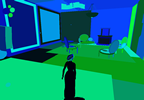
Second Life, now Open Source
In 1993, NCSA released their liberally licensed, but proprietary, Mosaic 2.0 browser with support for inline images arguably heralding the start of the web as we know it today. In an act of either acceptance of the inevitable or simple desperation, Netscape Communications released the bulk of the Netscape Communicator code base to form the foundation of projects as Mozilla, Firefox, and Thunderbird.
We are not desperate, and we welcome the inevitable with open arms.
Stepping up the development of the Second Life Grid to everyone interested, I am proud to announce the availability of the Second Life client source code for you to download, inspect, compile, modify, and use within the guidelines of the GNU GPL version 2. Continue reading Embracing the Inevitable - Second Life, now Open Source [posted by marc garrett on netbehaviour]
Posted by jo at 10:22 AM | Comments (0)
January 02, 2007
[iDC] The wrong kind of youth and distributed capitalism

We need an ethics of participation!
"...We need an ethics of participation! That's part of participation literacy. Do I let myself being taken advantage of by those who pull the strings behind sociable environments? "Why would I not help out Amazon.com by writing book reviews for them (?), they sold great books to me." I heard this puzzling logic from a young student. I paid and therefore, in return, I give my labor away for free. (It's of course more complex than that as arguably these reviews serve the public as well.) Another example:
In mid-December at the LeWeb 3 conference in Paris a disconcerting project was launched: YAADZ. To the realm of viral video and guerrilla marketing you can now add this site that offers "video advertisement by the people who watch them." YOU AD[Z]. Somebody who loves Reebok shoes can now create their own video ad and upload it too. And it's free. They don't even have to pay for giving their immaterial labor away for free. http://www.yaadz.com
Critical participation literacy will make kids aware that projects like this exemplify the self-exploiting hell of distributed capitalism. (Many of them lack totally this criticality.) They have no hesitation to "outsource" their photo memories to Yahoo (Flickr) or to leave all their daily life traces with Rupert Murdoch (MySpace). The ethics of participation need to be taught.
In a recent survey that I conducted, a participant (age 18) stated that she wears MySpace and YouTube like clothes. "They are an extension of my identity," she said. If social networking sites are an expression of identity, then we need to teach a critical awareness of the environments in which kids hang out online. Students may be aware that it is uncool to wear Abercrombie & Fitch but they don't hesitate to trust MySpace with their life. (Abercrombie & Fitch was accused of discrimination against minority employees-- 2004 lawsuit Gonzalez v. Abercrombie & Fitch)..." From [iDC] The wrong kind of youth and distributed capitalism, Trebor Scholz
iDC -- mailing list of the Institute for Distributed Creativity iDC[at]bbs.thing.net http://mailman.thing.net/cgi-bin/mailman/listinfo/idc
List Archive:
http://mailman.thing.net/pipermail/idc/
Posted by jo at 05:20 PM | Comments (0)
Placeblogger.com launches:
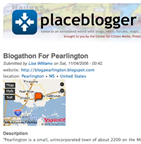
searchable index of local blogs
Snip from Placeblogger.com's "about" page: What's a placeblog? A placeblog is an act of sustained attention to a particular place over time It can be done by one person, a defined group of people, or in a way that’s open to community contribution It’s not a newspaper, though it may contain random acts of journalism It’s about the lived experience of a place.
Placeblogs are sometimes called "hyperlocal sites" because some of them focus on news events and items that cover a particular neighborhood in great detail -- and in particular, places that might be too physically small or sparsely populated to attract much traditional media coverage. Because of this, many people have associated them with the term "citizen journalism," or journalism done by non-journalists.
Placeblogs, however, are about something broader than news alone. They're about the lived experience of a place. That experience may be news, or it may simply be about that part of our lives that isn't news but creates the texture of our daily lives: our commute, where we eat, conversations with our neighbors, the irritations and delights of living in a particular place among particular people. However, when news happens in a community, placeblogs often cover those events in unique and nontraditional ways, and provide a community watercooler to discuss those events.
Link to Placeblogger.com. If you maintain a "hyperlocal website," and it's not already in the index, you can submit it for consideration here: Link.
Jay Rosen (an advisor to the project) writes about the launch here, and there's a Poynter item by Amy Gahran here. [posted by Xeni Jardin on Boing Boing]
"Lisa Williams' PlaceBlogger launched today. It aggregates blogs that are about the places where the bloggers live. Unlike Steve Johnson's Outside.in, it is hand-assembled and it focuses on bloggers writing about where they live; Outside.in maintains a list of placebloggers but it also aggregates posts about places no matter the location of the people who wrote them. That gives PlaceBlogger a certain intimacy and the potential to seed local communities of bloggers, while Outside.in is better site if you're trying to find everything said about a location. It also means that, especially at the outset, Outside.in has more stuff, while PlaceBlogger feels a bit sparsely populated...so pitch in and add to PlaceBlogger the placeblogs you rely on.
I love the idea both these sites pursue, knitting the virtual with the real, words with dirt." David Weinberger
Posted by jo at 10:57 AM | Comments (0)
December 27, 2006
future of the filter
![]()
The "Corporatization" of User-Generated Content
An article by Jon Pareles in the Times (December 10th, 2006) brings to mind some points that have been risen here throughout the year. One, is the "corporatization" of user-generated content, the other is what to do with all the material resulting from the constant production/dialogue that is taking place on the Internet.
Pareles summarizes the acquisition of MySpace by Rupert's Murdoch's News Corporation and YouTube by Google with remarkable clarity:
What these two highly strategic companies spent more than $2 billion on is a couple of empty vessels: brand-named, centralized repositories for whatever their members decide to contribute.
As he puts it, this year will be remembered as the year in which old-line media, online media and millions of individual web users agreed. I wouldn't use the term "agreed," but they definitely came together as the media giants saw the financial possibilities of individual self-expression generated in the Web. As it usually happens with independent creative products, large amounts of the art originated in websites such as MySpace and YouTube, borrow freely and get distributed and promoted outside of the traditional for-profit mechanisms.
As Pareles says, "it's word of mouth that can reach the entire world." Nonetheless, the new acquisitions will bring a profit for some while the rest will supply material for free. But, problems arise when part of that production uses copyrighted material. While we have artists fighting immorally to extend copyright laws, we have Google paying copyright holders for material used in YouTube, but also fighting them.
The Internet has allowed for the democratization of creation and distribution, it has made the anonymous public while providing virtual meeting places for all groups of people. The flattening of the wax cylinder into a portable, engraved surface that produced sound when played with a needle, brought the music hall, the clubs and cabarets into the home, but it also gave rise to the entertainment business. Now the CD burner, the MP3, and online tools have brought the recording studio into the home. Interestingly enough, far from promoting isolation, the Internet has generated dialogue. YouTube is not a place for merely watching dubious videos; it is also a repository of individual reactions. Something similar is happening with film, photography and books. But, what to do with all that? Pareles sees the proliferation of blogs and the user-generated play lists as a sort of filter from which the media moguls are profiting: "Selection, a time-consuming job, has been outsourced. What's growing is the plentitude not just of user-generated content, but also of user-filtered content." But he adds, "Mouse-clicking individuals can be as tasteless, in the aggregate, as entertainment professionals." What is going to happen as private companies become the holders of those filters? [posted by sol gaitan on Future of the Book]
Posted by jo at 08:20 PM | Comments (0)
December 20, 2006
Transit
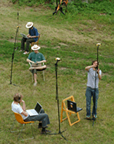
Mental Maps and the Networked Urban Space
Transit by KLAUS FILIP & NICOLAJ KIRISITS :: There is no doubt that within a few years urban space will be fiilled up with invisible data. Digital Communities will be located in real space. The internet will be extended by a geospatial network. All you'll need is a mobile interface (cellphones) to get involved with the communities / information / networks at certain places within the city. But what does that mean for the face of the city?What kind of mental map will we have from the geospatial networked based urban space?
As Kevin Lynch (1960, the image of the city) researches the legibility of urban space, Transit tries to find out the legibility of digital communities in urban spaces. For that proposition we built up an example of this digital urban space on a free field at the Kleyehof (Burgenland) with 25 invited Media artists. The Elements of that digital sculpture were text, video, sound and digital code, spatial located by using gps tools. The grid elements could be connected, to set up different networks.
The Objects are based on a spatial Masterplan, situated in a 3D grid of 1 to 1 to 1 meter; 20 meters long, 20 meters wide and 3 meters high), which defines private area (everyone can see-hear what you do but only you can change it), public (everyone can schange the data), and free spaces.
Transit was part of the podspot project at the University of applied arts vienna / department of digital art. [via Rhizome]
Posted by jo at 04:34 PM | Comments (0)
December 18, 2006
MYSPACE TOP 8 GALLERY
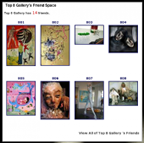
Art in the Age of Virtual Reproduction
Forget the institutions of yesterday, the Guggenheims and Tates, the Kunsthalle and Venice Biennale. In the internet age, with the creative expressive technologies of Web 2.0, and the naming of lonelygirl15 as Time’s Person of the Year, surely we have arrived at Joseph Beuys’ future fantasy when he prophesied that ‘everyone is an artist’.
In a new spirit of ‘Everyone is an Artist’, we are pleased to announce the launch of TOP 8 GALLERY – the art gallery for a new mixed reality world. MySpace is currently the most populous online community in the world. Originally associated with Music, MySpace has recently expanded its media ecology to include Film, Videos, and Comedy. Yet there is still no category for ‘Artist’. In MySpace, ‘artist’ only refers to a music artist. Top 8 Gallery seeks to redress this radical omission.
In acknowledgment of the millions of individuals making art (and here we are very expansive in our conception of art) here in MySpace, Top 8 Gallery has arisen to bring to the MySpace Public a new breed of artist and art. Our Gallery endorses ‘Art in the Age of Virtual Reproduction’.
Top 8 Gallery only features artists with a MySpace presence. Artists are chosen on the basis of their work represented in MySpace. Top 8 Gallery is a new media curatorial experiment. Members of the MySpace Public are chosen to curate Top 8 Gallery Exhibitions. Each exhibition features 8 artists via 8 separate MySpace Accounts that are displayed in the master Top 8 Gallery Profile. Exhibitions change on a monthly basis. MySpacers are invited to propose curated exhibitions entirely based on your favorite Top 8 MySpace artists.
We hope you enjoy the inaugural selection of artists carefully selected for the launch of Top 8 Gallery.
Posted by jo at 04:45 PM | Comments (0)
You -- Yes,

You -- Are TIME's Person of the Year
"... But look at 2006 through a different lens and you'll see another story, one that isn't about conflict or great men. It's a story about community and collaboration on a scale never seen before. It's about the cosmic compendium of knowledge Wikipedia and the million-channel people's network YouTube and the online metropolis MySpace. It's about the many wresting power from the few and helping one another for nothing and how that will not only change the world, but also change the way the world changes.
The tool that makes this possible is the World Wide Web. Not the Web that Tim Berners-Lee hacked together (15 years ago, according to Wikipedia) as a way for scientists to share research. It's not even the overhyped dotcom Web of the late 1990s. The new Web is a very different thing. It's a tool for bringing together the small contributions of millions of people and making them matter. Silicon Valley consultants call it Web 2.0, as if it were a new version of some old software. But it's really a revolution." From You -- Yes, You -- Are TIME's Person of the Year by Lev Grossman
Posted by jo at 08:04 AM | Comments (0)
November 25, 2006
Futures of Entertainment
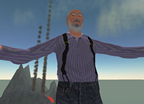
New Media, Fan Muscle will mold TV future
[Image: Henry Jenkins' Second Life avatar] How will we enjoy entertainment in the future? Via a high-definition plasma TV screen, computer, cellphone or iPod? Who will create entertainment? Will it be mega studios, independent producers or the whiz kid on his laptop--or a network of whiz kids? And who will watch the result when the audience is also the writer, critic and marketer?
Experts--from network executives, academics and game designers to gadfly media artists--peered into the "Futures of Entertainment" at a two-day conference, Nov. 17-18, sponsored by the MIT comparative media studies program and the Convergence Culture Consortium. The future they sketched reached way beyond the buzzword of "interactivity" to a time when the line blurs between media producer and media consumer.
"We now live in a networked society where we're seeing the ability of communities to rapidly pool information," said Henry Jenkins, director of the comparative media studies program and conference organizer. "This new environment both creates community opportunities and creates activities for this community."
His examples? Characters on "Veronica Mars" have MySpace.com profiles. Fans plot the resistance movement of "The Matrix" trilogy. Fans decipher maps flashed during "Lost" or use Google's map technology to track the fictional journey of Jack Bauer in "24." Dialogue of the movie "Snakes on a Plane" is changed to fit Internet expectations.
"It is an age when we all want to participate and we want to see ourselves participate," Jenkins said.
The death of must-see TV
In a session on "Television Futures," panelists questioned whether the producers of "old media" were prepared for this brave new media world.
"We're stuck in spin cycle," confessed Andy Hunter, a planning director at GSD&M, an Austin, Texas-based communications agency.
Forrester vice president Josh Bernoff outlined four cautionary principles: Don't assume that nothing is going to change; don't assume everything will change; don't assume it's about the ideas, not the biz; and don't assume business drives everything.
But he was clear that "there will still be TV 10 years from now."
A point of some contention was the effect of digital video recorders such as TiVo on television advertising and whether advertisers were deserting TV for the Internet. Currently, the Internet lacks the "metrics" of measurement that will tell advertisers their money is well spent, Morgan noted.
But the metrics of such institutions as the Nielsen ratings are also dated. Networks should consider the popularity of shows globally and the degree of ardor shown by fans, said Mark Warshaw, a writer/producer who helped build the CW's "Smallville" into one of the most popular TV properties online.
The DVR's time-shifting capacity may spell the end of "appointment TV" or "must-see TV" scheduling. "You're not able to thread people through the night like you used to," Morgan said.
Major media "gatekeepers" will remain, but those gatekeepers have an eye on the upstarts. "A lot of TV executives look at the web like a farm team," said Warshaw.
Consumer-created entertainment media is not that different from quilting bees and barn raising, noted panelist Caterina Fake, developer of Flickr, an online photo sharing application, and now Yahoo! tech development director, during a session on "User-Generated Content."
Companies should solicit customer participation; game players, for example, can come up with solutions that elude even game designers. "You can't be more clever than the Internet," said Rob Tercek, executive vice president of MForma Group, a mobile entertainment publisher. But he warns that companies must be prepared for "emergent behavior" among consumers and there's no predicting what that will be.
Take the creation of online community. When L'eggs tried to create a community of women for its pantyhose, the company did get a community--of eager males with a pantyhose fetish, Fake said. "You can never predict how an online community will evolve," she said.
From Wizard to Wiz to Wicked
A session on "Transmedia Properties" examined how narratives and characters flow across media platforms, opening new markets as well as expanding storytelling. It's not a new concept: Frank L. Baum's 1900 children's book "The Wizard of Oz" inspired the 1939 Judy Garland film, the 1975 musical and 1978 film "The Wiz," the 1995 novel "Wicked" and the 2003 Broadway musical of "Wicked."
"You have people building Troy on top of Troy on top of Troy," said Paul Levitz, president and publisher of DC Comics.
Creating transmedia property often means imagining a "world" as well as characters and a plot. Showing they "got" the concept, the creators of the hit TV series "Heroes" established a large web presence and online comic that expands the lives of the superhero characters, said Alex Chisholm, founder of (ICE)3 Studios, a media research and development consultancy. "They wanted it to be a universe," he said.
The growth of transmedia indicates "fan culture has become more mainstream," said Michael Lebowitz, CEO of Big Spaceship, a New York-based creative agency. Where once TV executives cancelled anything that made audiences scratch their heads, "complexity is now an accepted form of storytelling. It means we won--everyone in this room," Levitz said.
The conference also featured sessions on fan culture and virtual worlds. Bloggers' responses to the two-day event have been linked at www.convergenceculture.org.
A version of this article appeared in MIT Tech Talk on November 22, 2006 (download PDF). New media, fan muscle will mold TV future by Stephanie Schorow, News Office Correspondent, MIT News Office, November 22, 2006.
Posted by jo at 05:27 PM | Comments (0)
Forward the Online Revolution

We Still have the Power
"...We are inventing new forms of artistic and cultural expression, from machinima to mashups via video clips and blogs, and soon we will find ways to curate, present and sell them, as we do with every other form of artistic expression. Participative media, citizen journalism, blogging and social networking mark the point at which the social structures of the second half of the 20th century finally break down and vanish and new relationships emerge.
Companies like Dell feel the fury of their former consumers and try to reinvent themselves in the image of the participative community, even if they sometimes stumble. And every media outlet is turning to its former audience and trying to find ways to include and embrace people, hoping that they can turn participation into money when previously all they needed were passive viewers...
So how are we going to deal with the social, political and economic impact of the monster that we have unleashed since the two-way web came back into fashion? If we're going to move forward and do so in a way that will give us a modicum of network and social justice we have to recognise two fundamental principles. The first was expressed most clearly by Stanford law professor Lawrence Lessig when he pointed out that "code is law".
We write the code, the underlying software that creates the network and so, within the broad limits of physical and mathematical reality, we can do whatever we want with or to the network.
The second is even more fundamental.
In the big game of scissors, paper, stone that characterises the network's evolution, politics trumps engineering.
The limits on our capabilities, and the breadth of our vision, depend on politics (which includes religious and social concerns) far more than engineering.
This means that technical bodies like the Internet Engineering Task Force will always lose to the political groups like ICANN, the body that the US Government has appointed to look after things like domain names and IP addresses..." From Forward the online revolution by Bill Thompson, BBC News.
Posted by jo at 05:10 PM | Comments (0)
November 20, 2006
Margot Kaminski's interview with

McKenzie Wark
"...how is anyone except the media conglomerates going to make a living when they have commodified culture to within an inch of its life? How are they even going to make a living off it? It’s never been done before in the history of the world.
On the networked book: this also is something that is not as new as it looks. Literature has always been networked. As the German media theorist Friedrich Kittler and his followers argue, there would be no novel without a postal system. The book as artifact and the book as vector, or relation between points, always go together.
What the networked book needs, however, is new tools, new conventions, new economies. That’s where GAM3R 7H30RY and experiments like it are interesting. It’s about reinventing the connective tissue between books, across space and time, and between different kinds of reader. It’s about making an end-run around monopolies of knowledge and culture. Creative Commons is a key part of that process. But so too are new media tools, and perhaps even more importantly, new cultural, social, and literary conventions. We need to relearn how to read and write." From McKenzie Wark: INTERVIEW bY Margot Kaminski, Creative Commons, OCTOBER 2006
Posted by jo at 02:51 PM | Comments (0)
November 17, 2006
BlueStates:
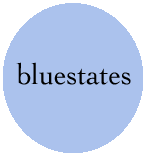
Exploring Relational Space
Cities are not merely collections of buildings; they are the living, breathing, teeming product of the human bodies who inhabit them. A city razed to the ground may recover, but a city emptied of people is dead. Yet emphasis is always given to the locative nature of a city - the neighborhood you live in, the street, the floor, the unit - an assertion of a Cartesian primacy which ignores the more profound natural relationships of the city: the coming together and parting of human beings living social lives. Cities are their people; souls are the bricks from which a city is constructed.
BlueStates: Exploring Relational Space--by Mark Pesce and John Tonkin--is an attempt to reverse the figure and ground of the city, ignoring its visible nature as a locative, Cartesian space, creating, instead, a view of the city purely as a social space. In this work, the trope of absolute location is abandoned in favor of the idea of relational proximity. BlueStates does not show you where you have been, but rather, it shows you who you have been with - a more perfect metric for the inner life of the city.

The inspiration for BlueStates is drawn from the recognition that most of us, most of the time, carry that most common of 21st century appliances, the mobile phone. Most of these mobile phones are equipped with a wireless technology known as Bluetooth. A Bluetooth mobile phone user creates a radius of electronic awareness - what we call a "bluesphere" - extending as much as ten meters from their body. When two Bluetooth devices pass in proximity to one another, each senses the other. Data is exchanged - and promptly ignored. BlueStates: Exploring Relational Space uses its own, custom software sensors - which run on mobile phones, PDAs and computers - to listen intently to the bluesphere. These sensors contribute to a database record of proximal encounters, and this data is then used to build views into the social life of the city's residents.
BlueStates is by its nature a highly participatory work. Anyone will be able to visit the website and create their own views into relational space. Residents of cities around the world will be encouraged to add their own sensors to the global network of sensors, expanding the database to incorporate the inner social life of their own cities. Beyond this, the work's creators have committed to releasing all software developed for the project as as free and open source software (under the GNU General Public License), believing this will encourage others to create their own projects in relational space. Finally, artists will be provided with tools to that will allow them to permute the data gathered by BlueStates: Exploring Relational Space in new and unique ways.
The two artists behind BlueStates have spent their careers exploring the intersection between art and technology. Mark Pesce is best known as the inventor of VRML, the standard for 3D on the World Wide Web, and has pioneered new interactive techniques for a quarter of a century. John Tonkin has consistently produced a stream of artworks that twist technology (and, occasionally, his body) into new and unexpected forms. Currently based at the University of Sydney, he has been involved in a broad range of projects including a collaboration at the Banff Centre for New Media Arts and a fellowship funded by the Australia Council. [from ISEA 06, via pasta and vinegar]
Posted by jo at 04:32 PM | Comments (0)
November 16, 2006
Second Life
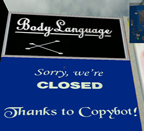
Businesses Close Due to Cloning
Copybot is a program designed to clone other people’s SL possessions. When someone sells an item in SL, they naturally have the option to limit what the purchaser does with it. People creating unique designs as a business enterprise don’t always want you to be able to issue infinite copies for free, after all.
The night before last, I was looking around a no-fire combat sandbox, where people design and test weapons and vehicles, when an argument broke out; a thing going by the name Nimrod Yaffle was cloning things out of other people’s inventories, and claiming he could freely do it because he’d been playing with Copybot with employees of SL creator/operators Linden Lab. All hell broke loose, in the sort of drama you can only find on the internet. Linden Lab’s first official response? If you feel your IP has been compromised by Copybot, we’ll sort of help you lodge a DMCA complaint in the US. Businesses started shutting down moments later. [posted by Warren Ellis on This Is The Warren Ellis Dot Com]
"Second Life needs features to provide more information about assets and the results of copying them. Unfortunately, these are not yet in place. Until they are, the use of CopyBot or any other external application to make unauthorized duplicates within Second Life will be treated as a violation of Section 4.2 of the Second Life Terms of Service and may result in your account(s) being banned from Second Life. If you feel that someone has used CopyBot to make an infringing copy of your content, please file an abuse report. Note that this is completely separate from any copyright infringement claim you may wish to pursue via the DMCA.
Like the World Wide Web, it will never be possible to prevent data that is drawn on your screen from being copied. While Linden Lab could get into an arms race with residents in an attempt to stop this copying, those attempts would surely fail and could harm legitimate projects within Second Life." Continue reading Use of CopyBot and Similar Tools a ToS Violation.
[posted by marc garrett on netbehaviour]
Copybot Protest:
Second Life, Economic Evolution and the CopyBot
"...If the ability to make copies continues to exist, these vendors argue, the basis of the SL economy will be destroyed. And since there's a direct conversion between in-game money and real-world money, anything that weakens the SL economy threatens the real-world economic livelihoods of many SL residents. They're right -- but is the Second Life economy worth saving?
What Linden Lab has tried to do is replicate the atom-world scarcity rules in a bit-world environment. Nobody should be surprised in any way that this doesn't work for long. It is the nature of bits to be easily copied. Even if Linden manages to shut down CopyBot, it will arise again in another form, and probably as something much harder to squelch. The death of Napster becomes the explosion of Gnutella and Bit Torrent; the death of CopyBot will mean the emergence of something more powerful and less easily eliminated. It's delightfully Darwinian..." From Second Life, Economic Evolution and the CopyBot, Open the Future]
Posted by jo at 06:39 PM | Comments (0)
November 15, 2006
WGBH’s Lab Sandbox

Open Content Initiative
WGBH’s online Lab, a virtual space designed to explore new content creation opportunities, with a focus on new media, launches its new video Lab Sandbox feature. This addition to the Lab’s current features, including the 6:55 Shorts: Open Call and the Filmmakers-in-Residence program, invites users to experiment with archived WGBH content. The WGBH Lab aims to support the innovative work of independent filmmakers and open the doors of WGBH to new voices and ideas.
The Lab Sandbox is an open content initiative modeled along the lines of the “Find it, rip it, mix it, share it” BBC Creative Archive. Lab Sandbox is an online space within the WGBH Lab where the users can gain access to use rights-cleared, WGBH-owned content to use for their own (non-commercial) purposes. The public is invited, but not required, to share the results of their work by posting a link to the site. Users will be able to post comments on each other’s work.
“As with all programs in the WGBH Lab, the Lab Sandbox is meant to push open the doors of WGBH and to invite in new, diverse and innovative voices,” said Boston Media Productions Executive-in-Charge Denise DiIanni.
The Lab Sandbox features different selected video clips, including some with themes of science, nature and history. WGBH aims to build on the selection currently offered by getting feedback from users about their need for open content, and by clearing the rights for additional content.
About WGBH: WGBH informs, inspires, and entertains millions of people throughout New England. Boston’s last remaining independent TV station, WGBH is the leading producer of PBS prime-time programs and online content, a major producer for public radio, and a pioneer in educational multimedia and services that make media accessible for people with disabilities.
Posted by jo at 03:33 PM | Comments (0)
November 14, 2006
Collecting New Media Art

Open Systems
"...Open Systems: One of the constant refrains about the promise of new media art is that it allows the viewer to become a participant and even, for many works, a producer. The artist is creating the context, the platform, the set of rules by which the "viewer" participates and produces. With a work such as Apartment (2001) by Marek Walczak and Martin Wattenberg, for example, users enter a string of words in order to create the floorplan of an associated apartment. The truth is, some users are better than others at generating results that are of interest to other viewers. How are we to judge works where the input is the user's?
For Kynaston McShine's acclaimed Information exhibition (1970), Dennis Oppenheim created a system for visitors to write a secret on a notecard and put it in a slot. In return, they received someone else's secret. After the exhibition all 2000+ of the secrets were published, without editing. One would be hard-pressed, however, to argue that the quality of this essentially conceptual work was dependent on what people wrote.
Many new media artworks are inherently performative. It is important to judge them on the basis of the performance that is possible, not on every person's rendition of Moonlight Piano Sonata (1801), so to speak..." From Collecting New Media Art: Just Like Anything Else, Only Different by Steve Dietz, NeMe.
Posted by jo at 11:00 AM | Comments (0)
November 10, 2006
Henry Jenkins

Taking the You Out of YouTube?
"We have all seen major media companies telling us that file-sharing is bad because it takes other people's intellectual property without just compensation. So, why are these same companies now taking their audience's intellectual property for free?" --Henry Jenkins
YouTube, along with Second Life, Flickr, Wikipedia, and MySpace, has emerged as one of the key reference points in contemporary digital culture -- emblematic of the move towards what people are calling web 2.0. As Newsweek aptly put it last year, web 2.0 is "putting the we into the web."
Elsewhere, I have argued that web 2.0 is fan culture writ large, fan culture without the stigma. Nobody is telling these guys to move out of their parent's basement -- though some of them have started multimillion dollar companies out of their parent's basements. What separates these companies from the dotcoms which fueled web 1.0 is the emphasis upon participation, social networking, collective intelligence, call it what you want. What distinguishes them is that their content arises bottom up from the community of users.
One by one, these insurgent companies are being absorbed into the surviving digital giants (as has happened through Yahoo's purchase of Flickr or more recently, Google's purchase of YouTube) or by old media companies (as in Rupert Murdock's takeover of MySpace). With each new buyout, there is renewed speculation about what happens to the "we" --what becomes of the communities that made these activities and services so attractive in the first place.
Today, I wanted to share two really interesting responses to the buyout of YouTube and what they might mean for the future of participatory culture. Continue reading Taking the You Out of YouTube? by Henry Jenkins.
Posted by jo at 04:30 PM | Comments (0)
Steal This Film:
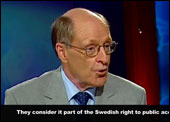
BitTorrent Culture Sharing Documentary
According to Armin Medosch, in an interconnected environment, individuality or expression are neither important. What's important are the new forms of sharing, spreading and planning the digital work. With collective actions this cultural domain progresses in its entirety, because sharing and collaborating mean learning from each other. This is the spirit that inspired Steal This Film, a documentary series that depict and promote the movement against the intellectual property activities. The authors, The League of Noble Peers, define themselves as a group of friends that wanted to make a film about the file sharing movement highlighting activists and artists ideas about the future of creativity.
The first part of Steal This Film, the only one yet completed and available for downloading, tells the story of The Pirate Bay, one of the biggest BitTorrent trackers server, and of the Swedish organization Pyratbyræn, chronicling with protagonists' interviews what happened when the Swedish police seized the servers in May 2006. In some countries distributing torrents tracking unlicensed copies of copyrighted material is illegal.
In Sweden, a nation with a strong democratic tradition (allemannsretten), downloading material for personal use wasn't considered illegal until July 2005 when the government, according to many forced by USA, outlawed the copying, distribution, uploading and downloading of copyright material. However, even if the police raid, justified by law, was aimed to inhibit the pirates' activities, the result was the opposite: the accesses to The Pirate Bay doubled and the number of downloadings increased, thanks to the sudden media exposure. Furthermore a political party, The Pirate Party, was founded, with the general consent of young electors, who don't want to lose such a content source. Steal This Film it's a DIY video that tells this story in half an hour, certainly including some naivety such as subliminal messages like 'Resist Share Copy' or 'Sharing is not Stealing', or the apologetic attitude towards the guerrilla. However the artwork 'metadata' nature, a BitTorrent file that encodes data about sharing, as well as the effort of documenting facts and opinions on the copyright debate are worth the download." -- Valentina Culatti, Neural.
Posted by jo at 10:42 AM | Comments (0)
November 03, 2006
Mizuko Ito on
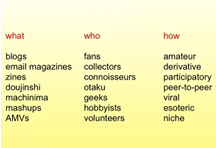
Amateur Cultural Production in the New Networked Age
Mimi Ito’s talk is entitled "Amateur Cultural Production in the New Networked Age." She is a cultural anthropologist who studies new media use, particularly among young people in Japan and the US. She is currently co-leading a multi-year project on Digital Kids and Informal Learning, with support from the MacArthur Foundation. As part of this project she is conducting case studies of anime fandoms in Japan and the English-speaking online world. She is a Senior Fellow at the Annenberg Center for Communication.
As part of last year's Networked Publics program at the Annenberg Center, Ito and her research colleagues have been examining the changing relationship between cultural production and consumption. They have looked at the ways that many-to-many distribution, peer-to-peer social organization, and the availability of low-cost digital authoring tools have lowered thresholds to cultural production "manifest in public culture as increased visibility and mobilization of those actors traditionally associated with cultural consumption." They see three domains "growing in salience with the turn toward networked public culture: 1) amateur and non-market production, 2) networked collectivities for producing and sharing culture, 3) niche and special-interest groups, and 4) aesthetics of parody, remix, and appropriation." More >> [posted by Howard Rheingold on DIY Media Weblog]
Posted by jo at 05:27 PM | Comments (0)
October 20, 2006
Confronting the Challenges of Participatory Culture:
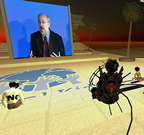
Media Education for the 21st Century
[Image left: Henry Jenkins in Second Life] "According to a recent study from the Pew Internet & American Life project (Lenhardt & Madden, 2005), more than one-half of all teens have created media content, and roughly onethird of teens who use the Internet have shared content they produced. In many cases, these teens are actively involved in what we are calling participatory cultures.A participatory culture is a culture with relatively low barriers to artistic expression and civic engagement, strong support for creating and sharing one’s creations, and some type of informal mentorship whereby what is known by the most experienced is passed along to novices.A participatory culture is also one in which members believe their contributions matter, and feel some degree of social connection with one another (at the least they care what other people think about what they have created). Forms of participatory culture include:
Affiliations — memberships, formal and informal, in online communities centered around various forms of media, such as Friendster, Facebook, message boards, metagaming, game clans, or MySpace).
Expressions — producing new creative forms, such as digital sampling, skinning and modding, fan videomaking, fan fiction writing, zines, mash-ups).
Collaborative Problem-solving — working together in teams, formal and informal, to complete tasks and develop new knowledge (such as through Wikipedia, alternative reality gaming, spoiling).
Circulations — Shaping the flow of media (such as podcasting, blogging).
A growing body of scholarship suggests potential benefits of these forms of participatory culture, including opportunities for peer-to-peer learning, a changed attitude toward intellectual property, the diversification of cultural expression, the development of skills valued in the modern workplace, and a more empowered conception of citizenship. Access to this participatory culture functions as a new form of the hidden curriculum, shaping which youth will succeed and which will be left behind as they enter school and the workplace. Some have argued that children and youth acquire these key skills and competencies on their own by interacting with popular culture.Three concerns, however, suggest the need for policy and pedagogical interventions:
The Participation Gap — the unequal access to the opportunities, experiences, skills, and knowledge that will prepare youth for full participation in the world of tomorrow.
The Transparency Problem — The challenges young people face in learning to see clearly the ways that media shape perceptions of the world.
The Ethics Challenge — The breakdown of traditional forms of professional training and socialization that might prepare young people for their increasingly public roles as media makers and community participants.
Educators must work together to ensure that every American young person has access to the skills and experiences needed to become a full participant, can articulate their understanding of how media shapes perceptions, and has been socialized into the emerging ethical standards that should shape their practices as media makers and participants in online communities. A central goal of this report is to shift the focus of the conversation about the digital divide from questions of technological access to those of opportunities to participate and to develop the cultural competencies and social skills needed for full involvement. Schools as institutions have been slow to react to the emergence of this new participatory culture; the greatest opportunity for change is currently found in afterschool programs and informal learning communities.
Schools and afterschool programs must devote more attention to fostering what we call the new media literacies: a set of cultural competencies and social skills that young people need in the new media landscape. Participatory culture shifts the focus of literacy from one of individual expression to community involvement. The new literacies almost all involve social skills developed through collaboration and networking. These skills build on the foundation of traditional literacy, research skills, technical skills, and critical analysis skills taught in the classroom.
The new skills include:
Play — the capacity to experiment with one’s surroundings as a form of problem-solving
Performance — the ability to adopt alternative identities for the purpose of improvisation and discovery
Simulation — the ability to interpret and construct dynamic models of real-world processes
Appropriation — the ability to meaningfully sample and remix media content
Multitasking — the ability to scan one’s environment and shift focus as needed to salient details.
Distributed Cognition — the ability to interact meaningfully with tools that expand mental capacities
Collective Intelligence — the ability to pool knowledge and compare notes with others toward a common goal
Judgment — the ability to evaluate the reliability and credibility of different information sources
Transmedia Navigation — the ability to follow the flow of stories and information across multiple modalities
Networking — the ability to search for, synthesize, and disseminate information
Negotiation — the ability to travel across diverse communities, discerning and respecting multiple perspectives, and grasping and following alternative norms.
Fostering such social skills and cultural competencies requires a more systemic approach to media education in the United States. Everyone involved in preparing young people to go out into the world has contributions to make in helping students acquire the skills they need to become full participants in our society. Schools, afterschool programs, and parents have distinctive roles to play as they do what they can in their own spaces to encourage and nurture these skills."
From Confronting the Challenges of Participatory Culture: Media Education for the 21st Century by Henry Jenkins, Director of the Comparative Media Studies Program at the Massachusetts Institute of Technology; with Katie Clinton, Ravi Purushotma, Alice J. Robinson and Margaret Weigel.
Posted by jo at 03:12 PM | Comments (0)
October 19, 2006
A Journal of Interactive Media

Games and Culture
Games and Culture: A Journal of Interactive Media is a new, quarterly international journal that publishes innovative theoretical and empirical research about games and culture within interactive media. The journal serves as a premiere outlet for ground-breaking work in the field of game studies.
Games and Culture's scope includes the socio-cultural, political, and economic dimensions of gaming from a wide variety of perspectives, including textual analysis, political economy, cultural studies, ethnography, critical race studies, gender studies, media studies, public policy, international relations, and communication studies. Other arenas include the following:
• Issues of gaming culture related to race, class, gender, and sexuality
• Issues of game development
• Textual and cultural analysis of games as artifacts
• Issues of political economy and public policy in both US and international arenas
Posted by michelle at 03:14 PM | Comments (0)
September 27, 2006
BIENNIAL OF THE YEAR 3000
![]()
ARTISTS AND CITIZENS TAKE POWER
FROM 5 OCTOBER TO 15 DECEMBER 2006, FRED FOREST INVITES ALL ARTISTS TO PARTICIPATE IN THE BIENNIAL OF THE YEAR 3000, A BIENNIAL IN WHICH ARTISTS AND CITIZENS TAKE POWER AND EXERCISE THEIR RIGHTS TO THE FREEDOM OF SPEECH AND THE FREEDOM OF IMAGE. YOUR PRESENCE, EITHER THROUGH IMAGES, WORDS OR BOTH, WILL BE HIGHLY SIGNIFICANT.
ACTIVELY PASS ALONG THIS PROPOSITION THROUGH ALL YOUR PERSONAL NETWORKS.
THE SUCCESS OF THIS INITIATIVE WILL ALSO BE YOUR SUCCESS AND WILL DEMONSTRATE THE CAPACITIES OF ARTISTS TO SELF-ORGANIZE AGAINST DIFFERENT CULTURAL POWERS AND THE EXISTING INDUSTRY, USING THE TOOLS OF DIGITAL COMMUNICATION AND THE INTERNET.
CONTRIBUTIONS WILL BE DISPLAYED IN A LOOP ON THE MAC IN IBIRAPUERA PARK AND UPDATED PERIODICALLY. THANK YOU FOR YOUR PARTICIPATION
BIENNIAL OF THE YEAR 3000
A BIENNIAL IN WHICH ARTISTS AND CITIZENS TAKE POWER AND EXERCISE THEIR RIGHT TO THE FREEDOM OF SPEECH AND IMAGE
The French artist, Fred Forest, Docteur d'Etat from the Sorbonne, who organized the controversial Biennial, the "Biennial of the year 2000", in 1975, under the military regime, with the support of Walter Zanini, then director of MAC--has done it again in 2006! Thirty years later, he is organizing a "Biennial of the year 3000", with the participation of Brazilian and foreign artists.
In 1973, representative artists such as, Amelia Toledo, Anesia Pacheco Chaves, Armando Canuto, Cesar Loureiro, Conrado Silva, Euclides Sandoval, Fabio Magalhães, Gilberto Moirimitto, Luiz Augusto de Aruda, Luiz Carlos Homem da Costa, Regina Celia Canel, Sergio Fuiza, participated in his Biennial.
This year Fred Forest is organizing the Biennial of the year 3000 in São Paulo from 7 October to 13 December 2006. A Biennial that breaks free from the official Biennial, because it is a digital, planetary, participatory biennial, a biennial without selection and consequently, truly democratic.
Fred Forest has always played an important role as a pioneer. In 1973, he was already involved in the creation and performance of street art, participatory art, protest art, and social art. Over thirty years later, these art forms constitute an important part of today's artistic practices given the slowness of cultural institutions to assimilate innovation. This "Biennial of the year 3000" will happen in the same places as the "Biennial of the year 2000": in the Mac USP, Ibirapuera Park.
It will affirm with strength and independence that art does not stay tied to past concepts.
It will demonstrate that in an age where the Internet is helping to abolish the concepts of time and space, and where the aesthetics of communication invades all symbolic and social dimensions, art does that remain stagnant.
The making of art is first done with our senses, and our senses are not created from obsolete concepts when the world transforms itself in real-time under our very eyes.
Annick Bureaud (annick[at]nunc.com)
tel/fax : 33/ (0)143 20 92 23
mobile : 33/ (0)6 86 77 65 76
Leonardo/Olats : http://www.olats.org
Posted by jo at 12:05 PM | Comments (0)
September 15, 2006
USC Annenberg Center Speaker’s Series
![]()
Speaker’s Series/Do-It-Yourself (DIY) Media
As part of the USC Annenberg Center Speaker’s Series, once a month speakers will discuss issues and practices associated with Do-It-Yourself (DIY) media. These DIY Media seminars will focus on the shifting relations between cultural producers and consumers and the rise of participatory media cultures across various industry sectors due to the growing prevalence of digital tools and networks.
In line with the participatory ethos, the seminars are meant to be highly interactive. Short presentations will be followed by discussion, and throughout the session there will be a backchannel for text-based chat. If you would like to participate in the backchannel, please attend with your laptop and be sure to have an IRC client that you can use. Our backchannel will be #diymedia on irc.freenode.net.
During the week following the seminar USC Annenberg Center Fellow Howard Rheingold will post blog entries and invite other participants to join in an asynchronous discussion at http://weblogs.annenberg.edu/diy/, and to post photos with the Flickr tag "diymedia." This online space will serve as a resource and networking site for the key players in this emergent area.
Both the seminars and the online forum are a prelude to the Fall 2007 DIY Media Festival, organized by Mimi Ito, Adrienne Russell, and a committee of USC Annenberg Center staff members and researchers.
Continue reading after the jump for the Fall semester schedule for the USC Annenberg Center Speaker’s Series/DIY Media seminars:
September 14
Speakers: Mimi Ito and Howard Rheingold
Mimi Ito’s talk is entitled "Amateur Cultural Production in the New Networked Age." She is a cultural anthropologist who studies new media use, particularly among young people in Japan and the US. She is currently co-leading a multi-year project on Digital Kids and Informal Learning, with support from the MacArthur Foundation. As part of this project she is conducting case studies of anime fandoms in Japan and the English-speaking online world. She is a Senior Fellow at the Annenberg Center for Communication.
Howard Rheingold’s talk is entitled "Participatory Media Literacy and Civic Engagement." His 2002 book Smart Mobs, was widely acclaimed as a prescient forecast of the always-on era. The weblog associated with the book (http://www.smartmobs.com/) has become one of the top 200 of the 8 million blogs tracked by Technorati, and won Utne Magazine's Independent in 2003. In 2005, he taught a course at Stanford University on "A Literacy of Cooperation," as part of a long-term investigation of cooperation and collective action, undertaken in partnership with the Institute for the Future. He teaches Participatory Media/Collective Action at UC Berkeley's School of Information, and Digital Journalism at Stanford University. He is a Nonresident Fellow at the USC Annenberg Center for Communication, and a visiting Professor at De Montfort University in Leicester, UK.
October 19
Speakers: Bob Stein and Todd Richmond
The topic of Bob Stein’s talk is open source academic publishing. He is Senior Fellow at the USC Annenberg Center, and Director of the Institute for the Future of the Book-- a project designed to explore, understand, and influence the shift from the printed book to digital publishing. Stein is currently working on SOPHIE-- a new software program that will allow artists, scholars, writers and others create digital documents incorporating audio and visual elements, along with text. The underlying goal of this project is to develop software that allows users to create their publications without having to hire a specialized programmer or learn complicated programming techniques. Upon completion in 2006, SOPHIE will be distributed on an open-source basis via the Institute for the Future of the Book.
The topic of Todd Richmond’s talk is open source courseware. He is currently a Fellow at the USC Annenberg Center, and the Center for Creative Technologies at USC. He is also an Adjunct Professor in the Interactive Media Division of the USC School of Cinema-Television. He specializes in basic and applied research in the broad field of digital networked media, social networks, and social software. He is currently working on a Hewlett Foundation-funded research project titled "Viral University Education" which seeks to better understand and facilitate the uptake of freely available open educational content on the Internet by using a variety of social software tools and technologies to create viral learning communities and content.
November 16
Speakers: danah boyd and Justin Hall
Danah boyd’s [sic] talk is entitled "Creating Culture Through Collective Identity Performance: MySpace, Youth, and DIY Publics." Danah is a PhD candidate in the School of Information at the University of California-Berkeley and a Graduate Fellow at the USc Annenberg Center. Funded by the MacArthur Foundation, her dissertation focuses on how youth engage in networked publics like MySpace. In particular, she investigates how youth formulate a presentation of self and negotiate socialization in mediated contexts where the audience is often unknown. Prior to Berkeley, danah received an AB in computer science from Brown University and an MS in sociable media from MIT Media Lab. She has worked as an ethnographer and social media researcher for various corporations, including Intel, Tribe.net, Google and, currently, Yahoo! She also created and managed a large online community for V-Day, a non-profit organization working to end violence against women and girls worldwide. She actively blogs about social media at Apophenia (www.zephoria.org/thoughts/)
Justin Hall will speak about "Passively Multiplayer Online Games." He is a Graduate Fellow at the USC Annenberg Center and a graduate student in the USC Interactive Media Division where he explores alternatives to text publishing online. He is currently developing surveillance-based gameplay online and on mobile phones called "Passively Multiplayer Online Gaming." He has taught classes and workshops at USC School of Cinema-Television encouraging the creation and distribution of short videos online. He started "Justin’s Links from the Underground" (www.links.net) in January 1994 eventually writing 4,800 pages of hypertexted personal journalism before stepping back in January 2005. In December, 2004, New York Times Magazine referred to him as "the founding father of personal blogging."
December 14
Speakers: Jennifer Urban and Cory Doctorow
Cory Doctorow is co-editor for the popular technology blog "Boing Boing."He is also a Senior Fellow at the USC Annenberg Center, and is currently the first to hold USC's Canada-U.S. Fulbright Visiting Research Chair in Public Diplomacy. He actively supports liberalizing copyright laws in order to increase the amount of creative work available to share, remix, and develop. A proponent of Creative Commons, his work emphasizes digital rights management, file-sharing, Disney, and post-scarcity economics.
Jennifer Urban is a Fellow at the USC Annenberg Center and a Clinical Associate Professor of Law at USC. She teaches Intellectual Property and classes related to Technology Law and Policy. She also is the Director of the USC Intellectual Property Clinic, where students learn intellectual property law through hands-on work with cutting-edge, real-world projects. She is a faculty member of the USC Center for Communication Law and Policy.
For more information on these talks or speakers, go to www.annenberg.edu, or call 213-743-2520. [blogged by Scott on USC Interactive Media Division]
Posted by jo at 04:41 PM | Comments (0)
September 14, 2006
Jane McGonigal

Please feed (but don't fetishize) the participation
I'm feeling a bit squeamish about a lot of the lonelygirl discussion going on this week, in the wake of the previously secret puppet masters' curtain call. As someone who designs participatory experiences, often games with a serial narrative component, I think it's really important that we stop and look at the kind of participation and engagement actually engendered by projects that purport to solicit the collaboration of the audience.
In the LA Times, the producers of the You Tube serial drama describe their goals for engaging the audience:
The intent was to allow fan response posted in the comment section of lonelygirl15's YouTube and MySpace pages to determine the direction of each subsequent episode.As an example of the fans' influence over the story line, what the team calls "collaborative storytelling," they pointed to an episode in which Daniel reveals his romantic feelings to Bree. "In the 'Hiking' video," Beckett said, "where Daniel filmed her, there were a ton of comments saying, 'Daniel likes you. It's obvious that the cameraman was completely in love with you.' We saw the comments and said this is the perfect opportunity to address this."
Okay, fair enough. I'm all for collaborative storytelling. But I don't think it's right to accept this account of the kind of participation that happened during the lonelygirl project at face value. Today and yesterday I spent a lot of time reading through pretty much every single comment left on the lonelygirl videos, the space where the audience was purportedly invited to help decide and direct the course of the narrative. I would encourage anyone else interested in the currently much praised and hyped lonelygirl "community" to do the same. A great hub for doing this is here.
As the statistics on this traffic counter show, each lonelygirl video has roughly 1000-4000 comments, nearly all of them left before the puppet masters were unmasked. And I have to say this: the level of hate, mean-spiritendess, crudeness and often downright misogeny of the majority of them is impossible to ignore.
As we talk about the “new art form” or “participatory culture” aspects of this project, I want to be very careful that we don’t fetishize the participation aspects of this experience that was had by a very few who may have intelligently, passionately and seriously investigated and responded to the texts and the media objects. I want instead to think about the mainstream experience of and participation in this project and the success of the platform provided for engagement.
To give you an idea, here is a sample of comments that I would characterize as representative of at least 33% if not more of comments to the lonelygirl videos:
You are pretty boring. Get a psychologist.
Ok. Why don’t you just keep your personal problems to yourself and stop making a scene
show us your tits
you are really ugly i hope you know that
Your eyebrows are too far apart. But, you’re still pretty.
Fuck you. Welcome to the new world we Don’t Have to Respect what you think. get over it
I hope Daniel rapes you. No hard feelings.
WHORE lol
HHHmmmmm,your caucasian,live in a decent to luxurious house, are well taken care of,and it looks like you are one of those spoiled girls that kiss ass to thier daddy.Think you have it rough?Why dont you come live in East Los Angeles,whee you cant go anywhere without being shot at,you fuckin spoiled brat.
Cry me a river bitch, your a teenager, do what your parents say bitch.
(Most discussion in the comments is not about whether lonelygirl is real or not-- they appear to accept the videos at face value, or otherwise not to care whether they are insulting a "real" girl or an actress.)
So: Is this really the birth of a new art form? Is this a kind of social participation that we like or find interesting? I'm all for participatory entertainment. But let's carefully design platforms, vehicles, and contexts for participation that really work to engage audiences, players, makers, collaborators in meaningful ways.
One more point I want to make: I think this question of "is she real or not" and how does the audience feel about being hoaxed or played with is a really important one. Although many, many viewers were openly skeptical or cynical about the verity of lonelygirl's professed identity, from what I can tell, far more took it close enough to real to play along.
Now I've written a lot about, and worked on quite a few, projects that ask players to perform belief in the story and game experiences, but--and here's the key distinction--without presenting actually credible fictons. (Stories set 500 years in the future, for instance, or involving poker rooms full of ghosts). The media itself never clearly said "I'm not real", but the content absolutely had no chance of fooling anyone. So I'll come out and say it: I don't personally like entertainment in the form of credible hoaxes. Not necessarily from a moral position, but rather because I believe that "real or not" distracts from the more important question: How can I meaningfully engage?
I agree that serial drama on You Tube is a great art form (so are traditional ARGs, the more elaborate art form that lonelygirl represents a pared back style of, in my opinion), but the real conversation should be not about the realness, but rather: How do people want to participate in it? Do they want to be the makers of their own videos? To have role-playing style conversations in the comments? Do they want to directly influence the narrative or to just speculate and gossip about it so they can be proven right by what happens next? And most importantly how do we inspire participation that is more than hostile juvenile comments? How do we create a real participatory community around an entertainment property, and what forms of participation are possible... and desirable? [posted by Jane on Avant Game] [Related post]
Posted by jo at 06:18 PM | Comments (0)
September 06, 2006
Upgrade! New York
![]()
Catherine D’Ignazio a.k.a. kanarinka
Upgrade! New York: September 14, 7:30 pm :: The Change You Want to See Gallery and Convergence Stage :: 84 Havemeyer Street, Store Front @ Metropolitan Ave, Brooklyn, NYC
Are locative media and psychogeography projects just entertainment for white, middle-class, gadget-oriented consumers? Mapping impulses, locative media projects and psychogeographic investigations of place and community have proliferated over the past decade. There is a rich, interdisciplinary field of practice and new strategies, tactics and tools are being invented all the time. However, there is also the need for critical evaluation and discussion of the relevance and impact of these cultural projects. Factors of race and class are often overlooked. Connections to the material (often military and corporate) circumstances of the development of technologies deployed in these projects are often swept aside. Through the increasing corporatization and militarization of participation and play (Web 2.0, Joint Red Flag military war game), it is clear that more participation and play does not mean more democracy and freedom. On the contrary, participation and play are also deployed as mechanisms of social control.
Catherine D’Ignazio a.k.a. kanarinka will discuss several collaborative projects from her practice, show other examples of contemporary psychogeographic investigations and then open the forum for others to do the same. The goal of the talk is to discuss three questions:
1) Is locative media/psychogeography work just entertainment for white, middle-class, gadget-oriented consumers? (Hopefully the answer is no, but we’ll see.)
2) What is at stake in the corporatization and militarization of “play” and “participation”?
3) What kind of agency do these projects have? i.e. What do they really do?
TO BRING (optional): Failures & successes. Bring a psychogeography/locative media project to share with us, including your commentary about what kind of agency it produces, how it addresses its audience, and so on. Both failures and successes - and the numerous projects that have both - are useful.
LATER: We will proceed to the opening for the Conflux Festival at Supreme Trading Post to continue the conversation.
Posted by jo at 01:44 PM | Comments (0)
September 05, 2006
THE PARTICIPATORY CHALLENGE

hands-on guidelines
"This essay is about participation in online collaborations and the potentials of extreme sharing networks in the unregulated commons. Current debates focus too much on what social tools can do and not enough on the people who use them. Motivations of the multitudes who add content to online environments matter a great deal. What follows here are hands-on guidelines and an outline of preconditions for online participation. Terms like: involvement, turn taking, network, feedback, or distributed creativity (1) are frequently applied to characterise this kind of social and cultural interaction. Today, people do not merely browse the web. Instead they give away information, expertise, and advice without monetary compensation. They submit texts, code, music, images, and video files in settings that allow for such contributions. They also re-mix each other’s content. Thousands voluntarily participate in open encyclopedias, social bookmarking sites, friend-of-a-friend networks, media art projects and blogs or wikis. This exemplifies the growing interest in technologies of cooperation. Swarms of users/producers form extreme sharing networks, supporting their goal to lead fullfilled and engaged lives.
This broad cultural context of increased content provision facilitated by the World Wide Web is the precondition for the emerging paradigm of the artist as cultural context provider, who is not chiefly concerned with contributing content to her own projects. Instead, she establishes configurations into which she invites others. She blurs the lines between the artist, theorist, and curator. However, it is surprising how little emphasis has been placed on the subtle motivations for taking part in participatory projects." From THE PARTICIPATORY CHALLENGE by Trebor Scholz [from: Krysa, J., ed. (2006) DATA Browser 03. Curating immateriality. The work of the curator in the age of network systems. Autonomedia: New York.] Trebor Scholz 2006 Attribution-ShareAlike 2.5.
Posted by jo at 08:46 AM | Comments (0)
September 04, 2006
[iDC] Totems without Taboos:
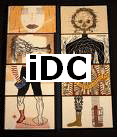
The Exquisite Corpse
This is an essay I've written as the foreward to an anthology on the classic game The Exquisite Corpse: Collaboration, Creativity, and the World's Most Popular Parlor Game edited by Kanta Kochhar-Lindgren, Davis Schneiderman, and Tom Denlinger, to be published by University of Nebraska Press (2007). This collection is the first set of original essays to provide a broad retrospective on the legacy of the Corpse project-and we are defining this legacy fairly loosely, with representation from historical, literary, collaborative, moments (etc.). The vibe is open and the text, I guess, is too. --enjoy! Paul aka Dj Spooky [via iDC]
Totems without Taboos: The Exquisite Corpse, by Paul D. Miller aka Dj Spooky that Subliminal Kid: Database aesthetics, collaborative filtering, musical riddles, and beat sequence philosophy aren't exactly things that come to mind when you think of the concept of the "exquiste corpse." But if there's one thing at I want to you to think about when you read this anthology, its that collage based art - whether its sound, film, multimedia, or computer code, has become the basic frame of reference for most of the info generation. We live in a world of relentlessly expanding networks - cellular, wireless, fiber optic routed, you name it - but the basic fact is that the world is becoming more interconnected than ever before, and it's going to get deeper, weirder, and a lot more interesting than it currently is as I write this essay in NYC at the beginning of the 21st century. Think of the situation as being like this:
in an increasingly fractured and borderless world, we have fewer and fewer fixed systems to actually measure our experiences. This begs the question: how did we compare experiences before the internet? How did people simply say "this is the way I see it?" The basic response, for me, is that they didn't - there was no one way of seeing anything, and if there's something the 20th century taught us, is that we have to give up the idea of mono-focused media, and enjoy the mesmerizing flow of fragments we call the multi-media realm. For the info obsessed, games are the best shock absorber for the "new" - they render it in terms that everyone can get. Play a video game, stroll through a corridor blasting your opponents. Move to the next level. Repeat. It could easily be a Western version of a game that another culture used to teach about morals and the fact that respect for life begins with an ability to grasp the flow of information between people and places. I wonder how many Westerners would know the term "daspada" - but wait - the idea that we learn from experience and evolve different behavioral models to respond to changing environments is a place where complexity meets empathy, a place where we learn that giving information and receiving it, is just part of what it means to live on this, or probably any planet in the universe. What makes "Exquisite Corpse" cool is simple: it was an artists parlour game to expose people to a dynamic process - one that made the creative act a symbolic exchange between players.
Some economists call this style of engagement "the gift economy" - I like to think of the idea of creating out of fragments as the basic way we can think and create in an era of platitudes, banality, and info overload. Even musicians and artists - traditionally, the ciphers that translate experience into something visible for the rest of us to experience - have for the most part been happy for their work to be appropriated by the same contemporary models for material power that have created problems for their audiences - power and art happily legitimizing each other in a merry dance of death, a jig where some people know the rules of the dance, but most don't. But this "death," this "dematerialization" - echoes what Marx and Engles wrote about way back in the 19th century with their infamous phrase "all that is solid melts into air." Think of the exquisite corpse concept as a kind of transference process on a global scale. When you look at the sheer volume of information moving through most of the info networks of the industrialized world, you're presented with a tactile relationship with something that can only be sensed as an exponential effect - an order of effect that the human frame of reference is simply not able to process on its own. At the end of the day, the "exquisite corpse" is just as much about renewal as it is about memory. It depends on how you play the game.
The way I see it, is this: whenever humanity tries to really grapple with the deep issues - life, death, taxes, you name it - it becomes a game, and I like to think that like most human endeavors, "exquisite corpse" is all about chance processes. For example, the Indian game of "daspada"or "Snakes and Ladders" as its commonly called, has its origin in documents from India around 2nd century BC. It's said that it was used as a game for teaching morals - the relative level of reincarnation, and multiple perspectives represented whether life's lessons had been learned - or not. The British took it to England in 1890s and from there, it spread to the rest of Europe and the world, but the basic idea is that the idea of living multiple lives, games theory, and the moral relationship between individuals and society was linked to rules - it seemed like a good place to reflect on how games get "sampled" and remixed, depending on which culture they're in. Cut and paste the result, and the basic idea is that this is all about information, and how we play with it. It could easily be Pac Man, Quake, or Halo2 it depends on your frame of reference. It's a thread that easily connect artists as diverse as Luis Buñuel, John Cage, Virgil Thomson, and Grand Master Flash. Yes, Grand Master Flash! The whole idea is to look at links - at connections that are unacknowledged but also undeniable: chance processes, and randomness do that - they scramble subjectivity in a way that lets the unconscious methods we've used to sort information in our minds become a filter for the way we engage the external world. It's a scenario that turns the mind inside out, and that, like pop culture always says, is a "good thing."
Humanity, according to most studies of "information theory" creates about 8 to 10 exabytes of information a year in the 21st century. An exabyte (derived from the SI prefix exa-) is a unit of information or computer storage equal to approximately one quintillion bytes. Its such a large number that it's literally beyond human comprehension. For example, the total amount of printed material in the world is estimated to be around five exabytes. It was estimated that by the end of 1999, the sum of human knowledge (including audio, video and text) was 12 exabytes - UC Berkeley School of Information suggests that 5 exabytes of storage space was created in 2002 alone, 92% of it on magnetic media, mostly on hard disks - the vast majority of this space is used to store redundant intellectual works such as music and commercial video.
A while ago, University of California Berkelely claimed that 5 exabytes of data approximately equals "all words ever spoken by human beings" this statement is just the tip of the iceberg, but you get the idea - there's a tremendous amount of information being produced by our culture, and the real way that humanity experiences most of it is through multi-media. That's where the "exquiste corpse" concept comes home to roost.
Think of one exabyte as a zillion gigabytes, and you get the idea - scale, density, and the sheer volume - it's all getting smaller, more fragmented, and more nuanced. That's more information than most of humanity has made throughout its existence on this planet over millions of years. Exquisite Corpse is a game - it's also known as "exquisite cadaver" or "rotating corpse" - but basically, it's a filtering process where a collection of words or images are assembled collectively, and the result is commonly known as the exquisite corpse or cadavre exquis in French. Each collaborator adds to the collage composition in sequence. It's the sequence of the game that makes the tension between each player a connected, and ultimately enriching experience - each person is only allowed to see the end of what the previous person contributed.
Think of a more technology oriented description this way: adaptation to human-engineered technologies, testing formal and ecological theorems for high-density lifestyles, sustainable resource sharing among urban organisms, and the play of public/private division in cross-species interaction. Got it? Info density isn't about the information just sitting happily on your hard-drive, on your canvass, or in the artists studio: the whole theme of this group of essays is a reflection on the different paths information takes as it moves from one culture to the next, one individual at a time. Think of Moore's Law: Expressed as "a doubling every 18 months", Moore's law suggests the phenomenal progress of technology in recent years. Expressed on a shorter timescale, however, Moore's law equates to an average performance improvement in the industry as a whole of over 1% a week. What game does that open us up to in the era of large numbers? For example - at pandora.com visitors are invited to enter the name of their favorite artist or song and to get in return a stream of music with similar "DNA," its essentially, in effect a private Internet radio station microtailored to each user's tastes. There's more - for example, customizable Internet radio services like Pandora, Last.fm, Yahoo's Launchcast and RealNetworks' Rhapsody are pointing users to music far beyond the playlists that confine most FM radio broadcasts. The most familiar form uses so-called collaborative filtering, software that makes recommendations based on the buying patterns of like-minded consumers. Think of the "customers who bought items like this also bought ..." function on Amazon.com. Your tastes, and the way the travel through the system are based on variables that leave trail for the algorithms running the software to model - that is then passed on to someone else, and so on and so on. Think of it as the cultural update of what "daspada" was about, just transcribed to the realm of the digital - the Surrealists anticipated this, and made it enjoyable.
In the realm of video and online media, the craze of "Machinima" - or when kids remix video game characters to make their own films, or in the realm of dj culture - it's the mix tape - but the common denominator is selection. The whole schemata that I'm pointing out is that density, and the tools we use to navigate it, are barometers of the deep structure of culture as it is translated into information - it's a pattern that, as the 21st century advances, will become more and more linked to the way we live and the way we play.
Moore's original statement can be found in his publication "Cramming more components onto integrated circuits", Electronics Magazine 19 April 1965 - but for the intents of this essay, let's think of the basic frame work as a mirror for Mie Van Der Rohe's infamous quip about design: less is more. Whisper that in someone's ear and see what happens.
The remix, as always, is what you make of it. Juxtapose, fragment, flip the script - anything else, simply put, would be boring. This anthology, like the original game of the Surrealists, points to a place in culture where, the process of art is a collaborative process. It's a situation that requires, like the name, a kind of collective action. The drawn version predates the written version - the anthology is a map of an un-drawn terrain of bodies and minds. Think of Mary Shelley's Frankenstein - the mis-matched body parts, the fragmented speech, the neo-Romantic sense of loss and renewal - what would that creature feel if it knew that it was justa figment of Shelley's imagination, a conversation piece made up on a cold night in Switzerland in the 19th century? Flip the script, cut and paste the result, and the literary equivalent of the artificial creature flows off the page and becomes another story, another composition, another way of seeing a world rapidly advancing into a frame of reference that we know is at the edge of what we call human.
Again the main motif of the scenario - the drawn version predates the written version - it's a kind of guessing match that produces what has now become a mass culture cliché: that's what I'm talking about. Collective memory, and the way it unfolds in the expression of culture, I guess that could be referred to as the "exquisite corpse" too. The whole idea of this anthology is to explore the places on the cultural map that haven't been marked, places that on any other map would be marked "here be dragons" - yes, the blank places. They invite interpretation, and yes, the active mind wants to doodle and fill in the emptiness. The map's blank spaces beckon like some kind of light at the end of a dark tunnel. I can only say that this collection of writings is a lexicon, a guide for interpreting a phenomenon that we all know waits at the edge of our imagination, if we only had the tools to navigate its unknown space.
Some have played the (graphic) game with a more or less vague or general prior agreement about what the resulting picture will be, but this defeats the essentially Surrealist nature of the game - you can say "look, these are the spaces that we present to you, and the rest is a method acting course in roles that no one is quite sure about how to play - the rest is up to you." See if the puzzle pieces fit, draw a line connecting the dots. But most of all - have fun!
Paul D. Miller aka Dj Spooky that Subliminal Kid
NYC 2006
www.djspooky.com
Posted by jo at 10:14 AM | Comments (0)
August 28, 2006
Device Art:
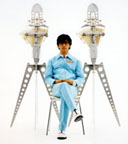
A New Form of Media Art from a Japanese Perspective
Device Art is a concept for re-examining art-science-technology relationships both from a contemporary and historical perspective in order to foreground a new aspect of media art. The term "Device Art" may sound obscure, or even self-contradictory, but it is a conscious choice. The concept is a logical extension of a change in the notion of art that already started in the early 20th century with art movements such as Dada and Surrealism. More recently, interactive art has redefined forms of art and the role of artists. What we call device art is a form of media art that integrates art and technology as well as design, entertainment, and popular culture. Instead of regarding technology as a mere tool serving the art, as it is commonly seen, we propose a model in which technology is at the core of artworks.
As I will discuss later, the concept took shape on the basis of an analysis of works by contemporary Japanese media artists. Features surfacing in many of these projects include interaction, a positive attitude towards technology, and playfulness. The influence of Japanese cultural tradition can be clearly traced in these haracteristics. Another aspect of this work is the artists' involvement in fields such as design, entertainment, and commercial production, which becomes evident in the approach of internationally recognized artists such as Toshio Iwai, Nobumichi Tosa (Maywa Denki), and Kazuhiko Hachiya. This approach, which is often considered suspect from a Western point of view, is actually a natural part of Japanese art. A long history of visual culture that developed independently from Western paradigms of art plays an important role in the Japanese art scene, offering artists wider possibilities for bringing their concepts outside of the context of museums and galleries." From Device Art: A New Form of Media Art from a Japanese Perspective by Machiko Kusahara, Intelligent Agent Vol. 6 No. 2, [pdf] [via] [Related post]
Posted by jo at 06:48 PM | Comments (0)
August 23, 2006
Seven Maps
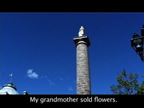
Call and Response
When filmmake /videoblogger Daniel Liss challenged himself to make 7 videos in 7 days, he also challenged his online audience to collaborate with him in the process. His daily assignments came from viewers of his videoblog who determined where, about what and how he should make each video.
Each day, they posted an assignment and each day Daniel posted a video in response. Then came praise and criticism in the comments of each day's videoblog post. The process took him miles from home, he told personal stories, invented new narratives, and played more than a few tricks on his guiding/goading audience.
For this video he was given the assignment, 'oday, you are a local. Trick us into believing that you are a local. Tell us a story about your history.' The entire Seven Maps series can be seen here : http://pouringdown.tv/sevenmaps [blogged by mica scalin on DVblog]
Posted by jo at 08:47 AM | Comments (0)
August 21, 2006
PLAY.Orchestra
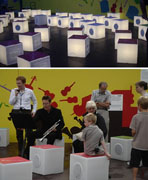
Sit and Play
If you go down to the South Bank in London this summer, outside the Royal Festival Hall is a wonderful installation titled PLAY.Orchestra. 56 plastic cubes and 3 Hotspots are laid out on a full size orchestra stage, each cube containing a light and speaker. Sit down on the cube or stand in the hotspot to turn on that instrument and bring 58 friends to hear the full piece. People with Bluetooth phones will be able to receive a ringtone of the piece created, as well as upload their own sound samples in September.
The production blog gives an interesting insight into the installing process & the complexity of the project. PLAY.orchestra is the result of a collaboration between Central Saint Martins College of Art & Design MA Creative Practice for Narrative Environments, South Bank Centre Education and the Philharmonia Orchestra.
Daniel Harris at Central Saint Martins was involved in the project from the beginning, details from his site:
"I was then responsible for the various human, computer and physical interfaces used in the build. 2 miles of cable are used to connect the 60 seats with the control system, which runs on a midi based Max MSP system.
The Objective was to get non-traditional audiences to experience an orchestra from new angles, and to involve themselves in activity of the philharmonia orchestra. For this purpose, a bluetooth system was set up, where members of the public can submit their own samples for composers to put together into a piece that will be played in the last few weeks of the installation."
IamtheMightyJungulator were also involved in the software side.
Photos stolen from Dan Harris Flickr Set.
(thanks for the tip Leslie, via BBC News) [posted by chris on Pixelsumo]
Posted by jo at 05:12 PM | Comments (0)
August 16, 2006
Social Media and the Networked Public Sphere
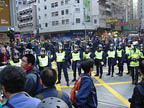
Improving Civic Participation
"Can social media increase and improve civic participation? If so, in what ways? There's a lot being said and written about the subject these days, but it is difficult to get a clear overview of the opinions. I attempt here to collect viewpoints both for and against the premise that social media is creating a better public sphere, and analyze them in the context of what constitutes a public and its antithesis, a mass. In presenting what are sometimes extreme positions within this debate (too idealistic v. too critical), my hope is to begin to understand the reality that lies in the middle, and come closer to understanding social media's potential (and limitations) as a tool to bring about social change.
At a general level, we could say that on one side of the debate are those who believe that social media can increase civic participation and shift the balance of power away from the institutions that currently stand in the way of change. On the other side are those who warn that social media can only offer a reduced form of participation, that it diminishes the value of individual contributions, and that it leaves social systems more prone to manipulation by lowering their intelligence to the minimum common denominator (i.e., stupidity or mediocrity).
Thus, the debate can be framed in terms of whether social media can engender democratic publics that embody an intelligence and capacity for action greater than the sum of its members, or whether it will merely continue to support the production of anti-democratic masses of disenfranchised and alienated consumers. Of course, social media is a big label encompassing many different technologies, and even the same technologies can be applied differently in various contexts. But while features and applications might differ, the people contributing to this debate are obviously focused on the aggregated impact that social media is having on our societies rather than on specific examples of applications." Continue reading Social Media and the Networked Public Sphere by Ulises Ali Mejias.
Posted by jo at 07:37 PM | Comments (0)
August 15, 2006
[iDC] Interactive City: irrelevant mobile entertainment?

"Interactive City": Middle-Class Consumer Spectacle?
(note--Michelle also blogged about the iDC thread here]
Hello All -
A pleasure to meet some of you at ISEA. A brief introduction - my name is kanarinka/Catherine D'Ignazio. I am an artist, software developer, co-founder of iKatun and the Institute for Infinitely Small Things, former Co-Director of Art Interactive in Cambridge, MA, and part-time faculty in the Digital+Media dept at RISD. I have been lurking on the list for some time now but have not posted.
I wanted to post a nagging doubt I have in light of the title of the ISEA conference theme "Interactive City" in conjunction with the ZeroOne "Global Festival of Art on the Edge" and the artwork showcased there. This is not a condemnation, more of a call to reflection for myself (who participated in a project there) and possibly for others. I would be interested to hear from others as to their thoughts on this.
The festival's imagination of the "Interactive City" seemed to be characterized by a spirit of play which feels increasingly oriented towards middle-class consumer spectacle and the experience economy. To give you an example of some art experiences that were possible at ISEA:
- eating ice cream and singing karaoke
- calling an old person in San Jose to talk about whatever you might
have in common with them
- pressing a button on a machine and getting an artsy plane ticket
with your photo on it
- drifting through the city as if it were a sports field via applying
sports plays in urban space
- visualizing your social network via bluetooth as you go around the
conference and talk to your friends
- watching/listening to noise music made by people riding skateboards
around the conference
- listening to an erotic sci-fi narrative about san jose on your cell
phone while riding the train
- flipping light switches to make a one-word message in public space
- viewing colorful 3D representations of wireless digital data
So, my questions to the artists, the organizers, the attendees and everyone else is - is psychogeography/locative media work simply R&D for a new generation of entertainment spectacle? Or, what are we actually trying to do with these ideas of "play" in urban space? Who gets to play? And what about the interactive cities in Iraq and Lebanon and elsewhere? Why didn't we address war, security, militarization and terrorism as aspects of the contemporary interactive city? For me, running around making the city into a sandbox, a playground or a playing field feels increasingly irrelevant and irresponsible.
A gentleman invited to drift with us summed it up nicely "Sorry, I can't go with you. I have to work here until 8PM and then I have to go to my other job."
What are your thoughts?
Thanks,
kanarinka [kanarinka at ikatun.com] [from iDC: Interactive City: irrelevant mobile entertainment?]
Responses:
Kevin Hamilton
Sarah Kanouse
tobias c. van Veen
Brad Borevitz
mollybh at netspace.net.au
Daniel A Perlin
Posted by jo at 09:14 AM | Comments (0)
August 10, 2006
Regrets
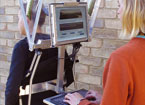
Collective Remorse
Ars Electronica, Hauptplatz :: September 1-5 2006 :: 10:00 am - 8:00 pm :: Regrets--by Graham Budgett and Jane Mulfinger (US)-- are often the conceptual vehicle of self-improving tendencies, but they are rarely communally active in any meaningful way. The Regrets team seeks to intervene and enable such interaction. In particular, remorse is posited here as a positive entity, incorporating recall, reflection, and learning.
Five custom mobile computer units roaming public space in and around a chosen city, community, or event, collect anonymously submitted regrets from the public, gathering and comparing them to comprise a sociological database of contemporary regret. Instant feedback to the individual user based on other contributors' similar concerns is algorithmically generated to 'share the burden'. Random selections of the regrets are made public via locally negotiated sites and existing signage, network, and broadcast facilities. The archive represents a glimpse of a given community at a particular time through the rubric of regret; its results available for future studies.
Posted by jo at 04:30 PM | Comments (0)
Free Press

Call for Participation
This summer and fall you are invited to contribute to the creation of an open-access publishing house, a Free Press, to be launched at Röda Sten contemporary art center in Göteborg, Sweden. A project of artist Sal Randolph, Free Press will accept all kinds of writing from the public; contributions in any language can be as short as a single word or as long as an encyclopedia and can include manifestos, statements, documentations, studies, stories, recipes, poems and whatever you can imagine.
"Even in the age of the internet, book publishing is a walled garden where editors and commercial interests filter out most of what is written," says Randolph. "To publish is to 'make public,' and the published materials of the world create their own kind of public space, a city of books where readers and writers are citizens. Free Press aims to open up access to that public space. Like any city, Free Press is bound to include both ugliness and beauty, though the definitions of each will certainly differ."
All participating manuscripts will be published as printed books in the Free Press series, available in the project's library and reading room at Röda Sten, where events and discussions will also take place. Additional copies will be placed on shelves in local bookstores and libraries. Readers will be able to download copies from the website and order them at cost from an internet book printer.
Free Press builds on several earlier projects by the artist -- in particular, Free Words, where 3000 copies of a free book were infiltrated onto the shelves of bookstores and libraries by a worldwide network of volunteers, Opsound, a gift economy of music, and Free Biennial / Free Manifesta, in which the form of an art biennale was appropriated and re-imagined to create large open-participation exhibitions of free art in the public spaces of New York and Frankfurt am Main, Germany. In her work, Randolph explores the effects of gifts and gift-economies in the creation of social architectures.
The Free Press exhibition will take place from September 17 - October 20, 2006 at Röda Sten.
Free Press: Call for Participation :: Free Press is looking for writing of all kinds - any language, any style, genre or subject matter, experimental or traditional, unpublished or previously published.
Manifestos, artists statements and conceptual/experimental texts are especially welcomed, as well as writing about gifts and gift economies, open systems, freedom of expression, censorship, surveillance, intellectual property, the commons & the public domain, anarchy, cooperation, political philosophy, alternative economies, public space, urbanism, situationism & psychogeography, conceptual, performance, and participatory art, graffiti and street art, distributed creativity, social software, virtual worlds, open source, happenings, the 1960s, the future, utopian and postutopian visions.
All material included in the Free Press project will be released under Creative Commons licenses which will allow the texts to be printed and freely shared.
Deadlines: Texts will be accepted through the Free Press website starting August 1, 2006 continuing through the end of the exhibition on October 20. However, if you wish your text to appear in the gallery, please allow for publication time (2-4 weeks) and send it as soon as possible, certainly before the end of September. If you want your book to be there at the opening (September 17), send your text now!
For guidelines and more information please visit: http://freewords.org/freepress/you/info/help
About Röda Sten
Röda Sten is a cultural center in Göteborg, Sweden. Röda Sten is also a cultural landmark which lies on the sea entrance to the city and is a popular port of call for many who take a stroll on the banks of the harbour. Once housing the huge industrial boiler, Röda Sten today is an exeptional centre of the arts. It entices and fascinates with i's enormous dynamic space and opportunity to work large scale. The outside of the building is a zone for the graffiti artists of the city while within the building remnants of past graffiti is preserved. This unconventional exhibition space sets the scene for daring, ground breaking explorations.
Posted by jo at 03:42 PM | Comments (0)
August 04, 2006
SKIN-PÔ

Artistically Sensitive Ecosystems
The SKIN-PÔ project--by Mark Fournel--seeks to bring the creative process into the public forum and allow citizens to reclaim their community spaces through technological works of art that spur spontaneous creation. The artist offers an interactive environment within an urban space, such as a public square. Passers-by are able to interact with the work's audio and visual components via wireless interfaces that control video projections on surrounding buildings and create and distribute sound in the venue. SKIN-PÔ challenges urban structures, disputes their composition and reconstructs them where they stand. We are impelled to scrutinize and confront the urban reality imposed upon us, the conventions that rule it, and the acceptance of these conventions by the key stakeholders of our urban spaces, the passers-by.
With SKIN-PÔ, Fournel reaches out to passers-by and strives to change how they look at their surroundings. He destabilizes them and in doing so forces them to call into question what they have previously accepted as fact. The project seeks to create distance — both critical and playful — between us and our role as urban players. In this vacuum between reality and fiction, the artist creates a type of "escape," which he sees as essential if we are to truly explore our rapport with the urban space around us.
This void fascinates him, as it represents a respite that allows us to relax, take a deep breath, and reconnect with our imagination.
The project incorporates the implementation and use of a highly accurate, quick response, spatial positioning system and a number of video and audio control software applications and modules. SKIN-PÔ promotes an open source philosophy, with all of the modules, tools and software developed for the project made available to the community.
SKIN-PÔ is the second phase of the Transduction project, a body of research and production work begun in 2000 that explores and confronts the various methods we use to take ownership of our architectural space and the integration of these methods into the construction of "artistically sensitive ecosystems." SKIN-PÔ evolved directly from the Tontauben installation, the first phase of the Transduction project. [J.P. © 2006 FDL]
Posted by jo at 12:56 PM | Comments (0)
July 31, 2006
Oribotics
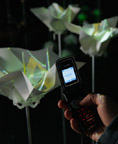
Folding and Unfolding on Command
Oribotics--by Matthew Gardiner--is the fusion of origami and technology, specifically 'bot' technology, such as robots, or intelligent computer agents known as bots. The system was designed to create an intimate connection between the audience and the bots; a cross between gardening, messaging a friend, and commanding a robot. It was developed during an Australian Network for Artists and Technology (ANAT) artists lab; achieved with Processing as an authoring tool, and connected a mobile phone via a USB cable.
"Ori-botics is a joining of two complex fields of study. Ori comes from the Japanese verb Oru literally meaning 'to fold'. Origami the Japanese word for paper folding, comes from the same root. Oribotics is origami that is controlled by robot technology; paper that will fold and unfold on command.
An Oribot by definition is a folding bot. By this definition, anything that uses robotics/botics and folding together is an oribot. This includes some industrial applications already in existance, such as Miura's folds taken to space, and also includes my two latest works. Orimattic, and Oribotics." [via textually.org]
Posted by jo at 06:10 PM | Comments (0)
ArtCamp: The Un-Conference

NO SPECTATORS, ONLY PARTICIPANTS
ArtCamp is the World's First un-Conference on Art. We are calling it an un-conference, but you can also think of it as a BarCamp about Art, a gathering that uses Open Space Technology, an Open-Source Conference, or just as an opportunity to get together during the New Forms Festival in Vancouver on September 21, 2006 to meet, greet, learn, collaborate, mashup, and share practices and ideas about art, media, networks and technology.
NO SPECTATORS, ONLY PARTICIPANTS :: It is an intense event with discussions, demos and interaction from attendees. Anyone with something to contribute or with the desire to learn is welcome and invited to join. hen you come, be prepared to share with artcampers. When you leave, be prepared to share it with the world. Attendees must give a demo, a session, or help with one, or otherwise volunteer / contribute in some way to support the event. All presentations are scheduled the day they happen. Prepare in advance, but come early to get a slot on the wall. The people who are present at the event will select the demos or presentations they want to see. ArtCamp is free and open to everyone but you must sign up on the Wiki.
ArtCamp is co-presented by Upgrade! Vancouver and the New Forms Festival. For more information email Kate Armstrong kate[at]katearmstrong.com
Posted by jo at 12:51 PM | Comments (0)
July 26, 2006
Anne Galloway
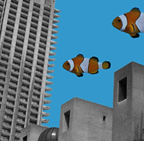
Technosocial Screens
I'll be giving a keynote address at next month's BNMI Interactive Screen - Margins: Media: Migrations workshop & summit.
Technosocial Screens: Mobilities, Communities, Citizenships: screen, v. to show, or hide from view; to sift or separate; to shelter or protect
New interactive technologies promise to reconfigure relations between producers and consumers, public and private, physical and digital, local and global - and in these shifting scenarios the screen takes on a multitude of roles. Not only are screens changing size and resolution, some are becoming softer and more flexible, and others are disappearing entirely. Some screens offer a bird's-eye view of the world that we can hold in our hands, and others tell us where we are - or could be - at any given moment. Whatever the type of screen, we can be sure of one thing: people, places, objects and ideas are being screened at the same time.
Together we will explore some of the critical ways in which new media technologies shape, and are shaped by, our changing experiences and understandings of community and citizenship. What kind of shelter and hope can we expect from a world of everywhere and anywhere media? From what, and whom, are we protecting ourselves? How are these technological practices sorting our everyday social, cultural and creative relationships? What, and whom, gets hidden - or cannot hide? How can new media technologies explore different ways of belonging and being together? How can they encourage diverse and lively participation and representation around shared matters of concern?" [...] [blogged by Anne on Purse Lips Square Jaw]
Posted by jo at 05:42 PM | Comments (0)
July 25, 2006
Stratoself

Short-Circuit Between Physical + Virtual Worlds
Stratoself is an interactive sky-art work that was conceived on a short-circuit between physical and virtual worlds. It has been designed by that hybridism: there’s a missing link between internet and helium gas we wanted look for. For such opposite environments we needed a flexible, self-generated, autonomous bridge. Cybercommunities were the best choice.
The idea is to release helium-filled balloons carrying participants' personal email cards inside, in the air. The participant's balloon can be ordered at the project's site and NAUTC.0, (we're group of electronic artists from São Paulo, Brazil) is in charge of assembling the entered data with the biodegradable latex balloons, and releasing them in the air of big cities of Latin America. Anyone who gets or finds a balloon can communicate with the participant via email.
The project aims to find non-conventional means of netting cybercommunities's individuals from all over the world, by temporarily colonizing urban common spaces with private material. To launch that personal electronic piece of data in physical public sites, is a way to discuss how social identity and digital territory is built in the creative boundaries of cybercommunities.
People who want to order their personal balloon and participate in Stratoself's first performance in August 14th, can register at:
http://www.stratoself.com/english.htm
Posted by jo at 09:06 AM | Comments (0)
July 23, 2006
Theory of Participatory Art
![]()
participation as activism
Suzana Milevska’s essay Participatory Art: A Paradigm Shift from Objects to Subjects in the 2/06 issue of the journal springerin is a dense, theoretical discourse that raises questions regarding the intersubjectivity of the collective and challenges to the idealization and realization of "community" in participatory art.
springerin is a quarterly magazine dedicated to the theory and critique of contemporary art and culture addressing a public that perceives cultural phenomena as socially and politically determined. A special section of every issue (Netzteil) examines the potentials of new technologies and media.
Posted by michelle at 02:46 PM | Comments (0)

